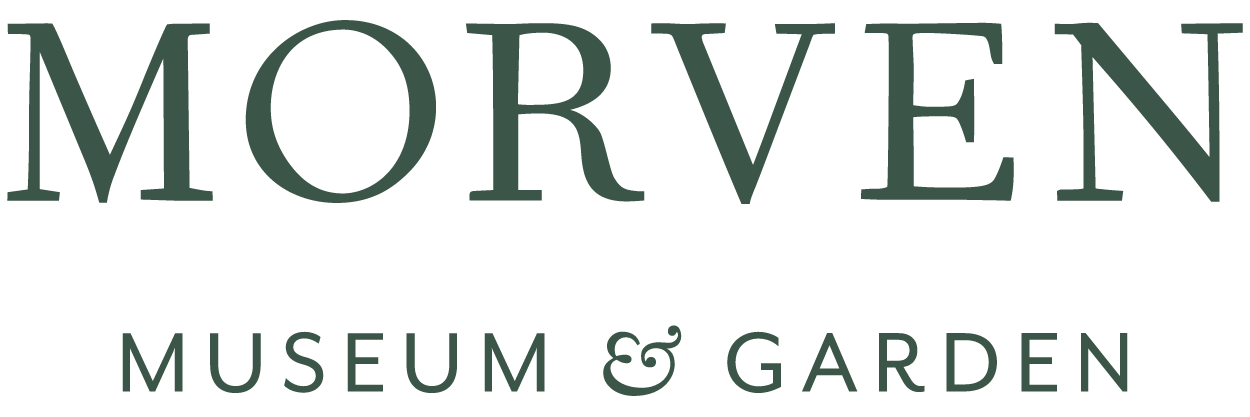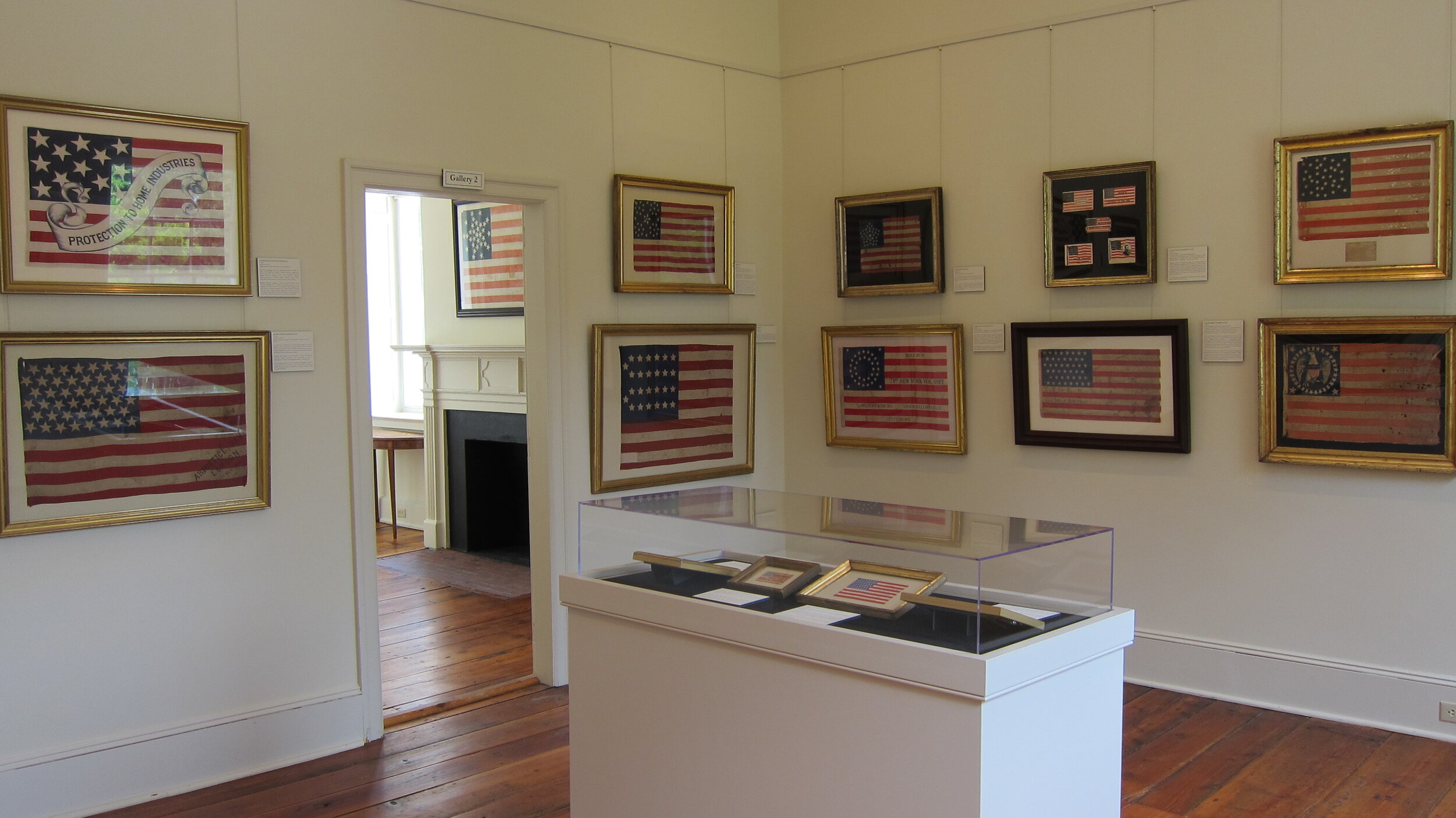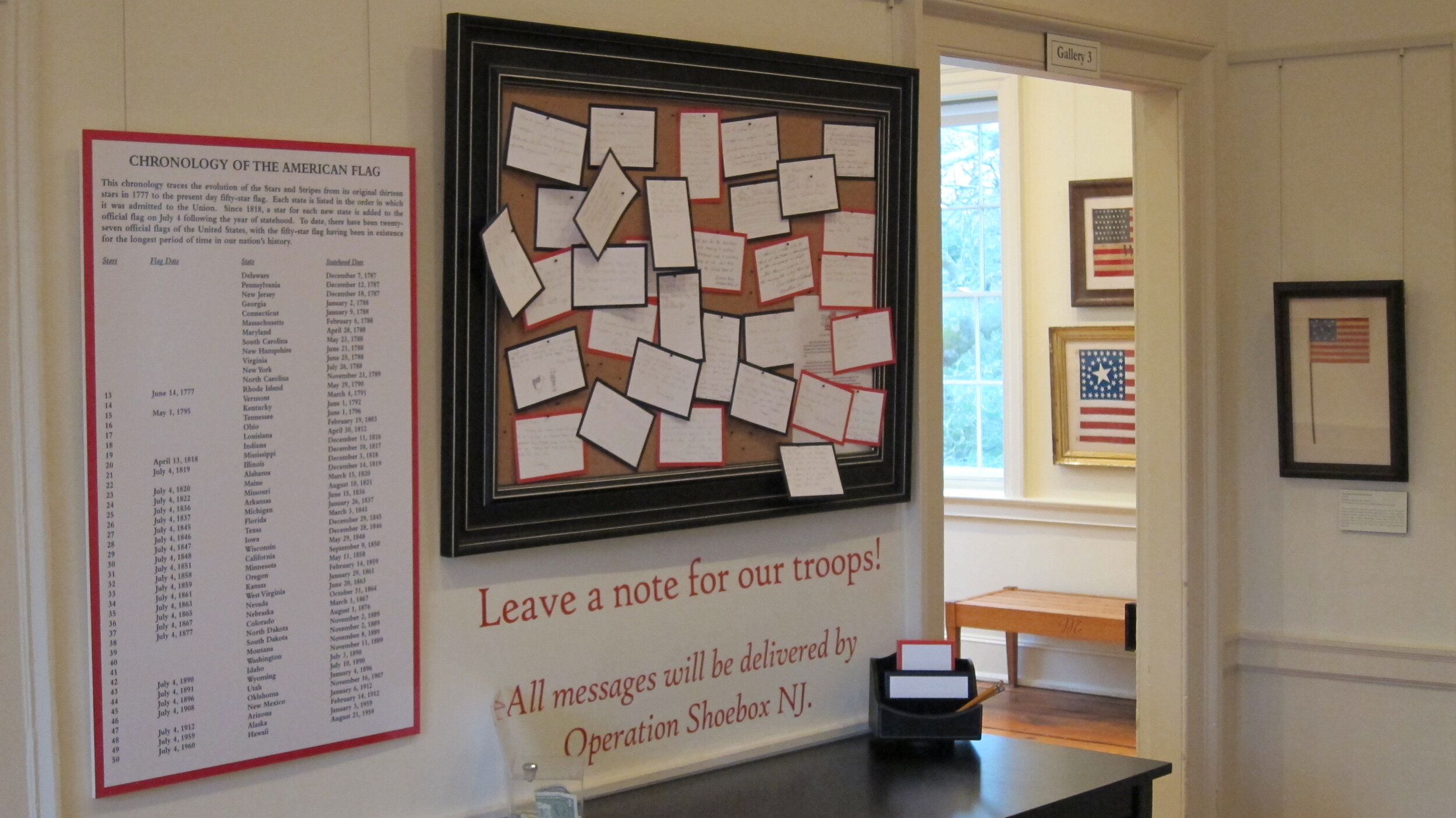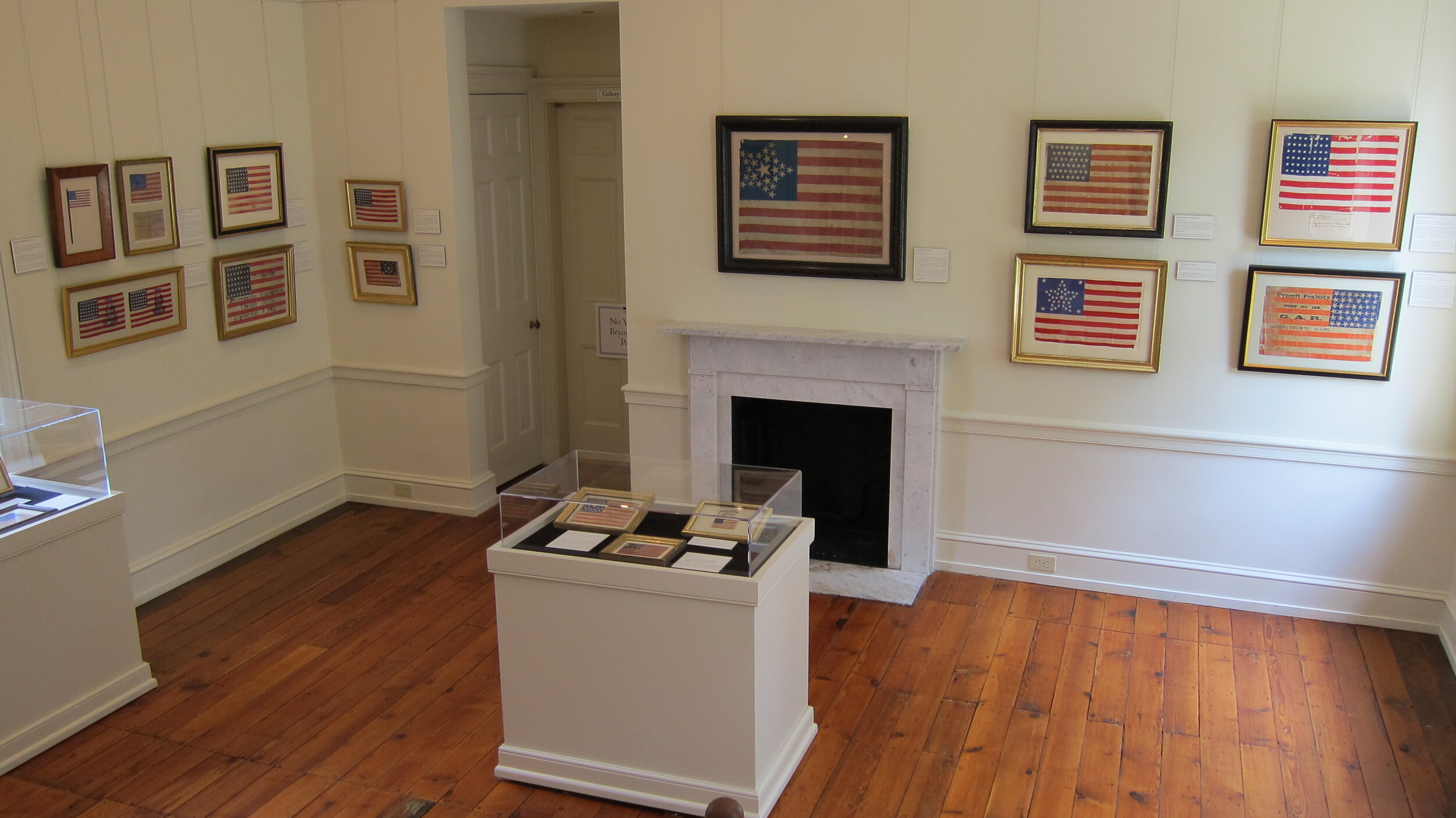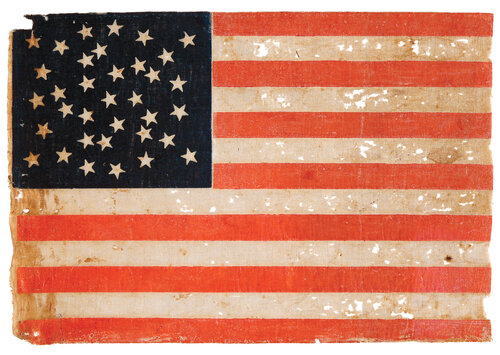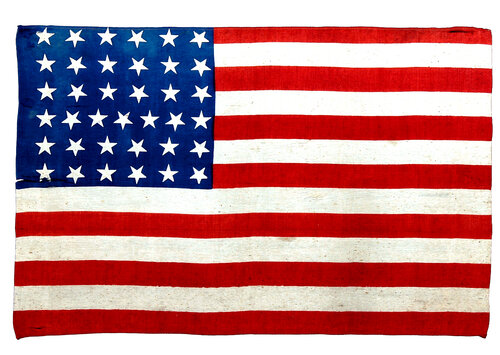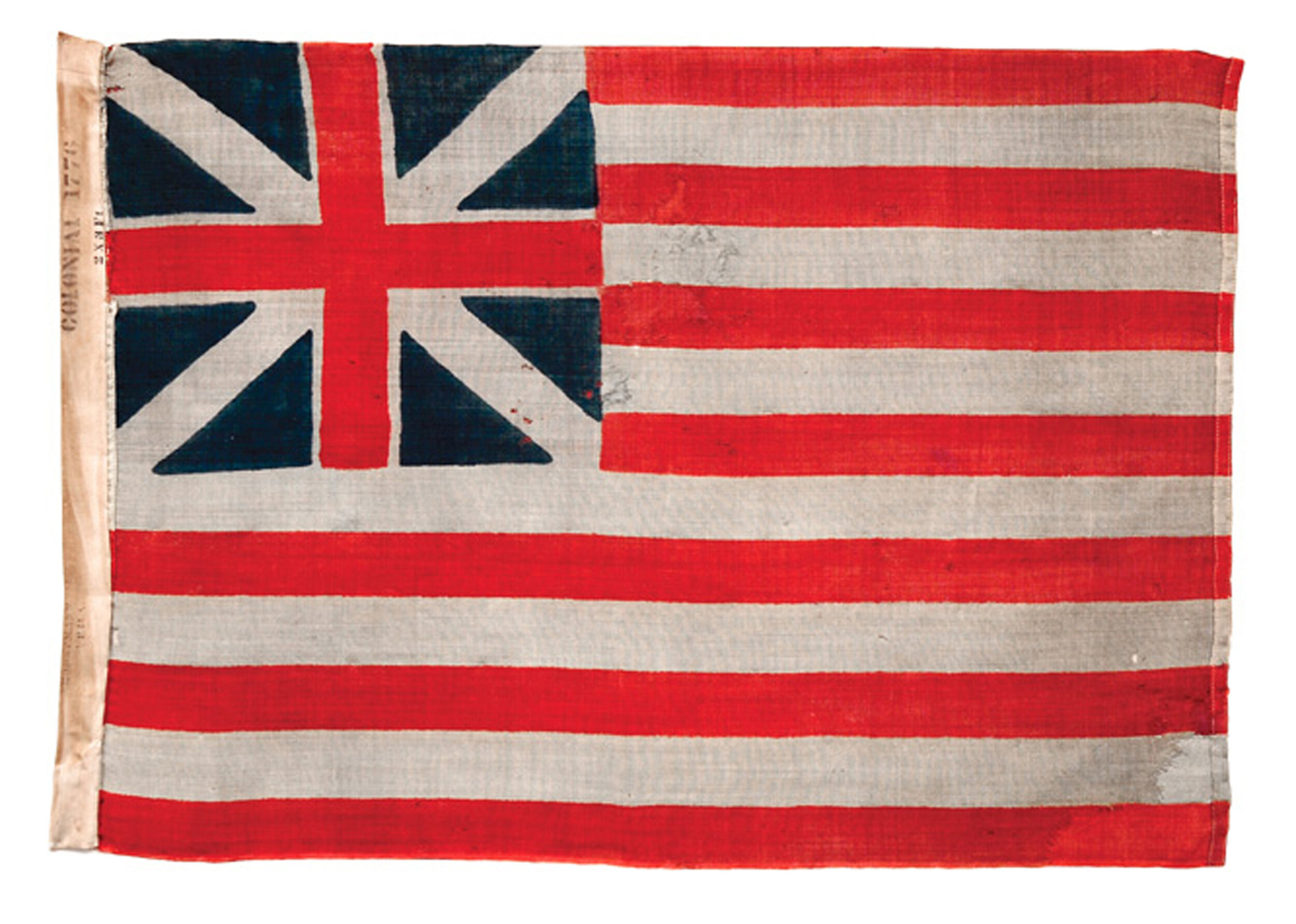
The Stars and Stripes: Fabric of the American Spirit
The Stars and Stripes: Fabric of the American Spirit™
This exhibition was on view from July 1, 2011 – January 8, 2012
Morven Museum & Garden is proud to present the online exhibition of The Stars and Stripes: Fabric of the American Spirit™ from The Pierce Collection of American Parade Flags. Click through to learn the history of each of these unique flags.
Object photography by Michael Fredericks.
Special thanks to Aliza Alperin-Sheriff for compiling images and text for this online exhibition.
GRAND UNION FLAG

c. 1876
Printed on wool.
Inscription in selvage: Horstmann Phila. Colonial 1776 2 x 3 Ft
The Continental Army was reorganized on January 1, 1776, under the command of General George Washington, and on that day, Washington ordered the hoisting of the Grand Union flag above his camp at Prospect Hill, just outside of Boston, as a tribute to the united colonies.
Also known as the “Continental Colors,” the flag featured joined crosses of St. George and St. Andrew in the canton. The Grand Union, predecessor to the Stars and Stripes, was flown on several ships during the period 1776-77 and was the first American flag to be recognized by a foreign country.
This reproduction Grand Union flag was likely made at the time of the centennial by Horstmann Brothers of Philadelphia, one of the largest military goods manufacturers in America.
24-STAR FLAG
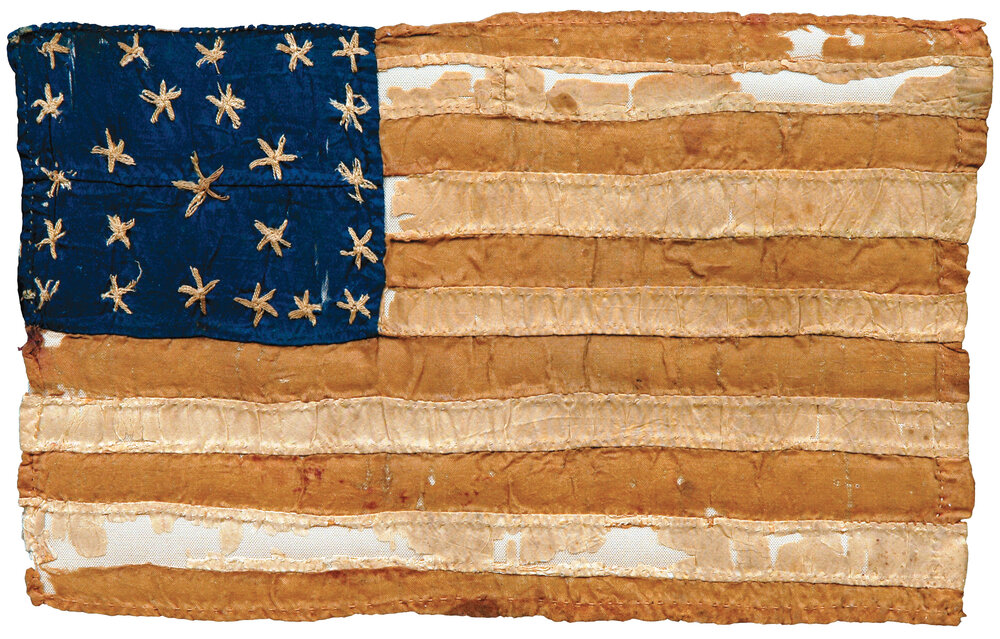
c. 1822-36
Hand-sewn silk stripes and embroidered stars.
Outer square pattern surrounding small wreath with central star.
The twenty-four star flag is associated with the origin of one of our flag’s most beloved nicknames.
In 1831, on his twenty-first birthday, Captain William Driver from Salem, Massachusetts was given a handmade twenty-four star flag which he named “Old Glory.” He took the flag aboard his ship Charles Doggett and sailed twice around the world. Driver retired from the sea in 1837 and moved to Nashville where he proudly flew his flag. When Tennessee seceded from the Union, he was forced to hide his flag, but after Union soldiers re-captured Nashville, Driver climbed the State Capitol tower and raised the flag once again. In 1922, his daughter passed “Old Glory” on to President Warren G. Harding who in turn presented it to the Smithsonian Institution.
13-STAR FLAG

c. 1876
Printed on glazed cotton muslin.
Wreath pattern with central star, flanked by star in each corner.
The centennial was a period of national celebration, with the flag as the primary symbol of American idealism and pride. It was a time when flag designers created a variety of star patterns, the most popular of which was the single wreath configuration. Parade flags of this size were generally made to wave at a parade or special event and then to be discarded, and it is for this reason that only a small number has survived.
38-STAR HENDRICKS 1884 CAMPAIGN FLAG
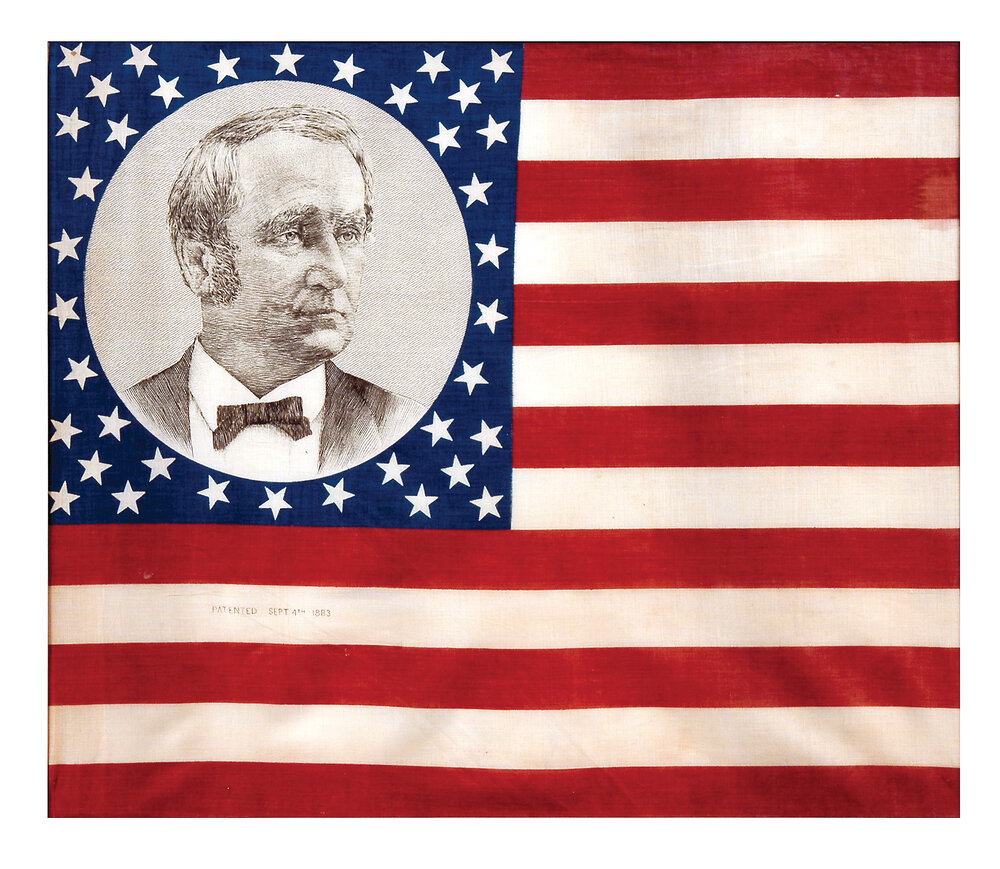
c. 1884
Printed on cotton.
Image of Thomas Hendricks surrounded by wreath pattern, flanked by four stars in each corner.
Legend printed on white stripe below canton: Patented Sept. 4, 1883
Thomas Hendricks was the running mate of presidential nominee Samuel Tilden in the Election of 1876, one of the most controversial in American history. Tilden won the popular vote, but a dispute over the Electoral College votes in Florida, South Carolina and Louisiana resulted in the formation of a bipartisan commission, which by a straight party-line vote awarded the contested electoral votes to Rutherford B. Hayes, electing him president. Grover Cleveland chose Hendricks as his running mate in 1884, and the two narrowly defeated James Blaine and John Logan. Vice President Hendricks died in November 1885 after serving only nine months in office.
46-STAR WISH YOU WELL FLAG
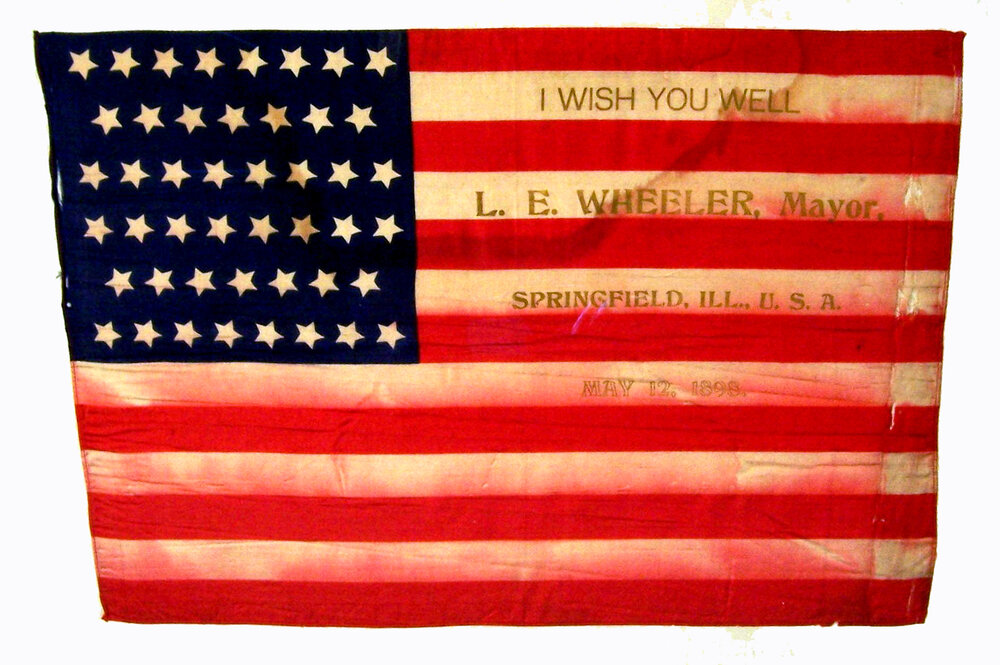
c. 1898
Printed on silk.
Stamped gold overprint: I Wish You Well L.E. Wheeler, Mayor, Springfield, Ill., U.S.A./May 12, 1898
This flag was originated by Springfield Mayor Loren Wheeler as a farewell tribute and expression of good wishes to the 6th Illinois National Guard Regiment mustered into federal service on May 11, 1898 as the 6th Illinois Volunteer Infantry.
The unit was assigned to the Second Army Corps and ordered to embark for Cuba. While enroute, the Spanish troops around Santiago surrendered ending fighting in that area. The regiment was redirected to Puerto Rico where it participated in several small skirmishes before marching to Ponce, Guaragnos and Adjuntas. After an armistice was reached between Spain and the United States, the regiment returned to Springfield and officially mustered out on November 25, 1898. During its term of service, the 6th Illinois lost two officers and 22 enlisted men to disease.
Loren Edgar Wheeler was born October 7, 1862 in Havana, Illinois. In 1880, he moved to Springfield where he began a career in advertising. He served as an alderman, mayor and later became postmaster. Wheeler served five terms in Congress, two as chairman of the Committee on Railways and Canals. Afterward, he returned to Springfield and continued his former business activities until his death on January 8, 1932.
48-STAR IMMIGRANTS FLAG
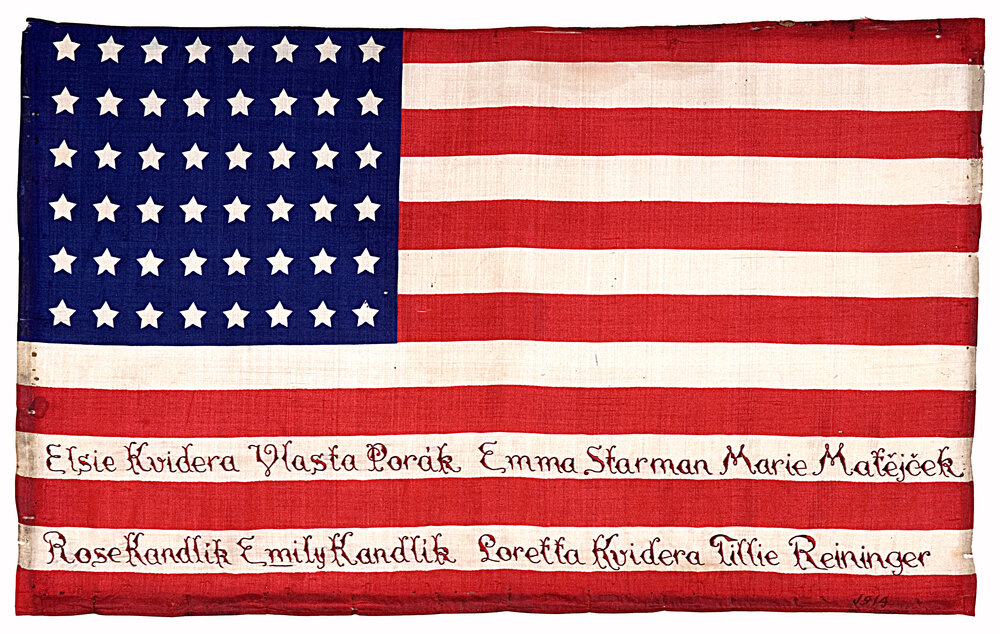
c. 1914
Printed on silk.
This flag with names artistically embroidered on the bottom white stripes commemorates the naturalization of eight Eastern European women as United States citizens: Elsie Kuidera, Vlasta Porak, Emma Starman, Marie Matejcek, Rose Kandilik, Emily Kandilik, Loretta Kuidera, Tillie Reininger
The year “1914” is embroidered on the lower right corner of the flag.
Accompanying the flag is a fragment of its original frame’s chipboard backing on which is inscribed in pencil: “To Miss Libuse Hajeck, July 5 1914.” This date likely coincides with the day after citizenship was attained since traditionally naturalization ceremonies were conducted on the Fourth of July. Perhaps the group of women presented the flag to Miss Hajeck as a token of their friendship or in appreciation for helping them become citizens.
38-STAR 1776/1876 CENTENNIAL FLAG

c. 1876
Printed on wool and cotton blend.
Stars are embellished with a thin line between each point to create a glimmering effect and are configured to form the years “1776” (composed of thirty-eight stars) and “1876.”
A masterpiece in design, this is one of several commemorative flags specially produced for America’s centennial celebration.
45-STAR MONTIE CONNELL FLAG
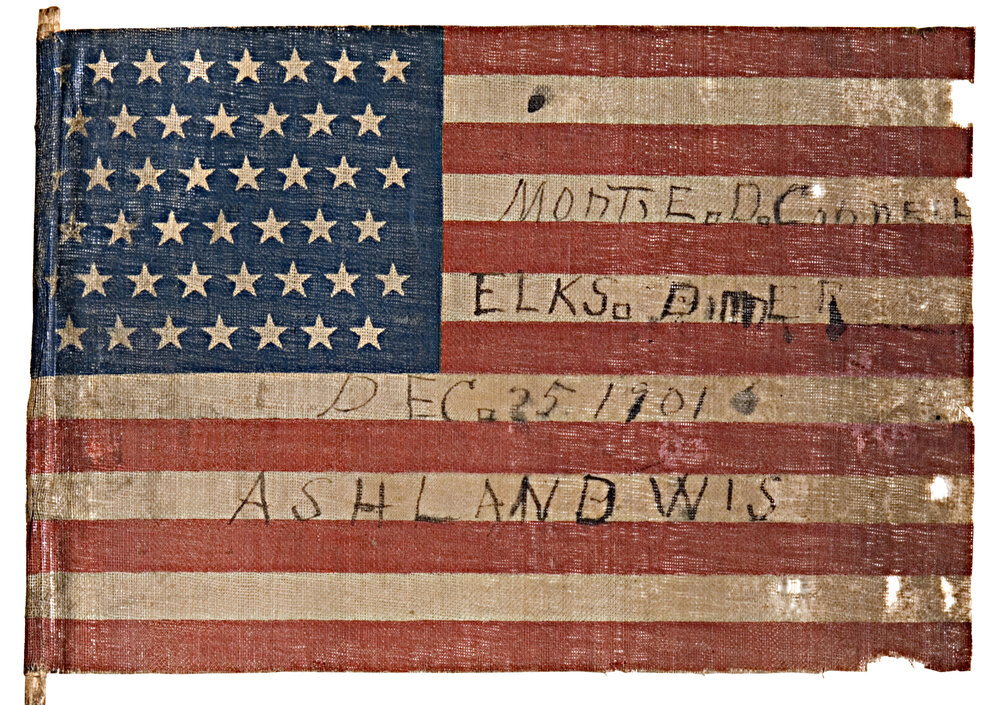
c. 1901
Printed on cotton.
Inscription: Montie D. Connell Elks Dinner Dec. 25, 1901 Ashland Wis
Chartered in Wisconsin in 1899, the Ashland Elks Lodge #137, Benevolent and Protective Order of Elks, purchased the local golf course in 1944. Meetings and social activities were conducted at the Elks Lodge in the town of Ashland during winter months and at the clubhouse during months the golf course was open. During 1966-67, the lodge sold its downtown building and constructed a new clubhouse. With the involvement of Elks members, city officials and area economic developers, the original golf course was redesigned and expanded into an 18-hole championship course open to the general public in 1999. Two years later the course was renamed Chequamegon Bay Golf Club.
This flag commemorates a Christmas dinner held in 1901, two years after the lodge received its charter.
44-STAR SUNDAY SCHOOL FLAG
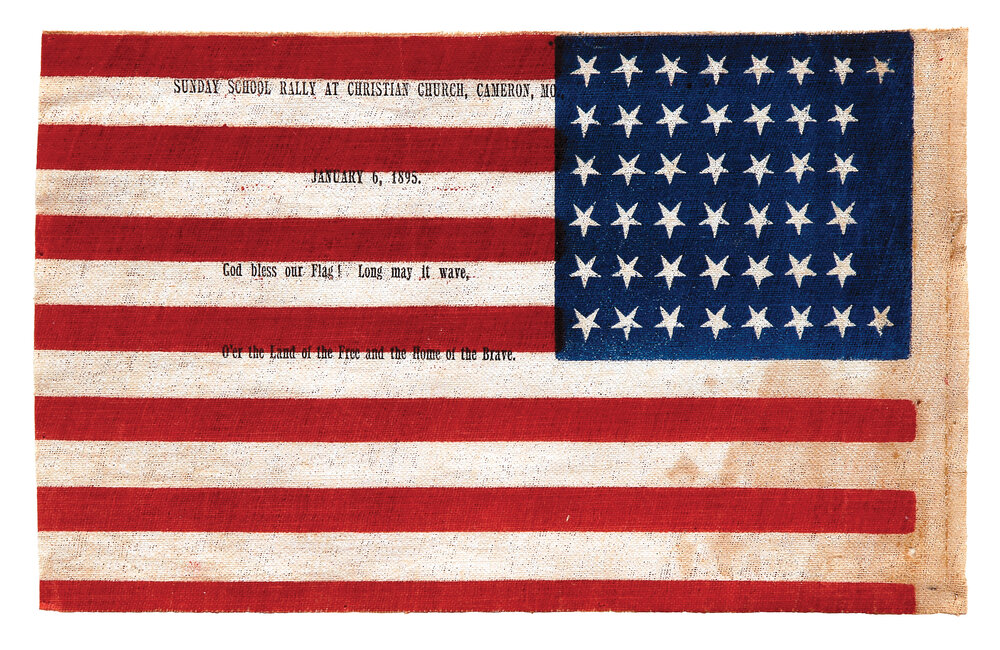
c. 1895
Printed on glazed cotton muslin.
Notched pattern.
Typewritten inscription: Sunday School Rally At Christian Church, Cameron, Mo January 6, 1895. God Bless Our Flag! Long May It Wave. O’er The Land Of The Free And The Home Of The Brave.
Rally Day traditionally celebrates the annual enrollment of children, youth and adults in Sunday School classes and promotes the involvement of members of the congregation in other church activities.
This flag was used in a unique way to announce the commencement of Sunday School instruction and at the same time to pay homage to the Stars and Stripes.
46-STAR ADMIRAL DEWEY FLAG
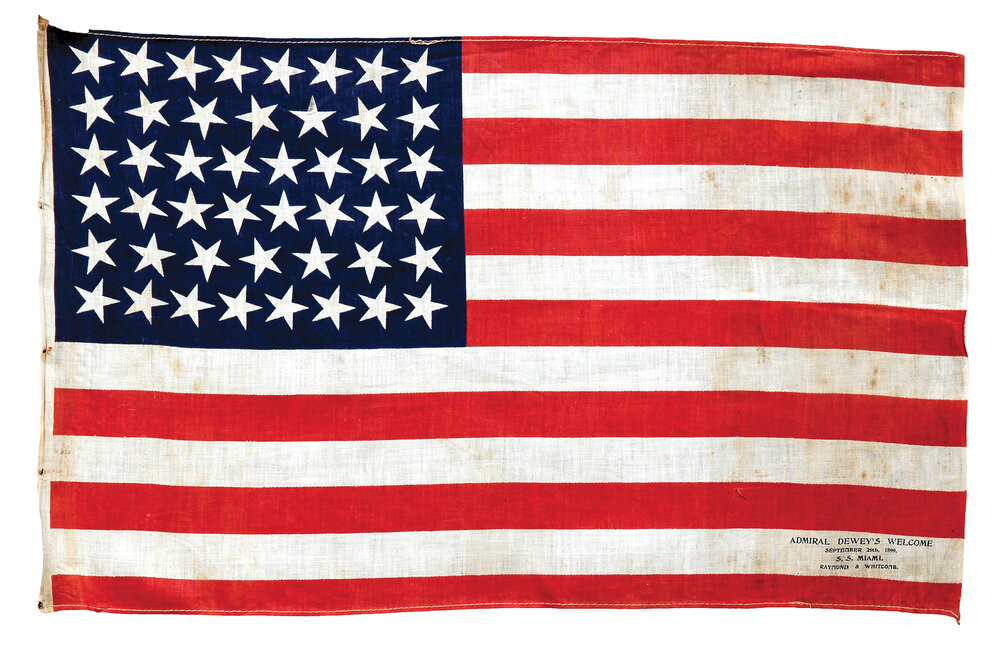
c. 1899
Printed on cotton.
Inscription: Admiral Dewey’s Welcome September 29th 1899/S.S. Miami Raymond & Whitcomb
George Dewey graduated from the Naval Academy in 1858 and served under Admiral Farragut during the Civil War. He rose to the rank of Commodore in Command of the Asiatic Squadron a few weeks before the start of the Spanish-American War, and on April 27, 1898 sailed on the flagship U.S. Olympia with orders to attack the Spanish at Manila Bay. Within six hours on May 1, he sunk or captured the entire Spanish Pacific Fleet without the loss of a single American life. News of the victory made Dewey a national hero, and in March 1899, he was appointed Admiral of the Navy.
On September 27, 1899, Dewey returned to New York harbor for two celebrations: the naval parade on September 29 and the land parade on September 30. The events were filmed by the Edison Manufacturing Co. This flag is a souvenir from the cruise ship S.S. Miami, among the hundreds of ships in New York harbor that day taking part in the Dewey naval parade. The ship was owned and operated by the Raymond & Whitcomb Cruise Line, headquartered in Boston.
48-STAR GOLD STAR MOTHERS FLAG

c. 1928-59
Printed on silk.
Circular decal inscribed: Presented to the Gold Star Mothers By the City of New York
On June 4, 1928, a group of twenty-five women, led by Mrs. Grace Darling Seibold, met in Washington, DC to establish a national organization known as the American Gold Star Mothers. Named after the Gold Star that families would hang in their window in honor of a deceased veteran, membership was comprised of mothers who lost a son or daughter during World War I. The organization became a rallying point and support group of grieving mothers who would comfort each other and give loving care to veterans confined to government hospitals. Today there are more than two hundred chapters, with membership open to mothers who have lost a son or daughter during any of America’s past wars and armed conflicts, or while in the service of the United States military.
This special flag was presented to Gold Star Mothers in New York City as an expression of heartfelt appreciation and symbol honoring their loss. When rolled up on its staff, the flag slips into the brass-tipped wooden tube for storage.
38-STAR 12th NEW HAMPSHIRE REUNION FLAG
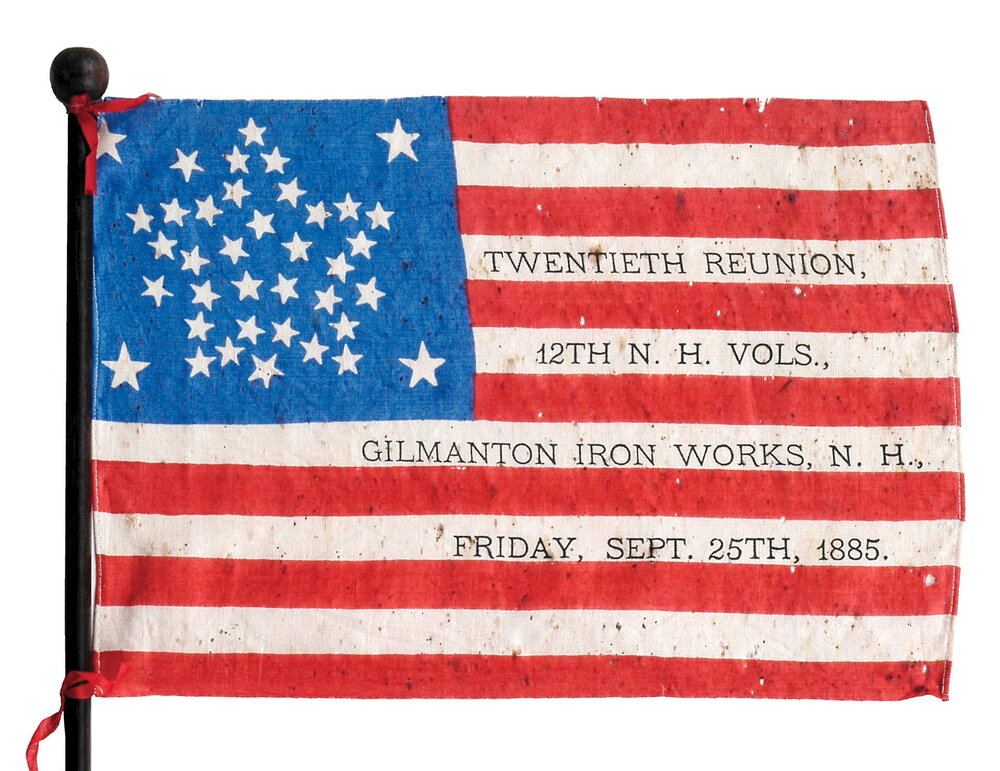
c. 1885
Printed on silk.
Great Star pattern with four outlying stars, flanked by star in each corner.
Original staff with red ribbon ties.
Overprint: Twentieth Reunion, 12th N. H. Vols., Gilmanton Iron/Works, N. H., Friday, Sept 25th, 1885.
The 12th New Hampshire Volunteer Infantry Regiment, known as “The Mountaineers,” organized in September 1862 at Concord and mustered out in June 1865. The unit was initially attached to Casey’s Division in the defense of Washington and later assigned to the Army of the Potomac. During its three-year tour of duty, the regiment was involved in a number of campaigns, including Gettysburg, Fredericksburg, and Chancellorsville where it suffered its highest number of casualties.
This souvenir flag commemorates the regiment’s twentieth Civil War reunion held in the town of Gilmanton Iron Works, New Hampshire in 1885.
13-STAR HALO FLAG
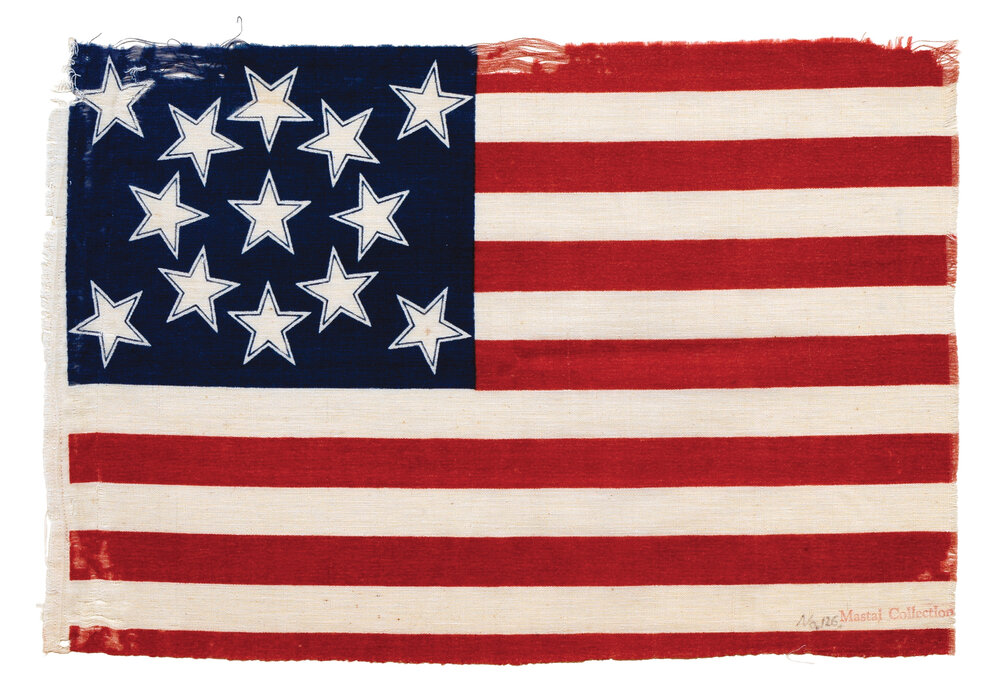
c. 1876
Printed on cotton.
Haloed stars in wreath pattern with central star, flanked by star in each corner.
The haloed stars pay tribute to the original thirteen states. One of a number of innovative designs that flourished during the centennial period.
34-STAR GREAT STAR FLAG
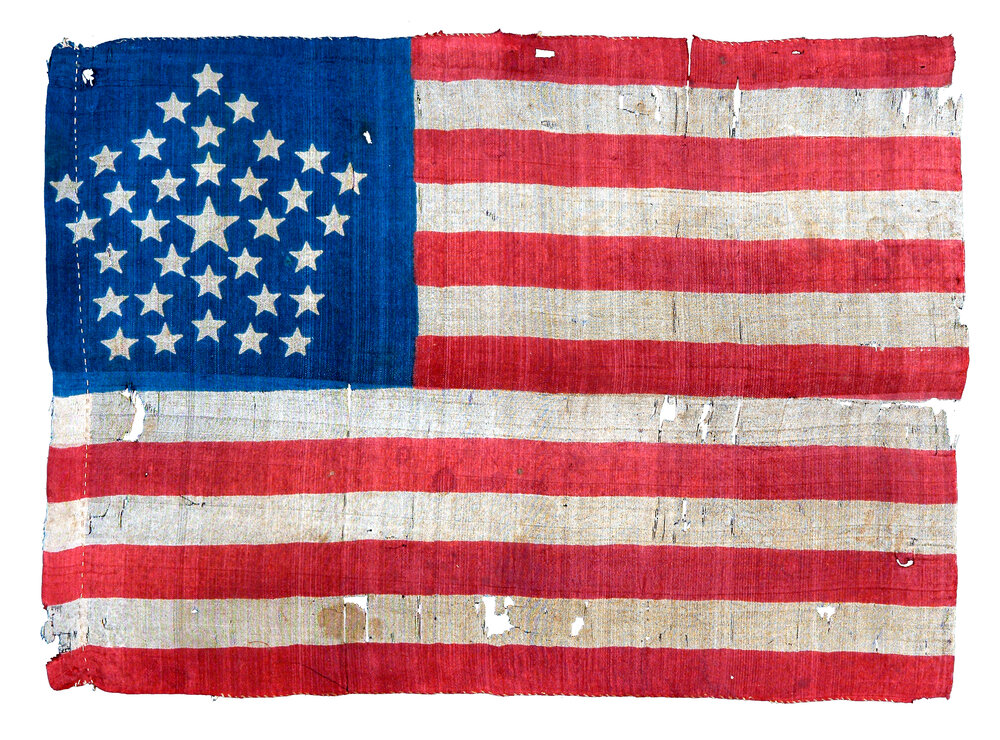
c. 1861-63
Printed on silk.
Transition from Great Star to pentagon pattern.
The thirty-four star flag became official shortly after seven southern states seceded from the Union, however President Lincoln refused to allow the elimination of any stars when the new flag was created.
On the way to his inauguration in February 1861, President-elect Lincoln attended a ceremony in Philadelphia honoring the birthday of George Washington. He used the occasion to raise a thirty-four star flag over Independence Hall in a courageous act of faith and a bold gesture of national unity.
35-STAR 71st NEW YORK VOLUNTEERS FLAG
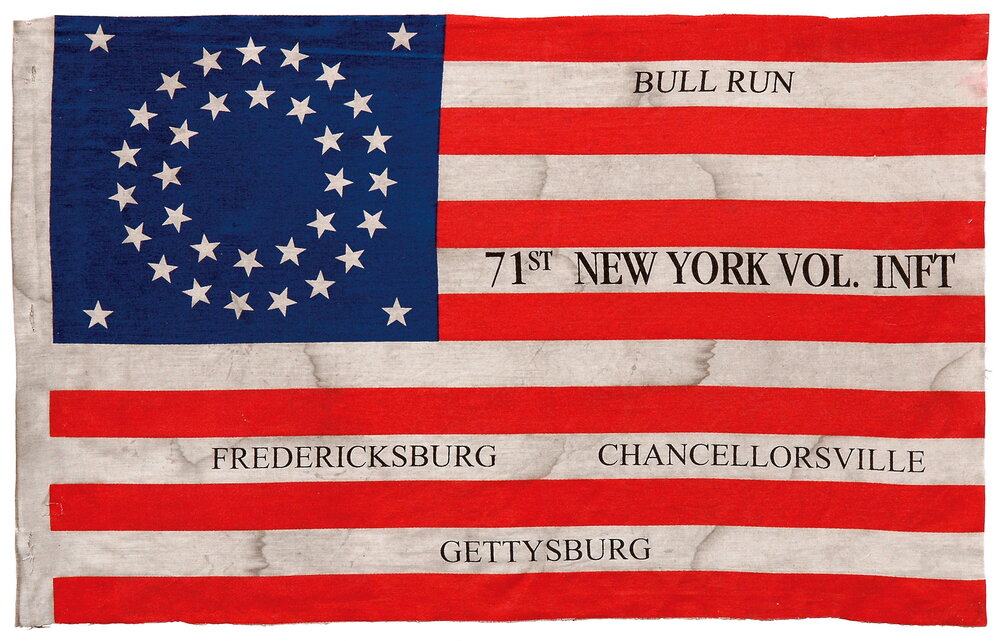
c. 1865
Printed on cotton.
Double medallion pattern, flanked by star in each corner.
Overprint commemorates Civil War battles: Bull Run Fredericksburg Chancellorsville Gettysburg
The 71st New York Volunteer Infantry organized at Camp Scott, Staten Island in June 1861 and mustered out in July 1864. The regiment was assigned to the 2nd Excelsior Brigade under the command of General Daniel Sickle and saw extensive battle action in Pennsylvania and Virginia as evidenced by the inscription of battle honors printed on the stripes of the flag. Sickle was awarded the Medal of Honor for his gallantry during the Battle of Gettysburg.
Most likely this flag was produced near the end of the Civil War for use at reunions or encampments. Its unique star design is similar to the double medallion pattern found on cavalry guidons.
34-STAR LINCOLN MOURNING FLAG
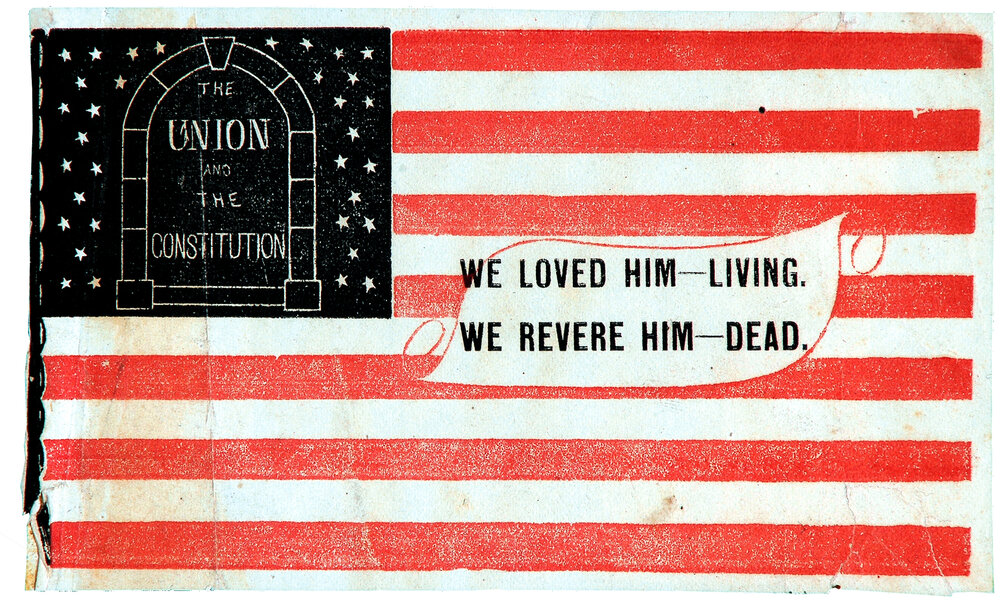
c. 1865
Printed on paper.
Scattered stars surrounding arch with phrase “The Union and the Constitution” set upon black canton.
Overprint: We Loved Him – Living We Revere Him – Dead
Our sixteenth president preserved the union when it seemed almost certain that it would not, or could not, survive. Abraham Lincoln would not allow the Confederacy to divide the country. His determination cost him his life, but it earned him the eternal gratitude of all Americans.
This rare surviving example is from a series of four or five paper mourning flags printed for onlookers to wave as Lincoln’s funeral train made its way from the nation’s capital to his final resting place in Illinois.
34-STAR LINCOLN MOURNING FLAG

c. 1865
Printed on paper.
Oval surrounding square of stars set upon black canton.
Overprint: God’s Illustrious Servant Faithful To The End
President Abraham Lincoln was shot by Confederate sympathizer John Wilkes Booth at Fords Theatre on April 14, 1865. Lincoln was carried to a nearby boarding house and remained unconscious until his death the following morning.
This rare surviving example is from a series of four or five paper mourning flags printed for onlookers to wave as Lincoln’s funeral train made its way from the nation’s capital to his final resting place in Illinois.
34-STAR LINCOLN MOURNING FLAG
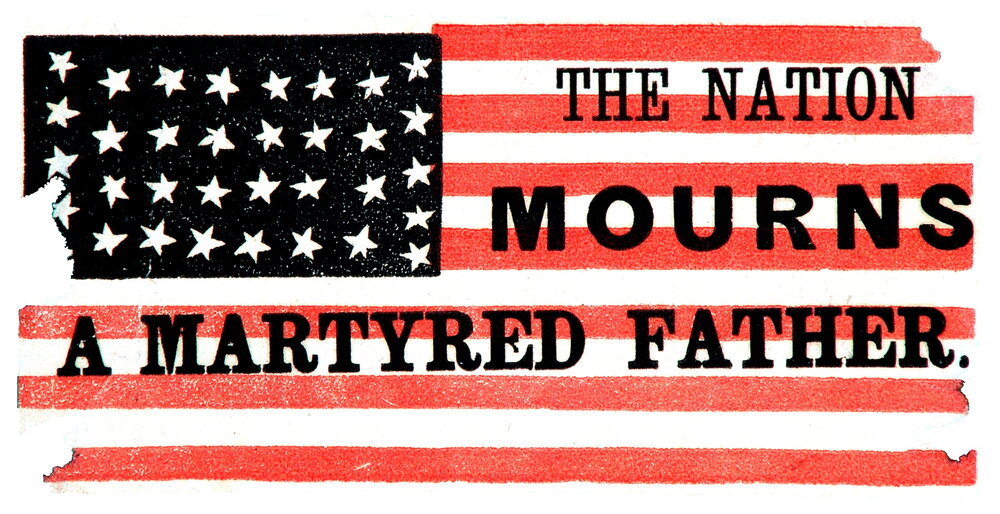
c. 1865
Printed on paper.
Two columns of stars enclosing square of stars set upon black canton.
Overprint: The Nation Mourns a Martyred Father
Abraham Lincoln stands alone as a man of honestly, courage and generosity. No man had a keener wit or kinder sense of humor. He mastered the art of story-telling and as an orator, was clear, sincere and natural. He never pretended to be more or less, or different, than he really was.
This rare surviving example is from a series of four or five paper mourning flags printed for onlookers to wave as Lincoln’s funeral train made its way from the nation’s capital to his final resting place in Illinois.
34-STAR LINCOLN MOURNING FLAG
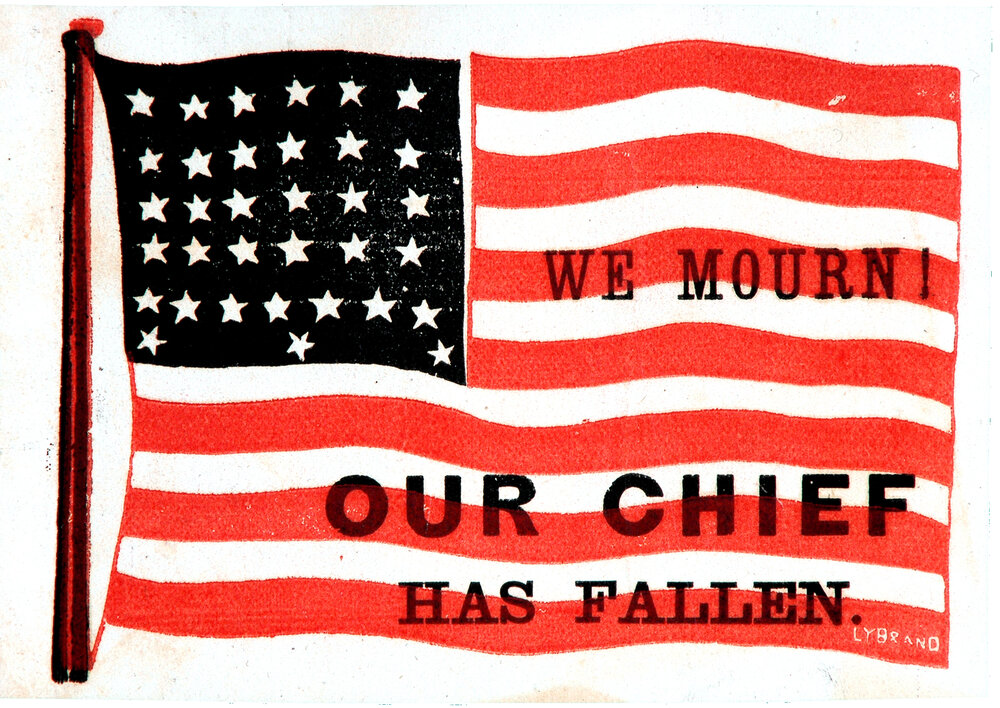
c. 1865
Printed on paper.
Uneven rows of stars set upon black canton.
Overprint: We Mourn! Our Chief Has Fallen
The assassination of the president plunged the nation into a period of deep mourning and transformed Lincoln into an American legend for his leadership during times of human crisis and for his pursuit of a more perfect and equal Union.
This rare surviving example is from a series of four or five paper mourning flags printed for onlookers to wave as Lincoln’s funeral train made its way from the nation’s capital to his final resting place in Illinois.
34-STAR LINCOLN MOURNING FLAG
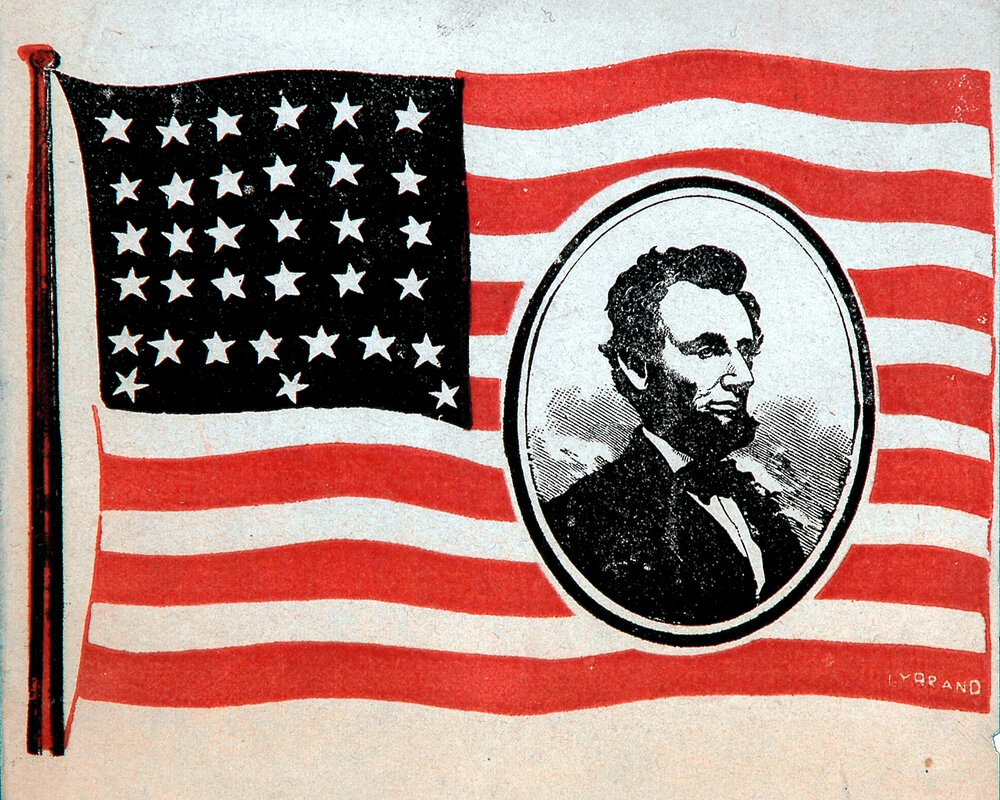
c. 1865
Printed on paper.
Uneven rows of stars set upon black canton.
Maker’s mark “Lybrand” printed on bottom red stripe.
Overprint: Portrait of Lincoln
It is the glory of Lincoln that during the Civil War he had almost absolute power, yet he never abused that power except on the side of mercy. “With malice toward none, with charity for all, with firmness in the right as God gives us to see the light,” Lincoln led America through its darkest days.
This rare surviving example is from a series of four or five paper mourning flags printed for onlookers to wave as Lincoln’s funeral train made its way from the nation’s capital to his final resting place in Illinois.
45-STAR ERNEST THOMPSON FLAG
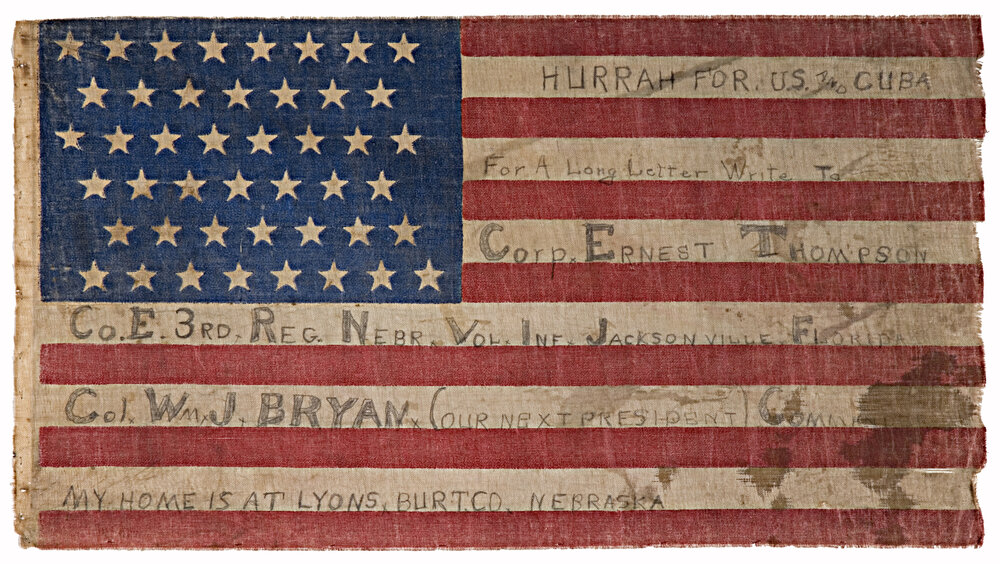
c. 1898
Printed on glazed cotton muslin.
Staggered pattern.
Inscription: Hurrah for U.S. and Cuba For a Long Letter Write to Corp. Ernest Thompson, Co. E. 3rd Reg. Nebra. Vol. Inf. Jacksonville, Florida, Col. Wm. J. Bryan (Our Next President) Commander. My Home Is At Lyon’s, Burt. Co. Nebraska.
The Third Nebraska volunteers mustered into active service in July 1898, less than a month before the Spanish-American War ended, with Colonel William Jennings Bryan as its commanding officer. Nicknamed the “Silver Regiment,” the unit was initially stationed at Camp Cuba Libre in Jacksonville, Florida. After the Treaty of Paris was signed, the regiment arrived in Cuba as part of the occupying force, serving there until April 1899 before returning to the United States. The unit mustered out of service one month later.
The inscription written on this flag by Ernest Thompson expresses his patriotism and great respect for his regimental commander William Jennings Bryan, a noted statesman and three-time candidate for the presidency. Also this soldier’s loneliness during a wartime situation is apparent from his touching appeal in which he promises to write a long letter back to those who correspond with him.
35-STAR RALLY ROUND FLAG
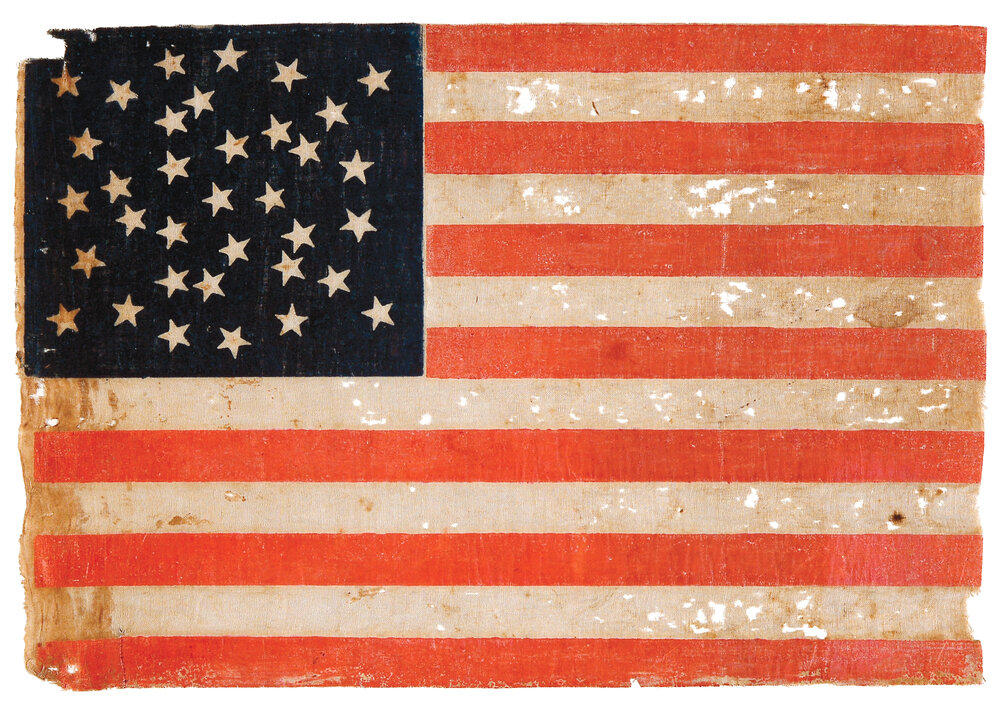
c. 1865
Printed on glazed cotton muslin.
Great Star pattern within wreath of stars.
Handwritten note: They are singing to my flag at a torchlight parade of Lincoln’s/men with their pickaxes and spades in 1864. As I stood on the/porch waving this flag, the company of men opposite the house/turned and saluted my flag and sang ‘Rally Round the Flag’ Boys. Florence G.S.
This flag is from a family member of the 24th Massachusetts Infantry Regiment. Organized at Camp Massasoit, Readville in September 1861, the regiment saw extensive action in North Carolina, Virginia, Florida and South Carolina before mustering out in January 1866.
34-STAR EAGLE FLAG
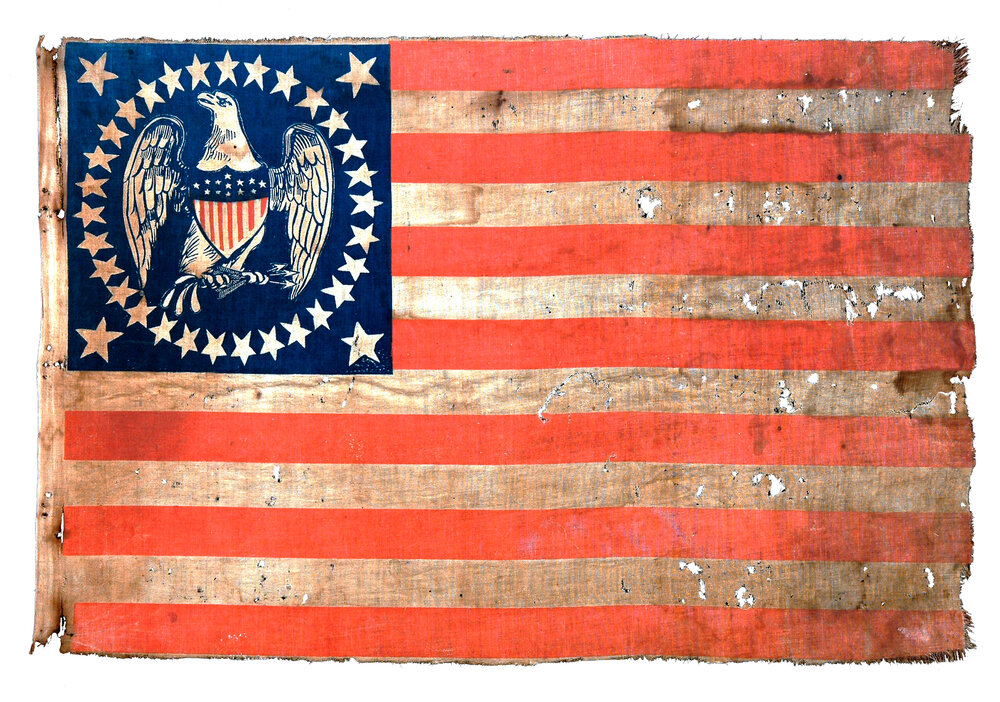
c. 1861-63
Paint-printed on cotton.
Wreath surrounding large eagle and colored shield, flanked by star in each corner.
Following adoption of the Great Seal in 1782, there was a notable appearance of flags with an eagle painted on the canton. During both the War of 1812 and the Civil War, Army regimental flags were produced with an eagle and the name of the regiment painted on a scroll beneath the shield. As America expanded into the western frontier, explorers carried eagle flags and presented them to Indian tribes as a symbol and expression of peace.
48-STAR ANTI-ROOSEVELT CAMPAIGN FLAG
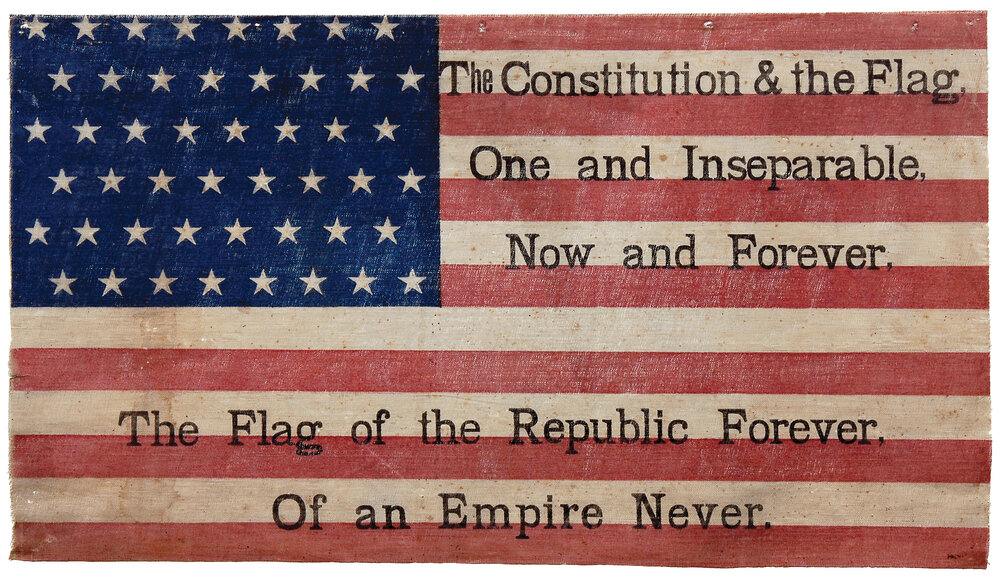
c. 1912
Printed on cotton.
Staggered pattern.
Overprint: The Constitution & the Flag One and Inseparable Now and Forever The Flag of the Republic Forever Of an Empire Never
When Theodore Roosevelt became president in 1901, he further shaped the legacy of American expansionism inherited from William McKinley into a new imperialism. Roosevelt strongly believed in a new global role for the United States to match its growing economic power and worldwide interests.
Roosevelt’s antagonists argued his policies wrongfully imposed American values on others, and that global expansion did not advance civilization or peace but rather had disastrous consequences. This flag was used by opponents of Roosevelt during the Election of 1912 when he unsuccessfully campaigned for president on the Bull Moose Party ticket.
38-STAR GOLD FRINGE FLAG
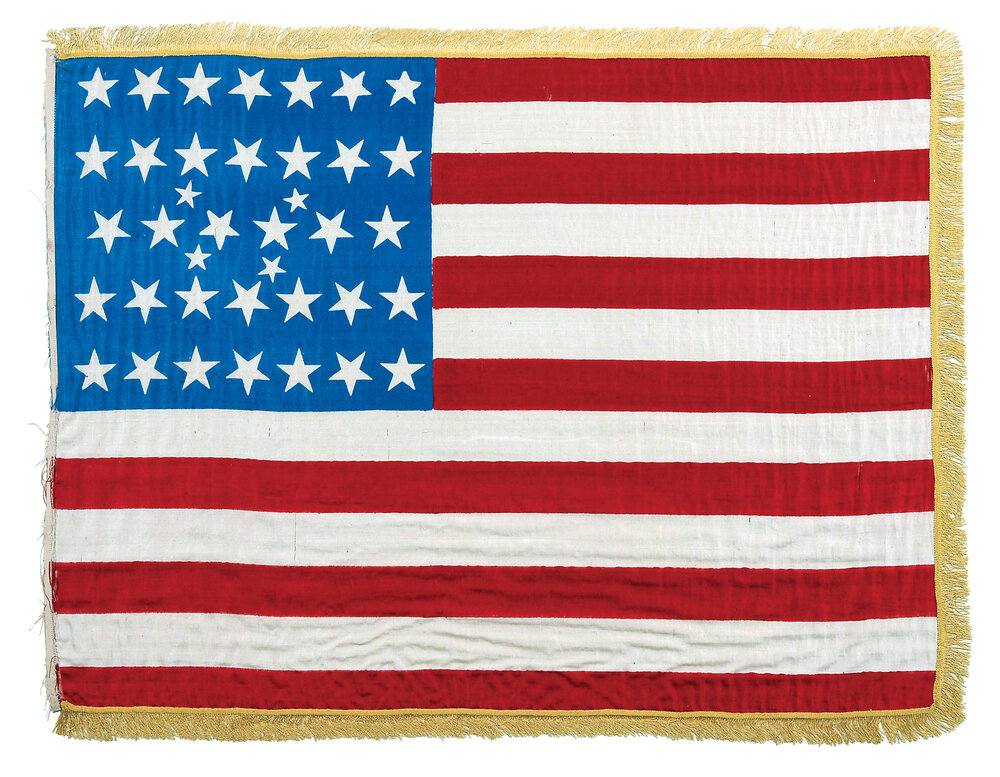
c. 1876
Printed on silk.
Gold silk fringe on three sides.
Four additional smaller stars inserted after second and third rows.
As the nation commemorated its 100th birthday, American flag makers used the occasion to create distinctive star patterns, as illustrated in this rare example with gold fringe.
13-STAR HARRISON 1888 CAMPAIGN FLAG
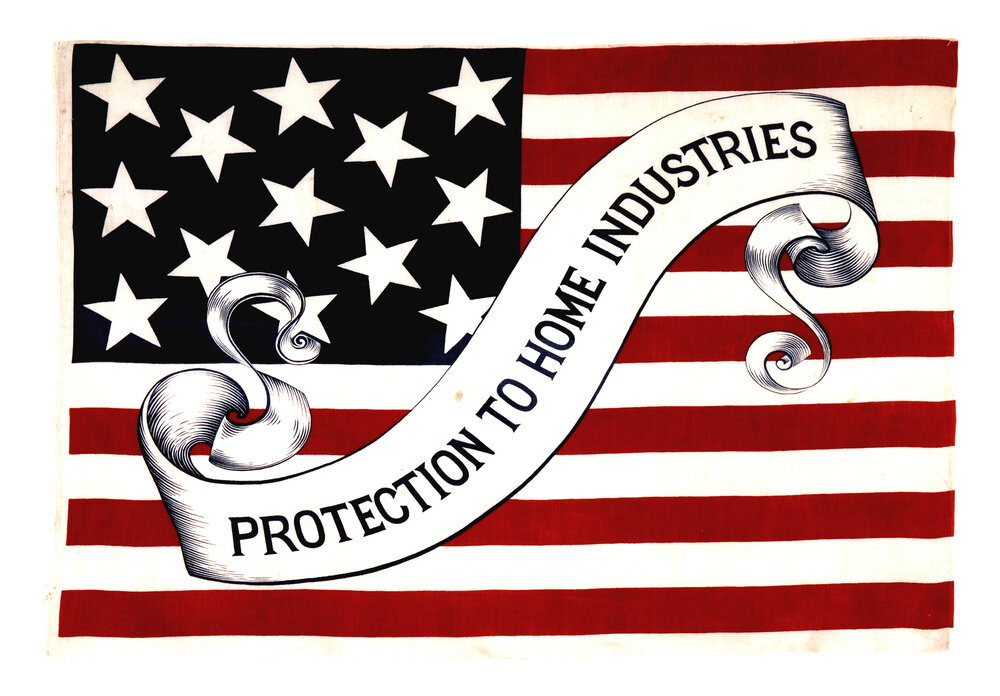
c. 1888
Printed on cotton.
Diagonal printed scroll: Protection to Home Industries
The central campaign issue in the presidential election of 1888 was tariffs, with Republican candidate Benjamin Harrison supporting a strong tariff policy while incumbent Grover Cleveland advocating reduced tariffs. The campaign also set a new standard for corruption which eventually led to election reforms including adoption of the secret ballot and introduction of newly-invented voting machines.
Benjamin Harrison, grandson of former President William Henry Harrison, campaigned on a platform advocating protection to home industries. The Grand Army of the Republic (GAR) supported him and became an important political force against President Cleveland after he vetoed veterans’ pension legislation and agreed to return Confederate battle flags to the South. Cleveland won the popular vote, but lost the electoral college vote and the presidency to Harrison.
45-STAR LONDON ARMISTICE DAY FLAG
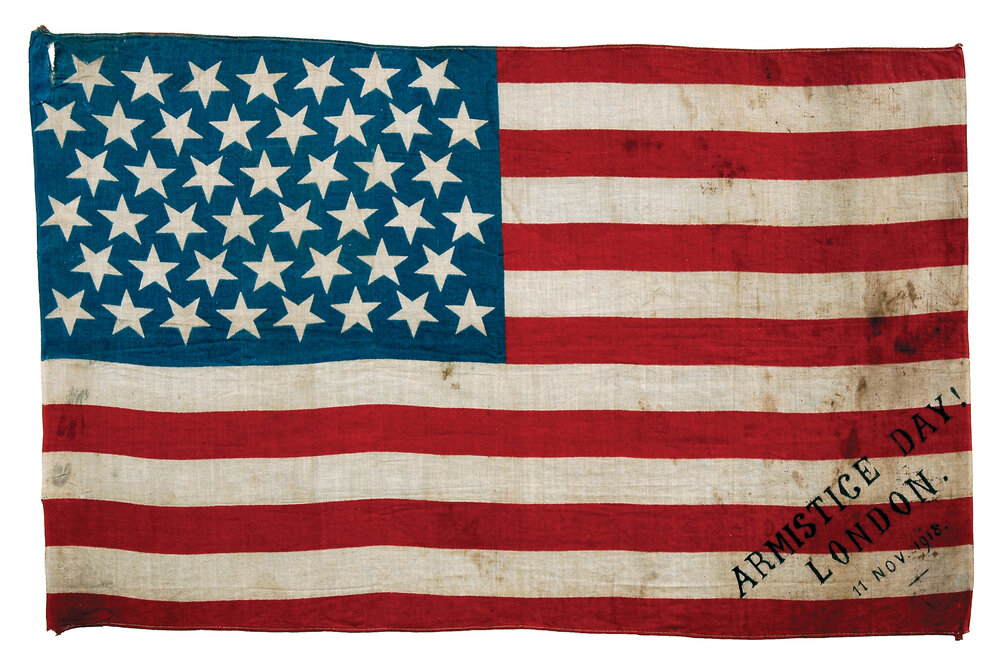
c. 1918
Printed on cotton.
Handwritten inscription in lower right corner: Armistice Day! London. 11 Nov. 1918
At 11:00 a.m. on November 11, 1918, allied forces and Germany agreed to a cease-fire ending World War I. The eleventh hour of the eleventh day of the eleventh month has become a moment of special significance associated with honoring and remembering those who died in the first modern world conflict.
Armistice Day became a national holiday in 1938, and President Eisenhower signed legislation in 1954 proclaiming it a day of remembrance of all wars and changing the name to Veterans Day.
In Great Britain, Armistice Day was renamed Remembrance Day after World War II and is celebrated on the second Sunday in November, usually the Sunday nearest November 11th. Special services are held throughout England.
38-STAR FLAG
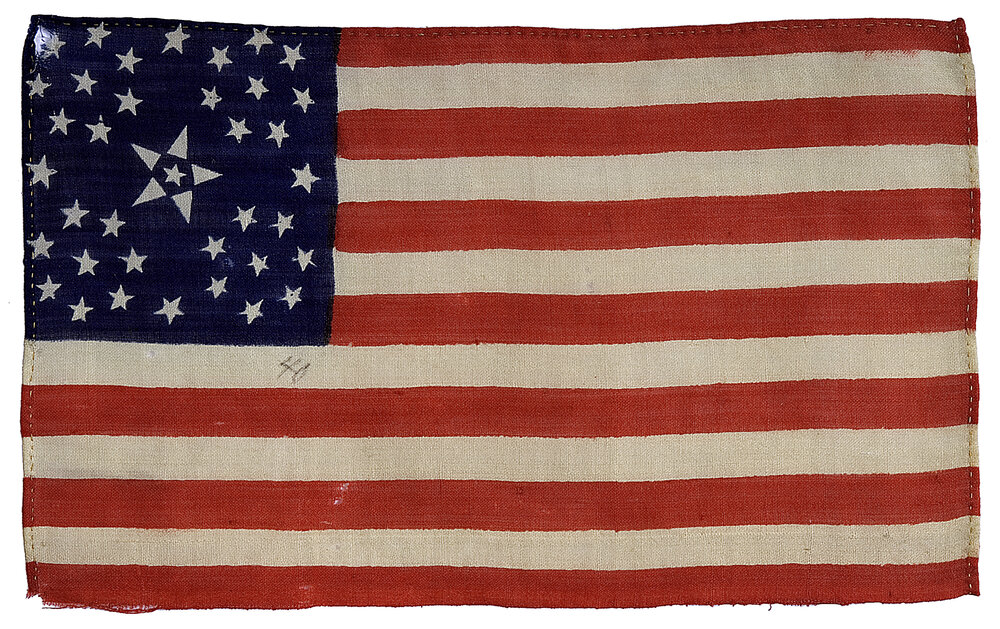
c. 1876
Printed on wool.
Star tips enclosing small central star, flanked by eight-star cluster in each corner with one outlying star between each cluster.
Number “40” written in pencil on white stripe below canton.
The Territory of Jefferson, which would have been the first state named for a past president, was originally incorporated as a provisional territory in 1859, however a year and a half later Congress abolished the provisional government and created the Colorado Territory.
After several unsuccessful attempts to gain statehood, in 1865 a state constitution was approved by the voters. During the next ten years, delays caused by the outbreak of the Civil War, a tarnished image resulting from the Sand Creek massacre, political maneuvering by President Johnson and other Democrats to prevent the addition of a Republican-leaning state, and concerns regarding the make-up of the population of the new territory prevented the passage of federal legislation to bring Colorado into the Union. Finally in August 1876, during the centennial celebration, Colorado was admitted as the thirty-eighth state and is appropriately nicknamed the Centennial State.
26-STAR FLAG
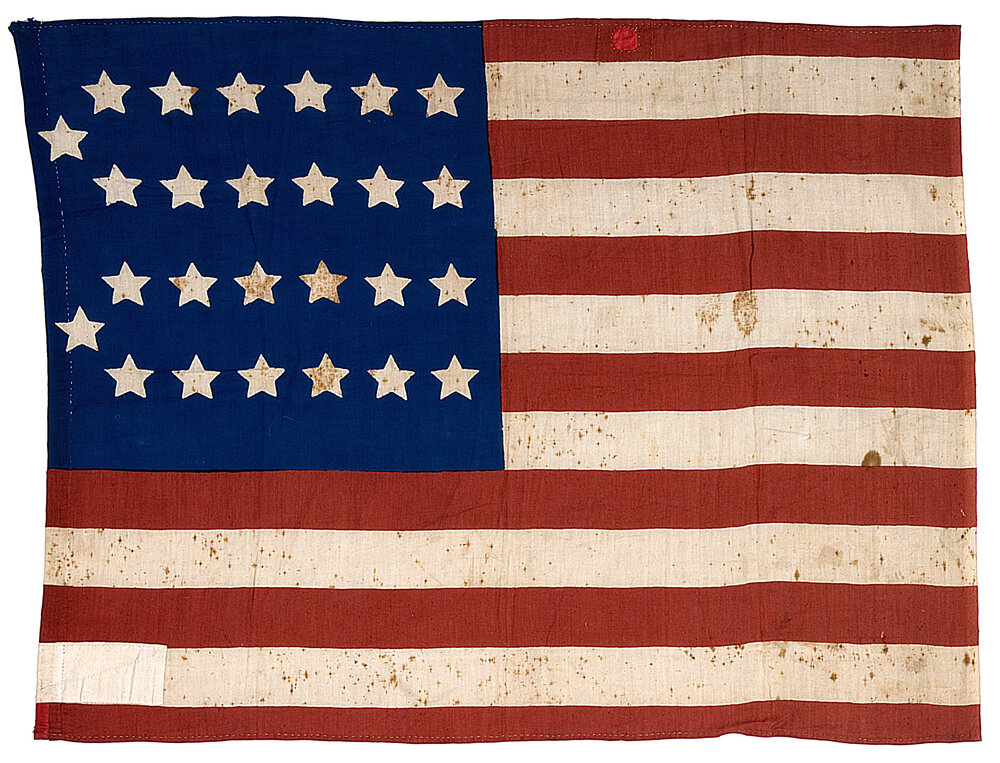
c. 1837-45
Printed on cotton.
Double C pattern.
The completion of the Erie Canal in 1825 enabled settlers from eastern states to easily migrate to the Midwest, and within 10 years, the Michigan Territory had sufficient population to apply for statehood. Following resolution of a boundary dispute with Ohio over an area that is now the City of Toledo, Michigan became the twenty-sixth state on January 26, 1837.
13-STAR HOP BITTERS FLAG
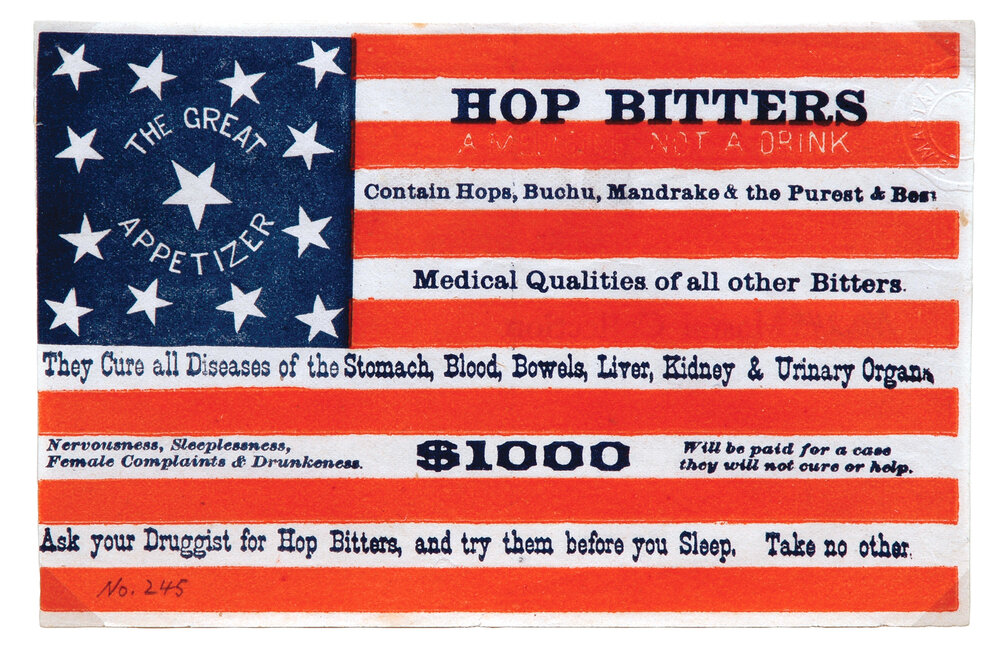
c. 1870-90
Advertising flag printed on paper.
Wreath pattern with central star, flanked by star in each corner. Phrase “The Great Appetizer” surrounds central star.
During the 1870s, bitters became one of America’s most popular medicines, claiming an ability to cure many diseases as well as to purify the blood, regulate the liver and restore one’s appetite and general health, all without intoxicating.
Bitters product advertising was among some of the best of the times, with manufacturers utilizing a wide variety of marketing methods to promote their product, including almanacs, trade cards, tokens, decanters and various other giveaways. Possibly this example is from Dr. Doyle’s Hop Bitters Manufacturing Co. of Rochester, New York, which like other patent medicine proprietors did not hesitate to publicize its product across the face of the American flag.
48-STAR BERDAN’S SHARPSHOOTERS REUNION FLAG
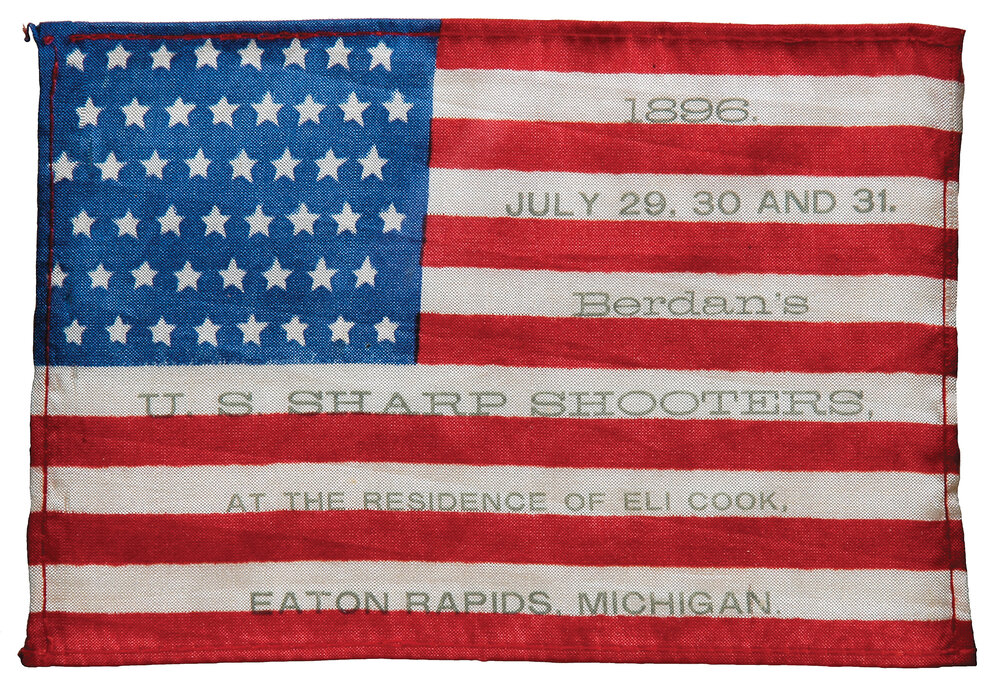
c. 1896
Printed on silk.
Staggered pattern.
Stamped overprint: 1896 July 29, 30 And 31. Berdan’s U.S. Sharp Shooters At The Residence Of Eli Cook, Eaton Rapids, Michigan.
Hiram Berdan was born in Phelps, New York, on September 6, 1824. A mechanical engineer and successful inventor in New York City before the war, he was known as the top rifle shot in the country. Amongst his many inventions was a repeating rifle, a patented musket ball and a twin-screw submarine gunboat.
When the Civil War broke out, Berdan proposed the formation of a special Union Army organization of the best marksmen. He was commissioned a Colonel and given authority to recruit two regiments of sharpshooters comprised of men capable of hitting enemy targets at great distances. The units were known as “Green Coats” and were equipped with the most advanced breech-loading rifles. The sharpshooters were utilized as snipers and skirmishers to demoralize the Confederate troops by picking off their officers and artillerymen at long range. Berdan’s sharpshooters served prominently with the Army of the Potomac at Bull Run, Chancellorsville and Gettysburg.
Eli Cook served with distinction as First Sergeant of Company I, 1st Regiment, from February 1862-January 1865. At the end of the war, he remained active organizing GAR encampments and reunions with his sharpshooter comrades.
37-STAR CAMDEN COUNTY MEMORIAL FLAG
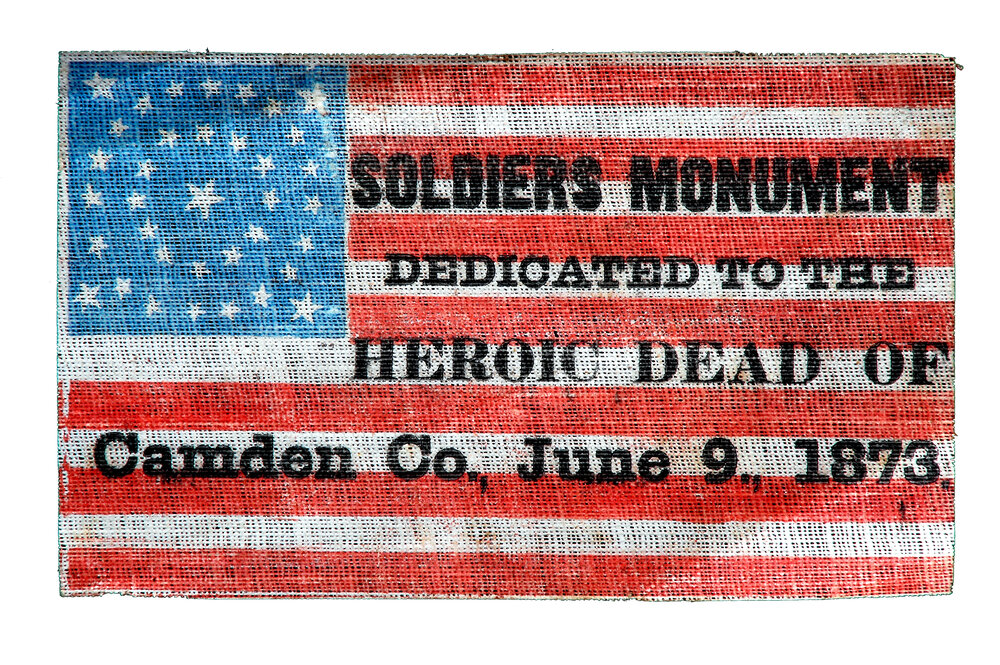
c. 1873
Printed on glazed cotton muslin.
Double medallion pattern with central star, flanked by star in each corner.
Overprint: Soldiers Monument Dedicated To The Heroic Dead Of Camden Co., June 9, 1873.
The Soldiers Monument was dedicated on June 9, 1873 in tribute to the memory of 383 soldiers from Camden County, New Jersey who died during the Civil War. The monument was unveiled with appropriate opening ceremonies and a number of dignitaries and large crowd in attendance. On signal, a flag at the base of the monument unfolded and ascended to the top of the flag pole as a shower of miniature flags fell gently upon the concourse below.
34-STAR LINCOLN MONUMENT FLAG
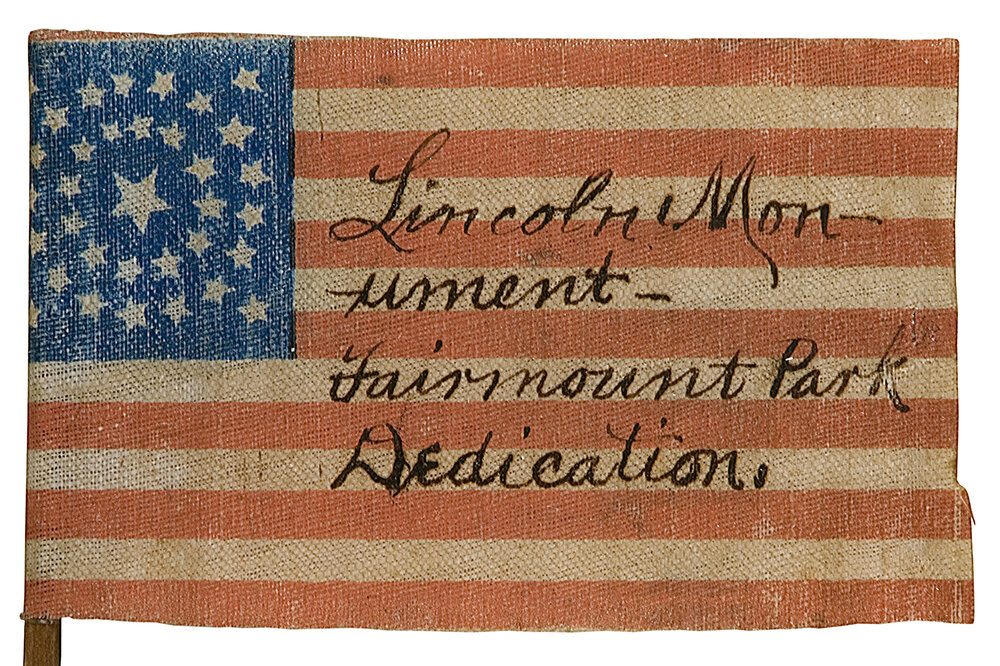
c. 1871
Printed on glazed cotton muslin.
Double medallion pattern with central star, flanked by star in each corner.
Handwritten inscription: Lincoln Monument Fairmount Park Dedication.
Fairmount Park, comprised of 4,180 acres on the banks of the Schuylkill River near Philadelphia, is the largest landscaped park in the United States and one of the largest municipal parks in the world.
Site of the Centennial Exposition in 1876, several buildings and monuments from that period still stand. Among the most noted is a large bronze statue of Abraham Lincoln crafted by neo-classic sculptor Randolph Rogers. The statue was commissioned by the Lincoln Monument Association at a cost of $33,000 and was dedicated in 1871.
48-STAR PEARL HARBOR FLAG
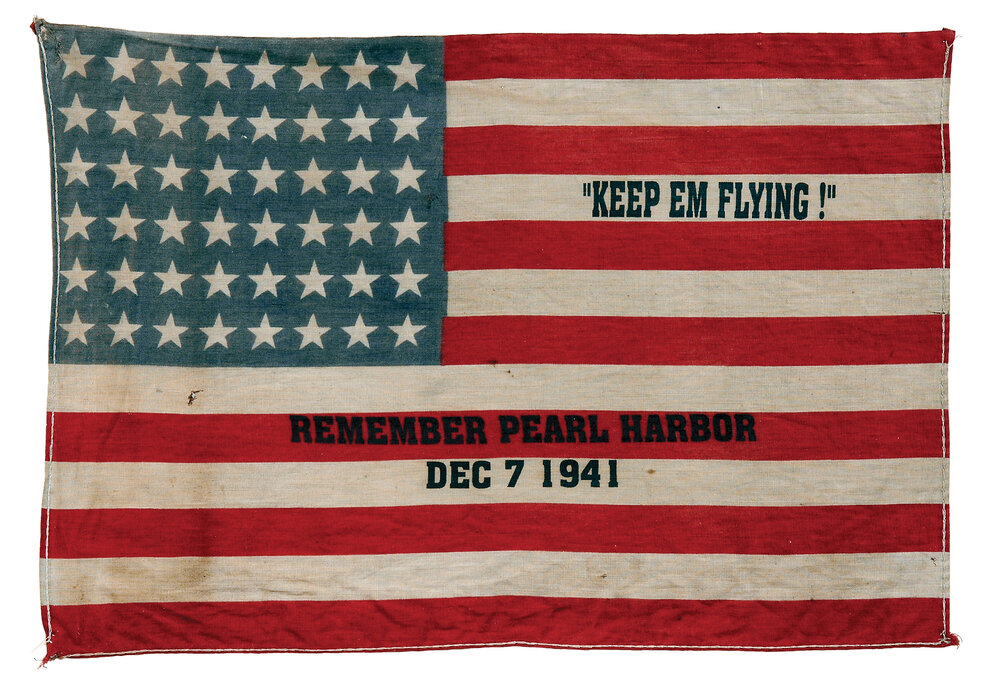
c. 1941-45
Printed on cotton.
Overprint: Keep ‘Em Flying! Remember Pearl Harbor Dec 7 1941
Following the Japanese attack at Pearl Harbor, a resolute spirit of nationalism swept across America. United in spirit, millions of men and women joined the armed services and fought valiantly on battlefields throughout Europe and the Pacific. On the home front, Americans worked in factories and shipyards to build the planes, tanks, ships and other weapons needed to successfully wage war against our enemies.
Patriotic items were produced with the motto “Remember Pearl Harbor” as a symbol of America’s resolve in the war effort. The popular slogan “Keep ‘em flying” was utilized in aircraft factories to instill patriotism and in flight line pep talks to motivate pilots and crew, stressing the importance of working together to maintain air superiority.
35-STAR EAGLE FLAG
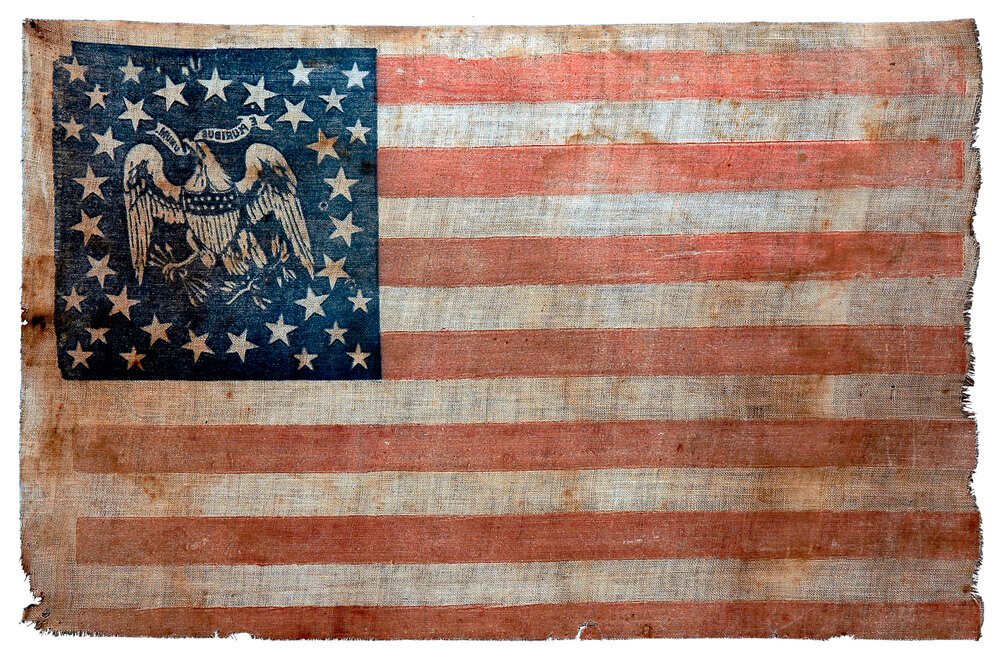
c. 1863-65
Printed on cotton.
Wreath surrounding eagle holding scroll inscribed “E Pluribus Unum,” flanked by four stars in each corner.
Eagle flags gained popularity with the military following adoption of the Great Seal in 1782 and were very much in evidence during the Mexican War and the Civil War. These flags were also carried as a symbol of peace by pathfinders who explored territories beyond the national boundaries of the United States in the mid-nineteenth century.
48-STAR MCKINLEY CAMPAIGN FLAG
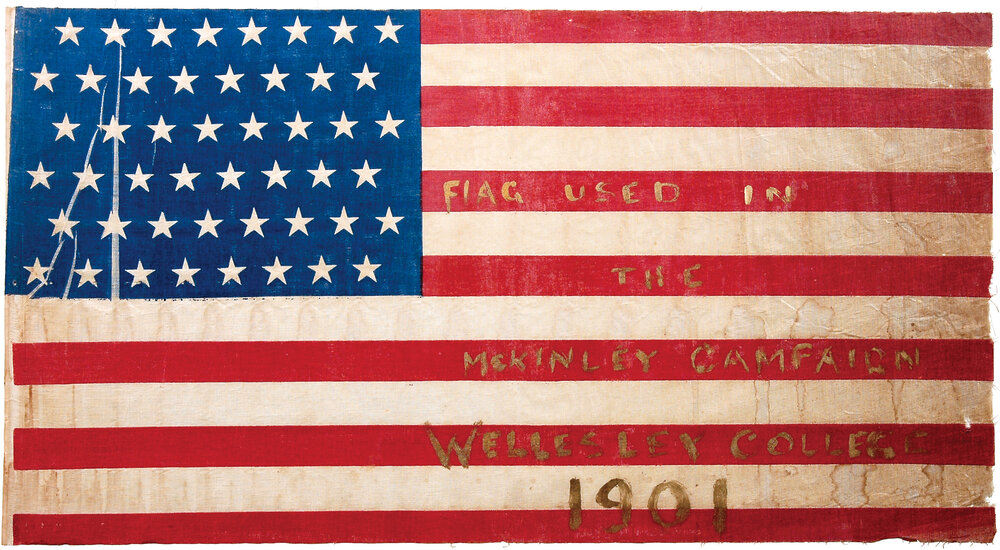
c. 1901
Printed on glazed cotton muslin.
Staggered pattern.
Gold-painted inscription: Flag Used In The McKinley Campaign Wellesley College 1901
Presiding over a period of prosperity at home and following the military victory over Spain in the Spanish-American War, President William McKinley easily won re-election against William Jennings Bryan in the Election of 1900. Six months into his second term, McKinley was assassinated by an anarchist while attending the Pan-American Exposition in Buffalo, New York. He died on September 14, and Vice President Theodore Roosevelt was sworn in as President.
McKinley and his cabinet visited Wellesley College for a Lincoln-Douglas debate celebration in 1899 and later campaigned there in the Presidential election.
35-STAR FLAG
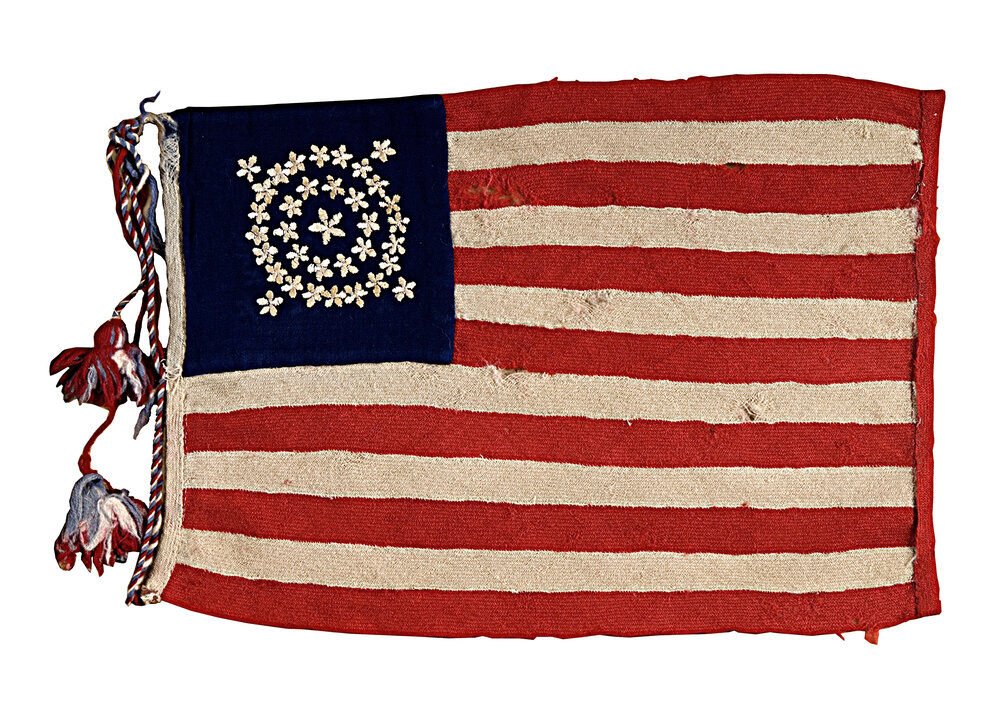
c. 1863-65
Hand-sewn wool stripes and embroidered stars.
Double medallion pattern with central star, flanked by star in each corner.
The red and white stripes are made of period, hand-loomed wool tape identical to that used on enlisted men’s uniforms to designate divisions within the Union Army during the Civil War. The attached wool cords and tassels most likely were used originally to attach the flag to a staff.
48-STAR TANK CORPS FLAG
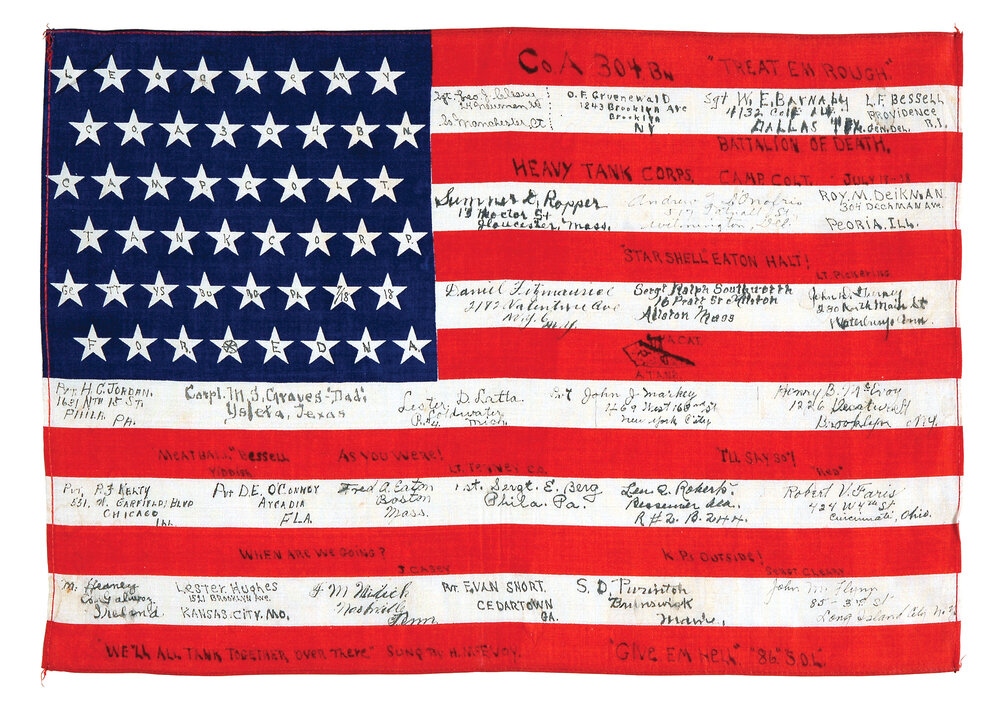
c. 1918
Printed on silk.
Inscription on stars: Leo Cleary Co A 304 Bn Camp Colt Tank Corp/Gettysburg Pa 7/18/18 For * Edna
Handwritten on the stripes are notations along with the names and hometowns of several men in Company A.
The War Department established a military camp at Gettysburg in April 1917 to train members of the Army in the use of armored tanks. Camp Colt, named for Samuel Colt inventor of the revolver bearing his name, existed less than one year and during that time was responsible for training more than 15,000 troops.
The commander of Camp Colt was captain Dwight D. Eisenhower who served from March to November 1918. Eisenhower had been identified as an officer with good organizational skills, and for that reason was assigned to command America’s first tank training center. He was instrumental in establishing a separate armored unit known as the Army Tank Corps and for his efforts was awarded the Distinguished Service Medal.
48-STAR VJ DAY HYANNIS FLAG

c. 1945
Printed on glazed cotton.
Ink inscription: V.J. Day Hyannis Mass Aug 14, 1945 JFK
On August 14, 1945, President Harry S. Truman announced the surrender of Japanese forces, ending World War II. Known as “Victory Over Japan Day,” or simply “V-J Day,” it came several months after the surrender of Nazi Germany and brought to a final close four years of hostilities. Japan’s surrender became official on September 2, 1945 aboard the Battleship USS Missouri.
The war was over, and across America it was a time to celebrate. Within hours, clubs, taverns and restaurants were filled with soldiers, sailors and citizens from all walks of life, singing, dancing and toasting the fall of Japan. This flag proudly documents the historic occasion in Hyannis, the largest of seven villages in the Town of Barnstable, Massachusetts.
48-STAR WHIPPLE PEACE FLAG
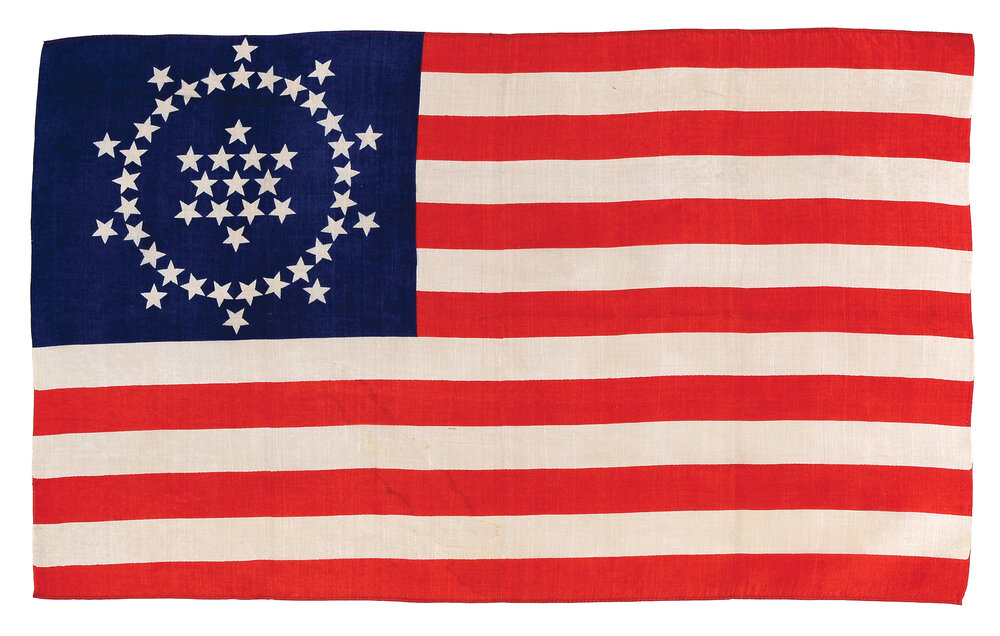
c. 1931
Printed on silk.
Wreath pattern with outer ring of stars surrounding six-pointed central star.
Philadelphia flag designer Wayne Whipple arranged the combination of stars to record the history of our country. The thirteen original states are in the center in the form of a six-pointed star, surrounded by a circle of twenty-five stars representing the states added to the Union up to the time of the centennial in 1876, and an outer ring of stars representing additional states since the centennial.
Whipple called his flag the “Peace Flag” in tribute to the global peace movement during the years before World War I. His unusual graphic design was widely publicized and admired, but not adopted.
14-STAR FLAG
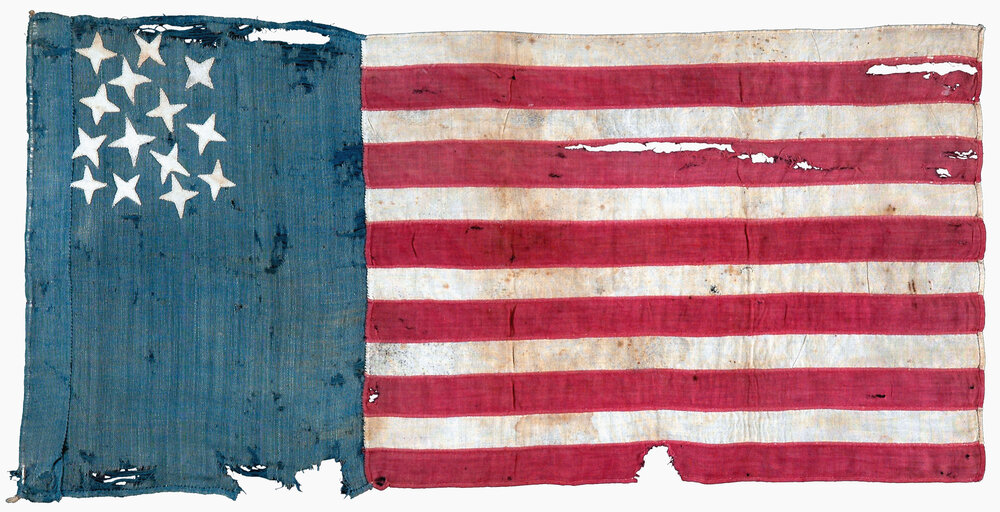
c. 1847-56
Hand-sewn cotton and appliquéd four-pointed stars.
Canton extends full flag height with stars configured randomly in upper left corner. Twelve stripes in white and red sequence.
This rare flag was made in Maine for Ossian Preston Ingraham when he was a young boy. Born in Kenduskeag, Maine in 1847, Ossian and his parents Joseph and Nancy (Cole) Ingraham lived there until moving to California in 1863.
Among the documents acquired with this flag is a letter written by Ossian to his daughter Eleanor on April 27, 1906, nine days after the great San Francisco earthquake, in which he describes the devastation and living conditions that existed in the aftermath of that horrible tragedy.
36-STAR HARRISON 1888 CAMPAIGN FLAG
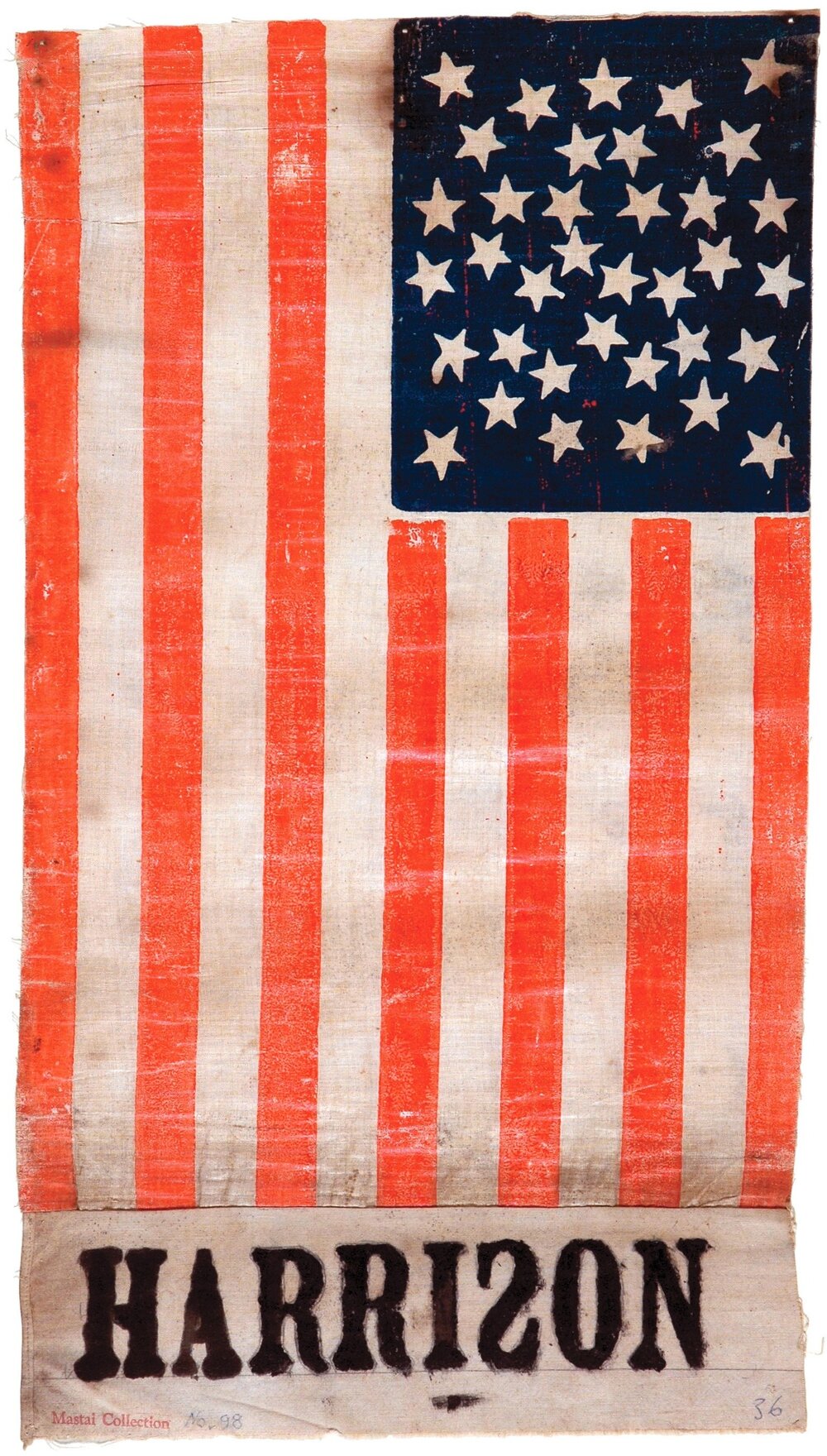
c. 1888
Printed on glazed cotton muslin.
Great Star pattern within wreath of stars.
Attached cotton band with last name of presidential candidate Benjamin Harrison stenciled in black: Harrison (Letter “s” is reversed.)
Throughout the latter part of the nineteenth century, politicians recognized the popularity of the Stars and Stripes and used the flag to promote their candidacy and political slogans during election campaigns.
This flag was used by Benjamin Harrison during the presidential campaign of 1888. In that election, Harrison received fewer popular votes than incumbent Grover Cleveland, but carried the Electoral College to become the nation’s twenty-third president.
31-STAR GREAT STAR FLAG
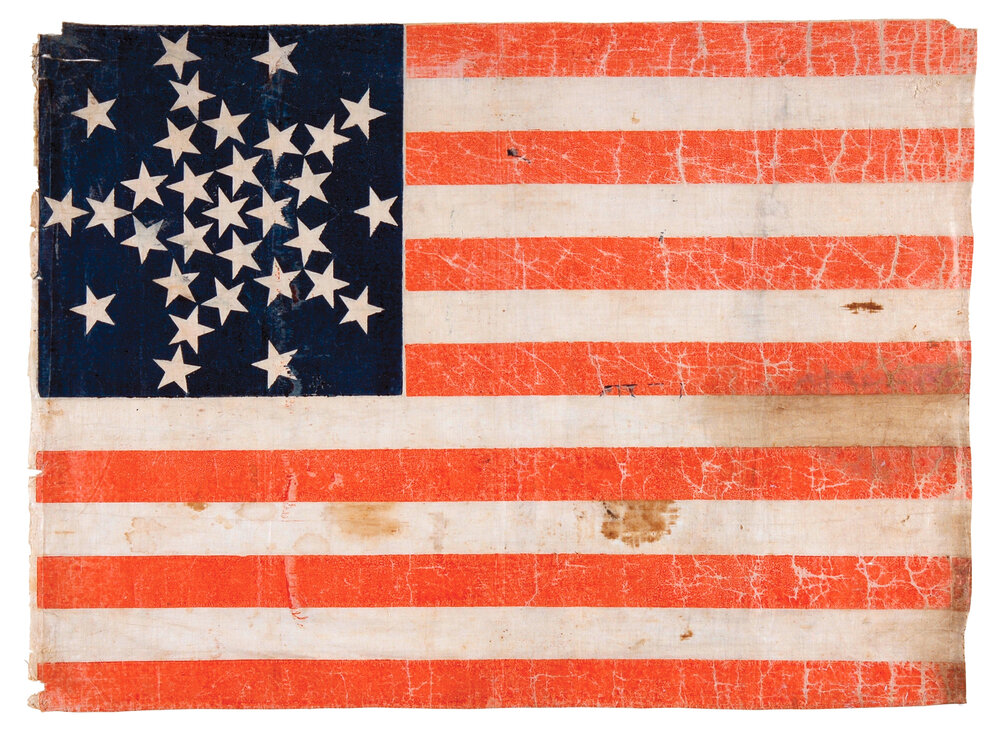
c. 1851-58
Printed on glazed cotton muslin.
Great Star pattern with outlying star between each point.
The Great Star pattern has an extraordinary folk art quality and is widely regarded as the most beautiful of the Stars and Stripes. This magnificent configuration arranged in an unusual offset pattern was likely transformed from an earlier twenty-six-star design.
38-STAR GRANT HARTFORD RECEPTION FLAG
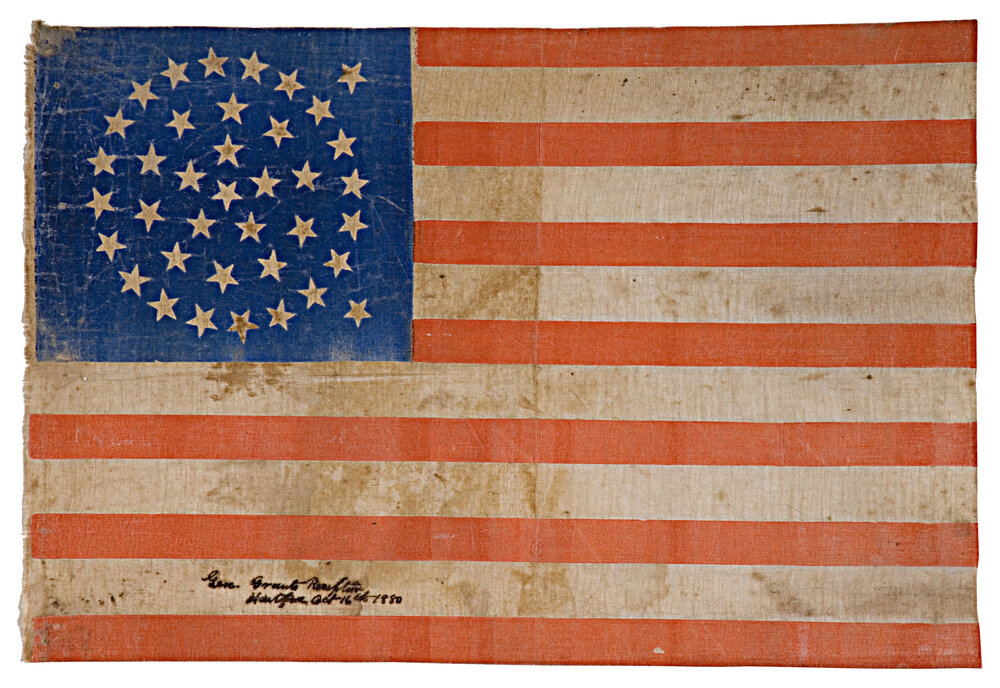
c. 1880
Printed on glazed cotton muslin.
Global pattern with central star, flanked by star in upper right and lower right corners.
Ink inscription: Gen. Grant Reception Hartford Oct 16th 1880
During a trip from Boston to New York on October 17, 1880, former President Ulysses S. Grant stopped in Hartford for a public reception and was met by large crowds of admirers lining the streets along the route from the train station to Bushnell Park. Among the dignitaries welcoming General Grant was Mark Twain who spoke highly of Grant and his leadership abilities, describing him as a great soldier, honored statesman and unselfish citizen.
Grant and his party were escorted through the city by a procession of more than 2,000 veterans and soldiers and thousands of members of Republican campaign clubs from Hartford and the surrounding towns. After dinner at the home of General William Bulkeley, the celebration continued with a torchlight parade and fireworks. Later that evening, Grant boarded a train for New York.
13-STAR CENTENNIAL FLAG
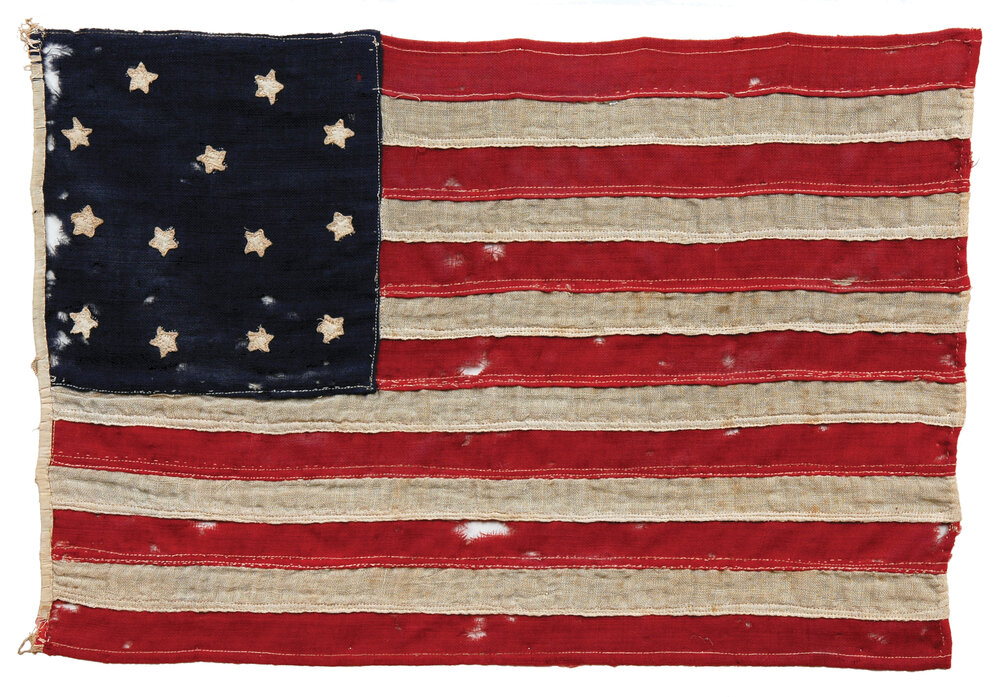
c. 1876
Machine-sewn cotton; hand-sewn appliqué stars.
Wreath pattern with three stars in center forming a triangle.
The popularity of the flag reached new heights during the years following the Civil War, and Americans continued their love affair with the Stars and Stripes through the time of our nation’s 100th birthday celebration in 1876. One-of-a-kind flag designs epitomized the true expression of individual freedom and a renewed faith in the principles on which the republic was founded.
This flag is one of only a few known examples in which the stars are configured in a wreath pattern surrounding a triangle of stars.
48-STAR RED CROSS WORKER FLAG
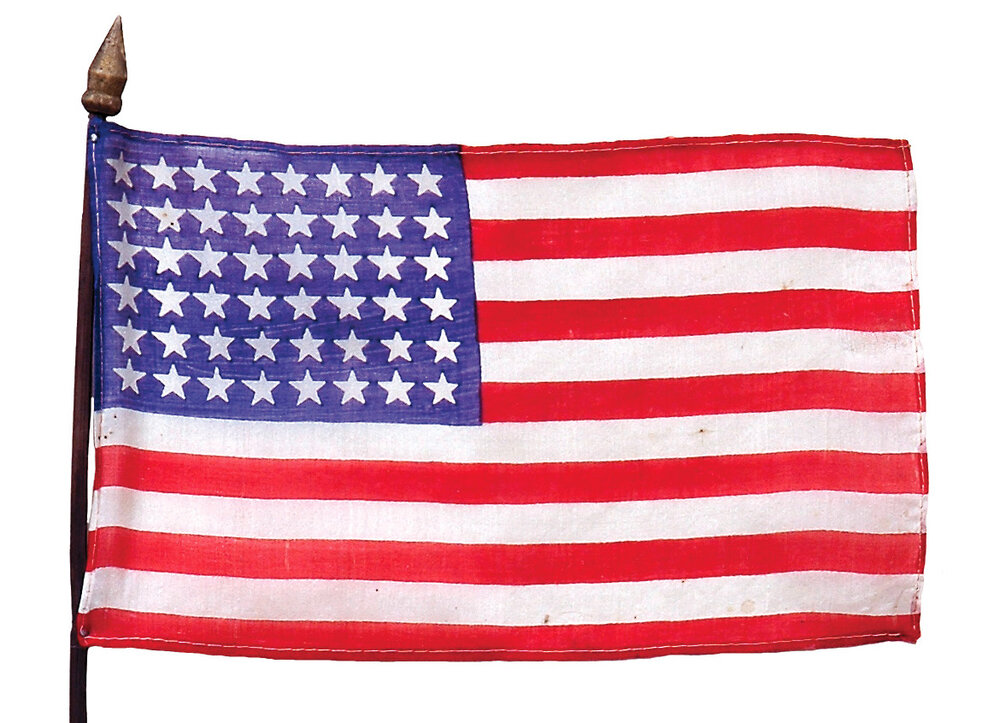
c. 1918
Printed on silk.
Handwritten note accompanying the flag:
Flag and ribbon I carried in the parade in 1918 the end of the World War. (signed) Bertha as a Red Cross worker
When the United States entered World War I, the American Red Cross turned its energies to supporting the needs of the thousands of young men joining the allied forces on the battlefields of Europe. Communities throughout the country flooded Red Cross headquarters with requests to establish local chapters, with the number growing to 3,700 and membership increasing to more than twenty million by the end of the war. In every community, the Red Cross called upon patriotic women to sew and knit for the boys in camps and overseas.
After the war, parades were held in cities across the nation celebrating the return of American troops and demonstrating the country’s patriotic solidarity.
48-STAR RED CROSS WORKER FLAG (RIBBON)
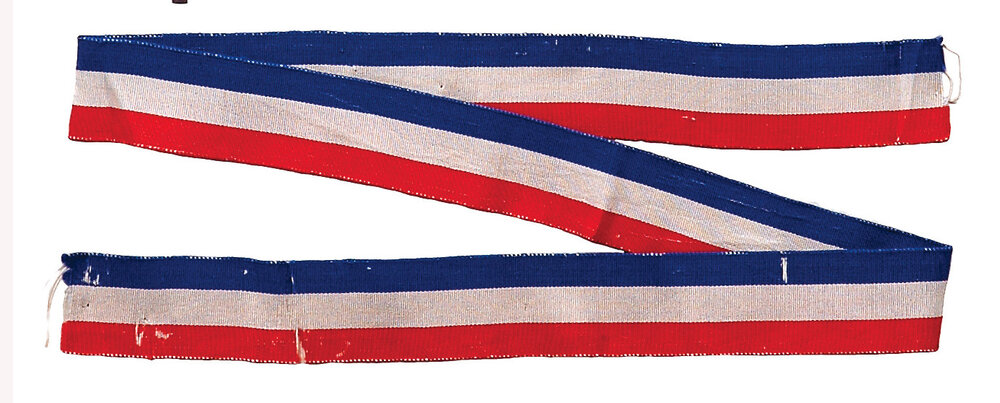
48-STAR GETTYSBURG REUNION FLAG
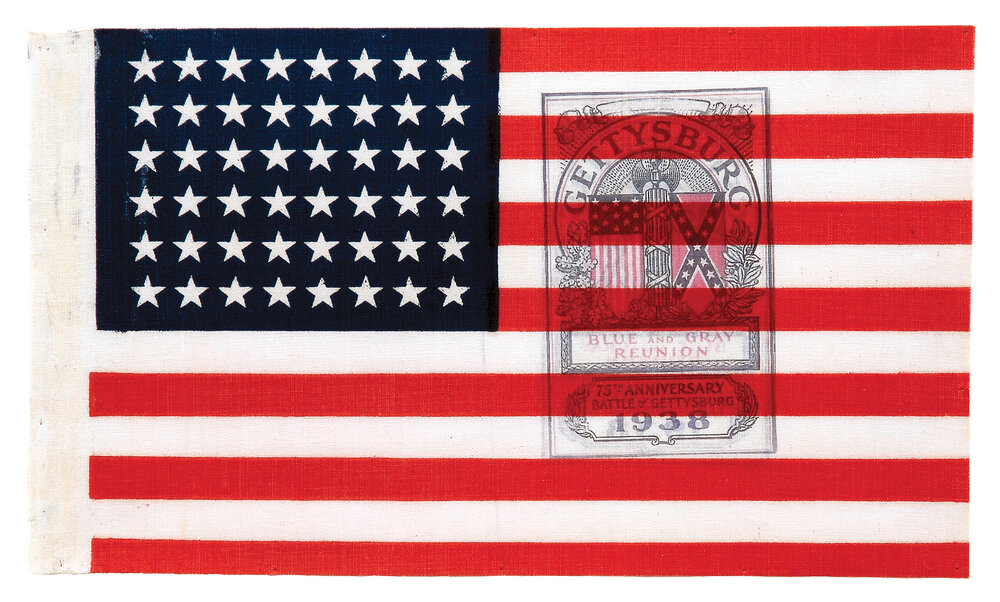
c. 1938
Printed on cotton.
Stamped overprint: Gettysburg Blue And Gray Reunion 75th Anniversary Battle of Gettysburg 1938
The 75th anniversary of the Battle of Gettysburg, the Blue and Gray Reunion, was held July 1-4, 1938. This was the last Civil War reunion and the only time when the major veterans’ organizations were assembled on a national stage. All living veterans of the Civil War received formal invitations to the event and were given free railroad passage. A special souvenir medal was struck for the occasion and presented to each of the 1,359 Union and 486 Confederate veterans in attendance.
Pennsylvania’s Governor George Earle welcomed the veterans to the reunion. Other speakers included Secretary of War Harry Woodring, GAR Commander in Chief Dr. Overton Mennet, and UCV Commander in Chief General John Claypool. A lavish parade followed that was described as seven miles long and moved with clock-like-precision.
The lasting contribution of the reunion was the dedication by President Franklin Roosevelt of the Eternal Light Peace Memorial on the Gettysburg battlefield before a crowd of 450,000 visitors. Roosevelt spoke of the sacrifices, healing of wounds, and peace, but most strongly invoked the memory of Abraham Lincoln who chose the dedication of the Gettysburg Cemetery to deliver his famous address in November 1863.
48-STAR SUFFRAGE PARADE FLAG
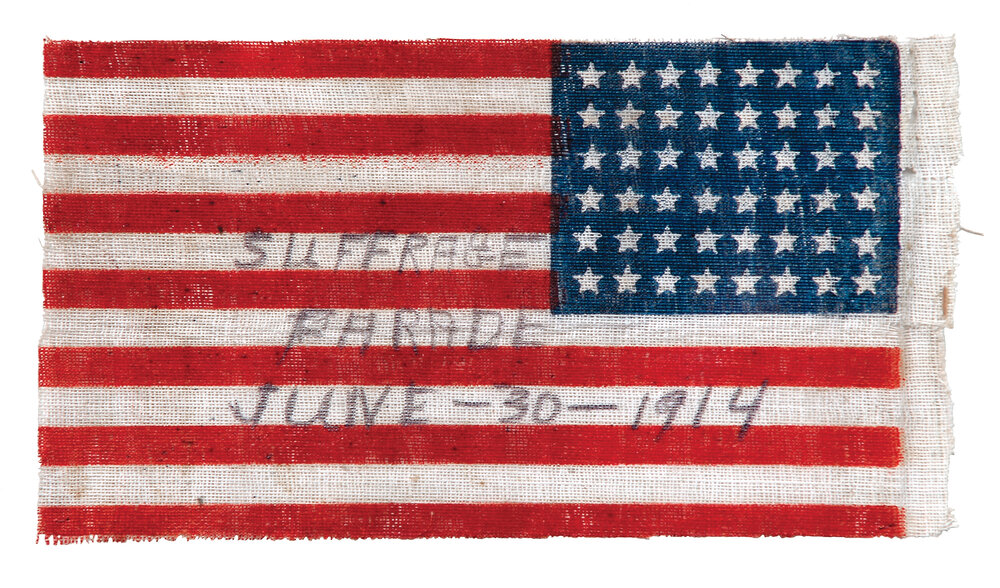
c. 1914
Printed on glazed cotton muslin.
Inscription: Suffrage Parade June – 30 – 1914
In 1890, the two leading women’s organizations of the time, one led by Elizabeth Stanton and Susan B. Anthony and the other headed by Lucy Stone and Julia Ward Howe, merged to form the National American Woman Suffrage Association. Its agenda was to pressure state legislatures to amend state election laws and at the same time to pursue the adoption of a constitutional amendment for women’s voting rights.
By 1914, Alice Paul and other activist leaders realized that full suffrage would be achieved only through the adoption of a federal Constitutional amendment and that more militant action was necessary to strengthen their cause and give courage to friends of the movement. To this end, public parades, silent vigils and hunger strikes were staged in large cities
The “Anthony Amendment” passed both houses of Congress in 1918 and two years later was ratified as the Nineteenth Amendment to the Constitution.
45-STAR AMBULANCE TRAIN FLAG

c. 1917
Printed on cotton.
Diagonal overprint: Souvenir of Ambulance Train Construction by the Lancashire & Yorkshire Railway for use on the Continent. November 1917.
During the First World War, ambulance trains were used in France and Belgium to transport wounded and sick soldiers to hospitals. One such train built by the Lancashire & Yorkshire Railway Company made a tour of northern towns and cities before going into service on the Western front in November 1917. The superb train featured ten wards, eight with thirty-six cots each and two with eighteen cots each for treating infectious diseases, a well-equipped pharmacy, two kitchen cars, a medical staff car and a separate car for other personnel.
48-STAR LINDBERGH DAY FLAG
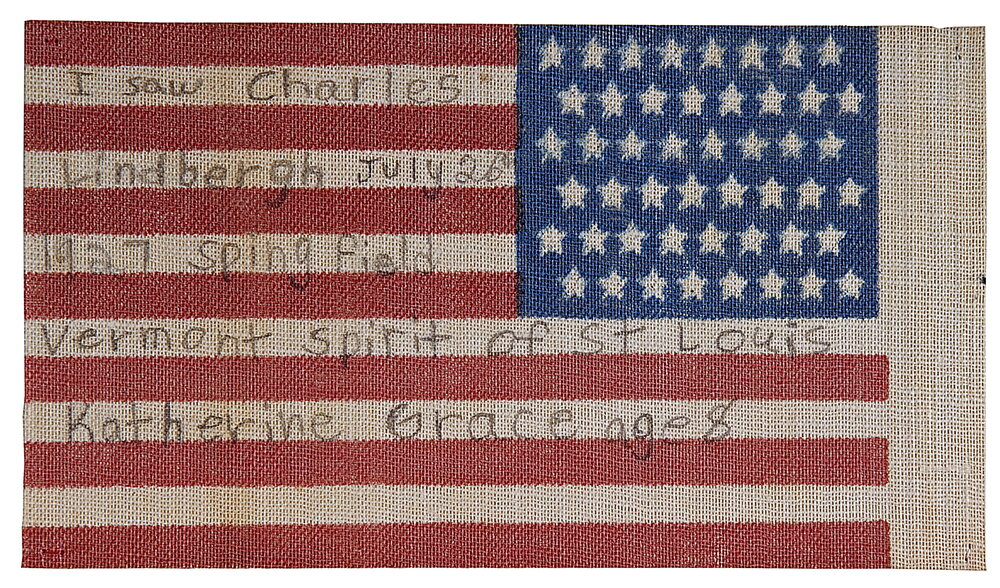
c. 1927
Printed on glazed cotton muslin.
Staggered pattern.
Inscription: I saw Charles Lindbergh July 26th 1927 Springfield Vermont Spirit of St Louis Katherine Grace age 8
Following his record breaking trans-Atlantic flight to Paris, Charles Lindbergh flying the “Spirit of St. Louis” set out on a three month nationwide tour to promote the aeronautical industry. The tour sponsored by the Daniel Guggenheim Fund included stopovers at eighty-two cities in forty-eight states. One such appearance was a celebration on July 16, 1927 in Springfield, Vermont organized by ex-governor James Hartness, a friend of Lindbergh and fellow pilot. When Lindbergh landed at Hartness’ private airport, he was greeted by a cheering crowd of more than 30,000 people.
The flag’s inscription written by a young girl who attended the event captures the essence of the respect and admiration the American public held for Charles Lindbergh, a true hero and aviation pioneer.
48-STAR MENU FLAG
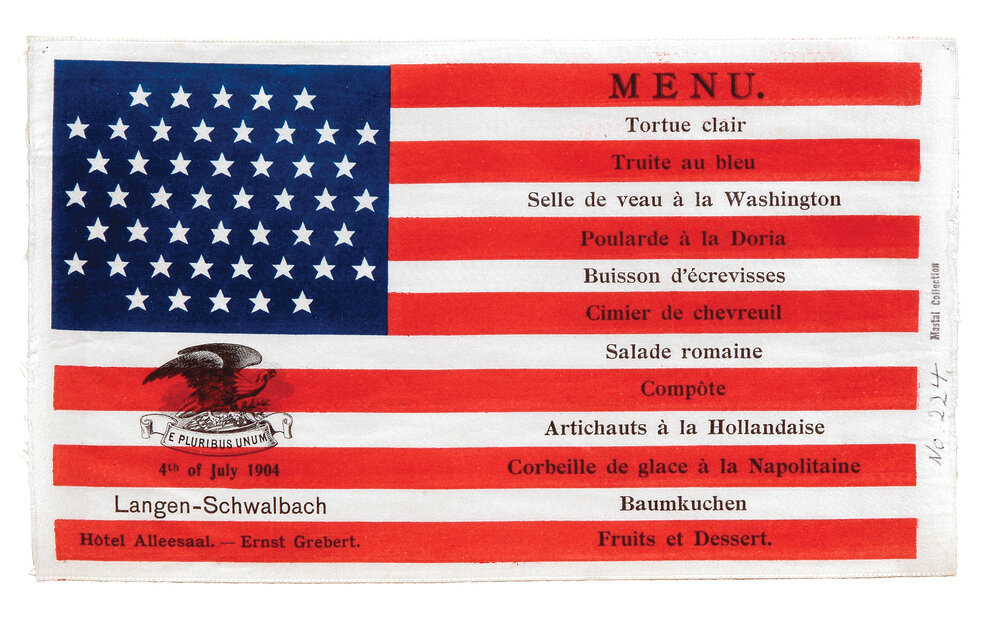
c. 1904
Printed on satin ribbon.
Fourth of July dinner menu from the Hotel Alleesaal in Langen-Schwalbach, Germany in 1904.
GETTYSBURG CYCLORAMA SOUVENIR FLAG

c. 1894-99
Printed on paper.
Image of Gettysburg National Park Cyclorama Center.
The Battle of Gettysburg Cyclorama, a circular oil-on-canvas painting depicting the heroic charge of the Confederate infantry led by General George Pickett on July 3, 1863, was painted by French artist Paul Philippoteaux and opened to the public in Chicago in 1883. It received such public acclaim, Philippoteaux painted a second version that opened in Boston a year later. At the conclusion of the Boston exhibition, the cyclorama was displayed in New York, Washington D.C. and Baltimore before being transported to Gettysburg where it has been on display at the Gettysburg National Military Park since 1913. A nine million dollar renovation to repair sections of the canvas and restore some of the original details of the painting was completed in 2007. The Cyclorama is 359 feet long, 27 feet high and weighs 3 tons.
The Chicago cyclorama was recovered from a warehouse and sold privately in 1965 and later donated to Wake Forest University. Two other Gettysburg cycloramas were painted by Philippoteaux. One was shown in Denver and cut up for use as tents on a Shoshone Reservation; the fate of the other painting is unknown.
This souvenir flag is from the Battle of Gettysburg Cyclorama exhibition in Baltimore.
34-STAR GREAT STAR FLAG
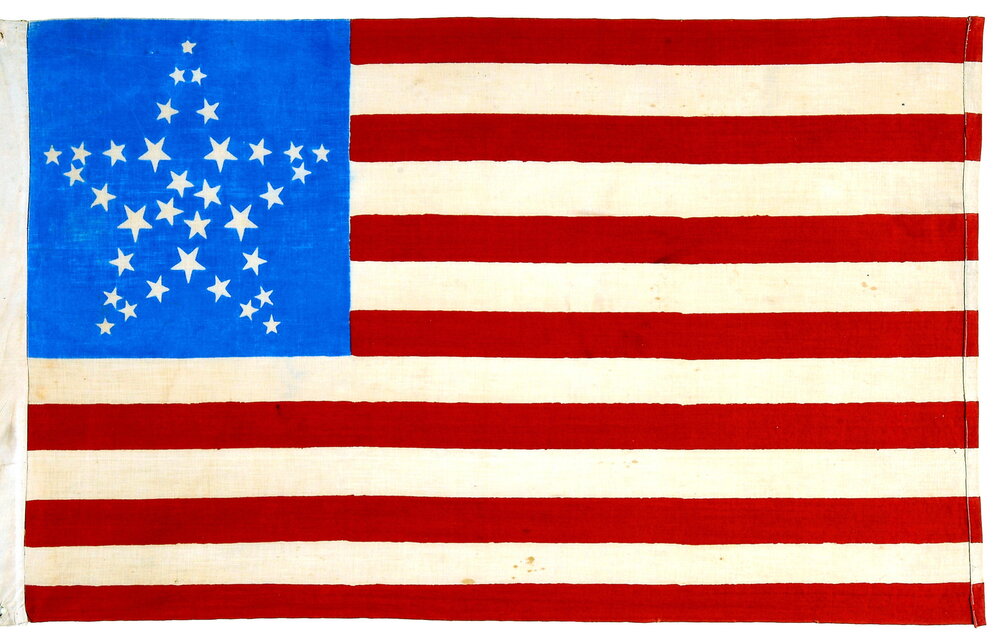
c. 1861-63
Printed on cotton.
Great Star pattern.
The thirty-four stars form a perfect pentagram, unlike earlier flower-like Great Star patterns. One of similar design, edged with a band of black crepe, was used as a mourning flag for Abraham Lincoln.
48-STAR HARLEY DAVIDSON FLAG
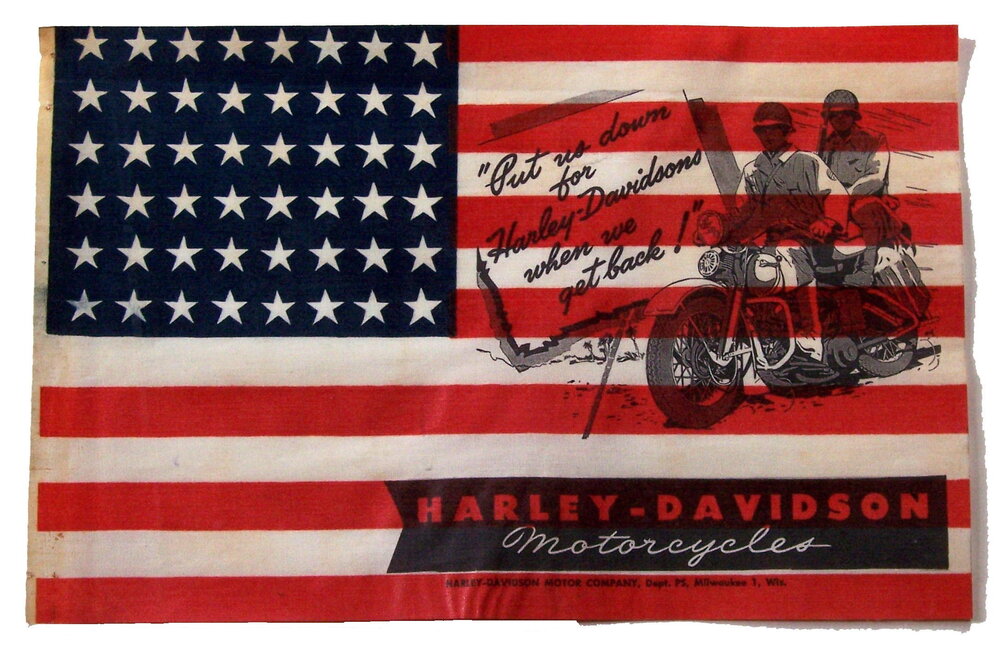
c 1942-45
Printed on oil cloth.
Image of two soldiers riding a motorcycle with inscription: Put us down for Harley-Davidsons when we get back. Harley-Davidson Motor Company, Dept. PS, Milwaukee, Wis.
Harley-Davidson Motorcycle Company was founded in 1903 in Milwaukee, Wisconsin by William Harley and three Davidson brothers, Walter, William and Arthur. One of only two American motorcycle manufacturers to survive the Great Depression, Harley prospered during World War II by producing large numbers of military-specific motorcycles for use by the Army as police, escort and courier vehicles. Harley received two Army-Navy “E” Awards, one in 1943 and the other in 1945, for excellence in war time production. After the war, the company once again produced recreational and racing bikes.
This advertising flag reflects Harley-Davidson’s strong support of U.S. troops and its appreciation for the sacrifices made by those who served our nation. As a reliable supplier of military equipment, the company built a solid reputation and in doing so earned the respect and loyalty of armed forces personnel who relied on motorcycles during the war effort and potentially could become customers in civilian life.
46-STAR LINCOLN BIRTHDAY FLAG

c. 1909
Printed on silk.
Inscription: One Hundredth Anniversary Celebration Of The Birthday Of Abraham Lincoln, February 12, 1909 Lincoln Park Chapter, No. 177, R.A.M.
Abraham Lincoln was born in Harden County, Kentucky on February 12, 1809, to Thomas and Mary Hanks Lincoln. The family moved to Illinois when he was seven. Lincoln served in the state legislature and Congress and was elected the sixteenth United States president in 1860. Known as the “Great Emancipator,” he was shot by John Wilkes Booth at Fords Theatre on April 14, 1865 and died the following morning.
This flag was printed by the Lincoln Park Chapter of the Royal Arch Masons (R.A.M.) to commemorate the 100th anniversary of Lincoln’s birth.
13-STAR CENTENNIAL FLAG
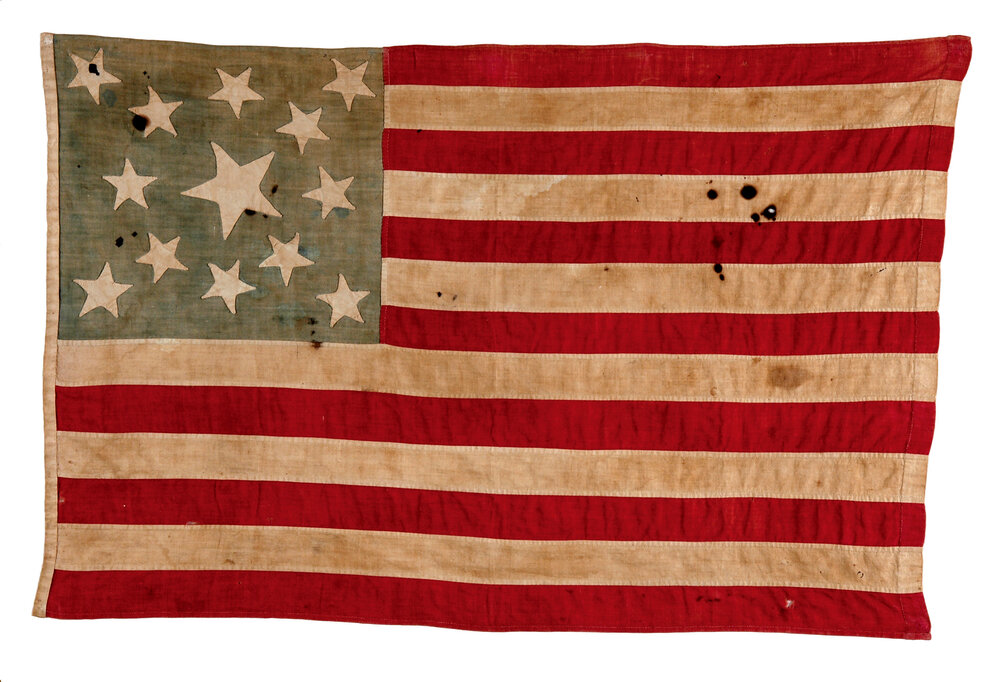
c. 1876
Hand-sewn cotton and appliquéd stars.
Wreath pattern with central star, flanked by star in each corner.
Following the Civil War and during the centennial celebration in 1876, a renewed spirit of patriotism swept across America and with it increased popularity and respect for the Stars and Stripes. Throughout the nation, homes, public buildings and businesses were proudly decorated with flags and patriotic banners. It was a time when flag designers, limited only by their own imagination, created a variety of star patterns.
35-STAR GEORGE BLISS FLAG
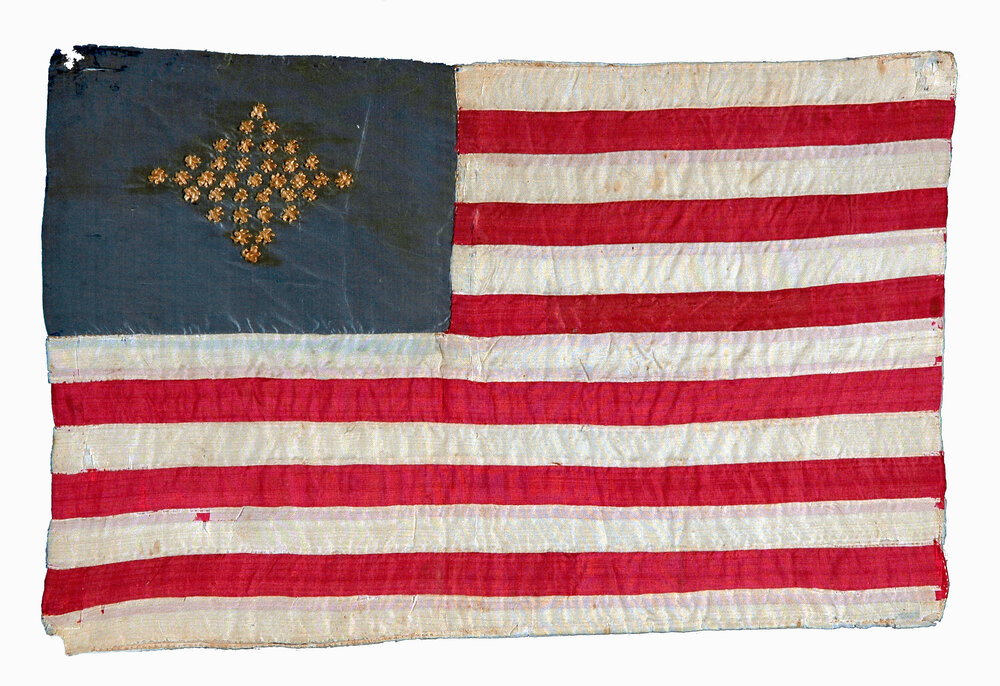
c. 1865
Hand-sewn silk.
Diamond pattern with embroidered gold stars; stripes in white and red sequence.
Handwritten note: Waved at the return of the 1st R.I. Regt, Capt. George N Bliss Commanding Officer. April 9, 1865. Made by Annie Francis Carpenter.
The 1st Rhode Island Cavalry regiment organized at Pawtucket in December 1861 and mustered out in Baltimore in August 1865. The regiment served in Virginia with Sheridan’s Army, in the Shenandoah Valley Campaign, at the Battle of Gettysburg and in the defense of Washington.
Captain Bliss was awarded the Medal of Honor for heroic actions during the Battle of Waynesboro, Virginia on September 28, 1864. He received three saber wounds, his horse was shot and he was taken prisoner.
48-STAR 18th U.S. INFANTRY FLAG
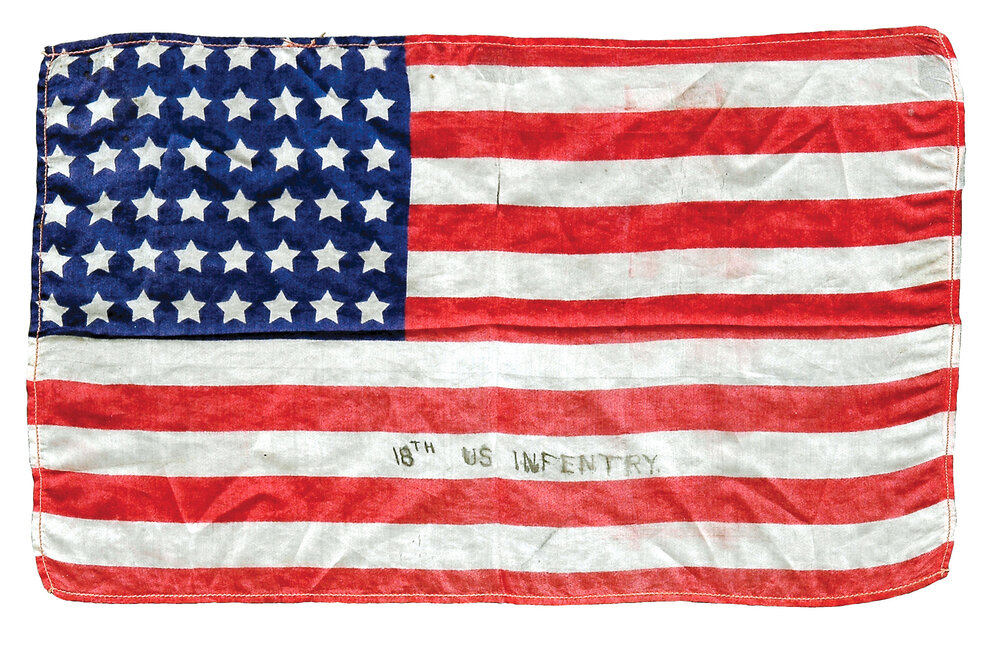
c. 1918
Printed on silk.
Inscription on fifth white stripe: 18th US Infentry” (sic)
The 18th Infantry Regiment was organized in New York in June 1917 and assigned to the 1st Expeditionary Division. In May 1918, it took part in the battle of Contigny, the initial offensive action conducted by U.S. military forces against the Germans. The regiment was awarded two French Croix de Guerre and the French Fourragere for its part in the Soissons offensive and operations around Exermont.
The First Division, known as the “Big Red One,” is the oldest continuously serving division in the U.S. Army. Its shoulder patch, a red numeral “1” on a solid olive green background, dates back to World War I.
48-STAR BUY WAR BONDS FLAG
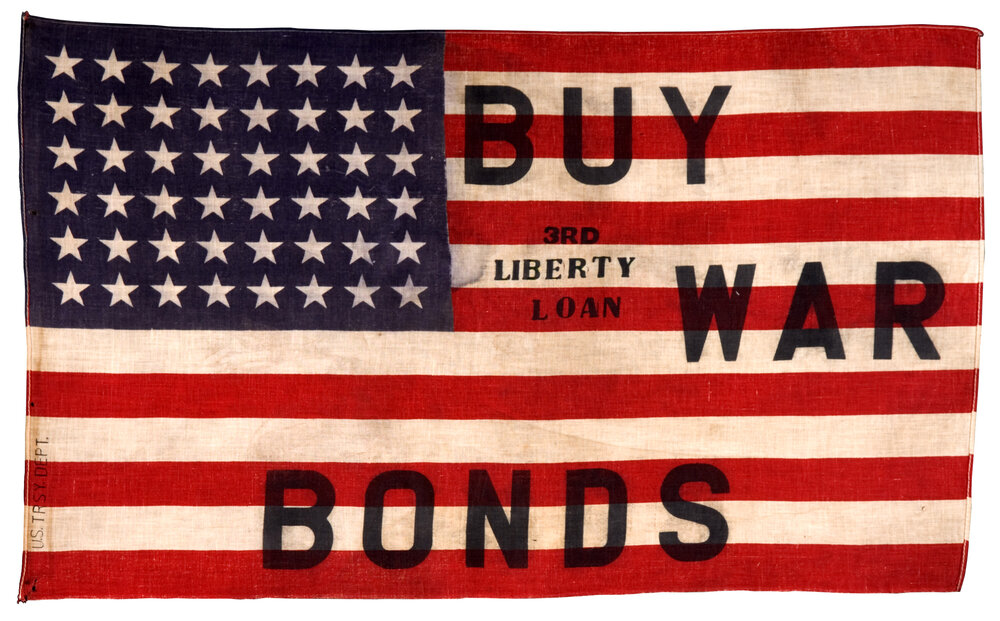
c. 1917-18
Printed on cotton.
Ink inscription along lower left hoist end: “U.S. Trsy Dept.” Stamped overprint: Buy War Bonds Third Liberty Loan
When the United States entered World War I, large sums of money were needed to fund the allied war effort in Europe. To raise the necessary financial support, an aggressive campaign was created by Secretary of the Treasury William McAdoo to sell war bonds, a special type of bond that could be redeemed for its original value plus interest, to the American public. Famous artists designed posters and movie stars and other celebrities hosted rallies and made personal appearances to promote the concept that purchasing a liberty bond was the patriotic thing to do. Boy Scout and Girl Scout troops sold bonds using the slogan “Every Scout to Save a Soldier.”
A series of four Liberty Loan notes were approved by Congress between April 1917 and September 1918, raising more than 18 billion dollars. The Third Liberty Loan was offered for sale on April 6, 1918, the first anniversary of the declaration of war by the United States. Issue terms included a ten year maturity and 4.5% annual interest rate; the amount subscribed and issued was 4.2 billion dollars. Bonds were exempt from federal income tax and state and local taxes, but not from estate and inheritance taxes.
48-STAR SAINT PETERS BASKETBALL FLAG

c. 1938
Printed on cotton.
Ink inscription: St. Peter’s High Home-Coming 1938 Eastern-States Basketball Champions (March 28) First Team Co-Captain Vinnie Reagen (All-State-1938) – Co-Captain Billy Harkins – Jimmie Hearn – Jack Kelly –Bill Borinheimer – J-V or Second String – Johnson – Tacacks – Clark – Burns – Dougherty
Written vertically on the stars are the names of the team’s starting five players during the St. Peter’s High School, New Brunswick, New Jersey, 1938-39 basketball championship season. The team won the State Parochial Championship as well as the Eastern States Invitation Tournament. This flag commemorates a homecoming celebration and has inscribed on its stripes the names of all the team members.
13-STAR MABEL MAYER FLAG

c. 1892
Printed on glazed cotton muslin.
Wreath pattern with central star, flanked by star in each corner.
Pencil inscription: Mabel Florence Mayer 9 years old was Goddess of Liberty in her class at Sherman School in 1892 Columbus celebration.
In 1892, President Benjamin Harrison issued a proclamation declaring October 12 as the first official Columbus Day holiday in the United States marking the 400th anniversary of the discovery of America. The public responded enthusiastically, putting on plays and singing songs about Columbus, organizing school programs and community activities across the country. Columbus Day was designated a national holiday by President Franklin Roosevelt in 1937 and since 1971 has been celebrated on the second Monday in October.
The inscription on this flag so proudly records a special occasion in which Mabel Mayer, a young elementary schoolgirl plays the role of the Goddess of Liberty (Statute of Liberty) in a program celebrating the discovery of America.
48-STAR JAPAN SURRENDER FLAG
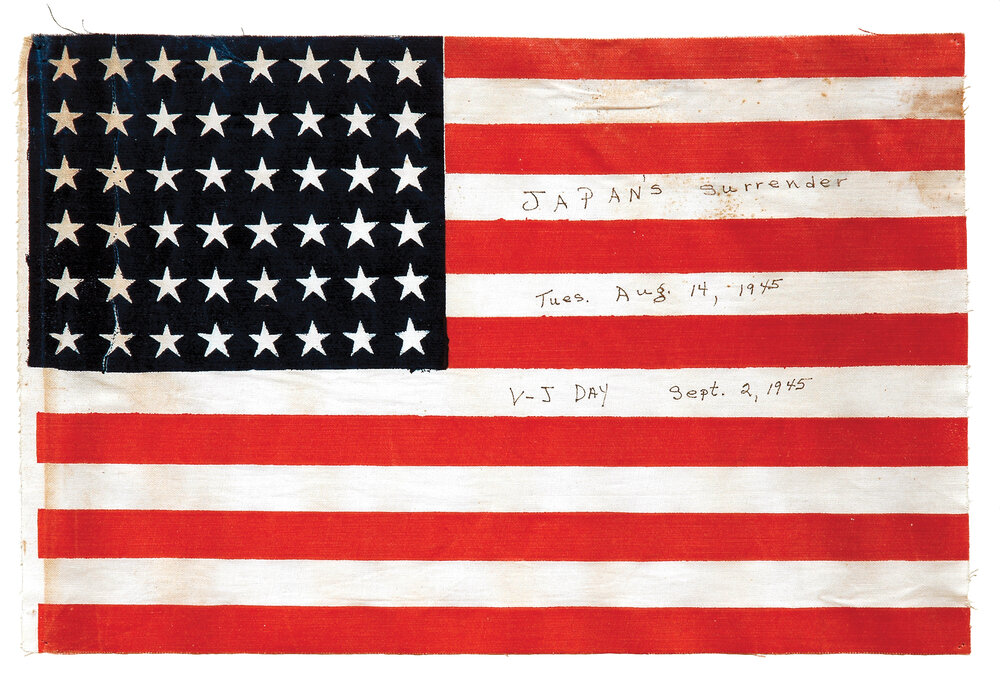
c. 1945
Printed on cotton.
Handwritten inscription: Japan’s Surrender Tues. Aug. 14, 1945 V-J Day Sept. 2, 1945
It had become evident during the early days of August 1945 that the time had come for Japan to surrender, yet the Japanese military hoped the coming invasion of its mainland would result in heavy losses of American forces, thereby making possible a more favorable negotiated peace.
On August 6, 1945, the United States dropped an atomic bomb on Hiroshima and three days later conducted a similar bombing of Nagasaki. These events failed to induce Japan’s military leaders to concede defeat, but their resistance was overcome by Emperor Hirohito’s decision on August 14 to accept the terms of surrender and end the war. The actual surrender document was signed aboard the USS Missouri on September 2.
48-STAR S.S. AMERIKA FLAG
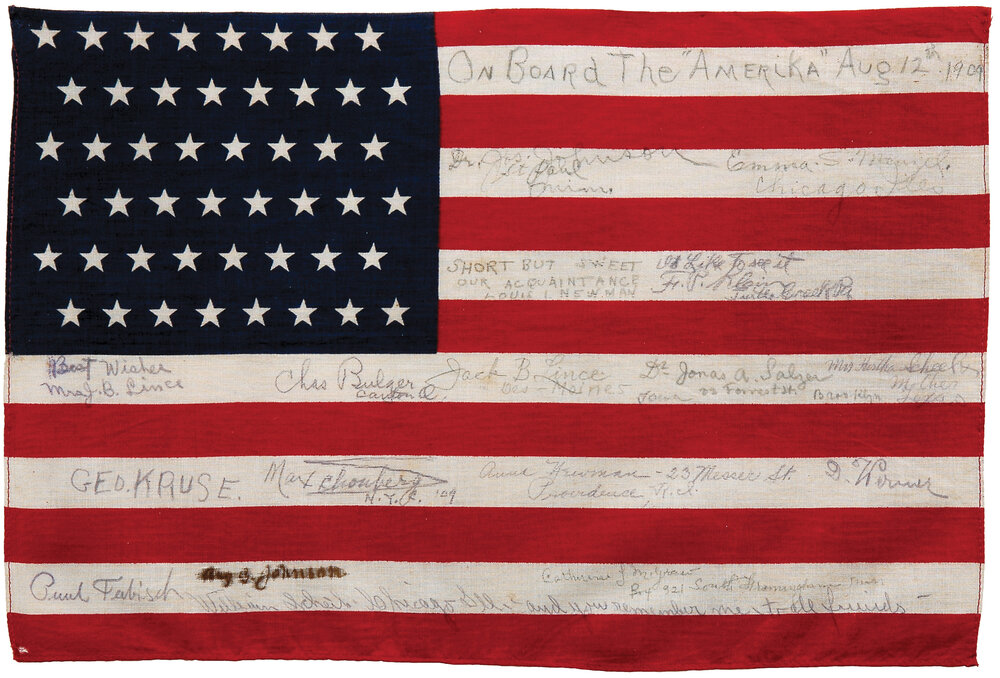
c. 1909
Printed on cotton.
Staggered pattern.
Handwritten inscription: On board the ‘Amerika’ Aug 12th 1909 (with) signatures of 17 ship passengers with address and/or home town.
The German passenger liner Amerika sailed its maiden voyage from Hamburg to New York in October 1905. The ship offered superior service and luxurious traveler accommodations. In spite of its many technological innovations, the ship was involved in a number of at-sea incidents, including one on April 10, 1912 (same day as maiden voyage of the Titanic) when the Amerika rammed and sank a British submarine off the coast of Dover.
In 1917, the ship was seized by the U.S. Navy, commissioned the USS America, and converted to a troop transport. After the war, the ship was rebuilt and served as a passenger liner until 1943 when it was reactivated as the U.S. Army transport Edmund B. Alexander. The ship was sold for scrapping in January 1957.
31-STAR FLAG
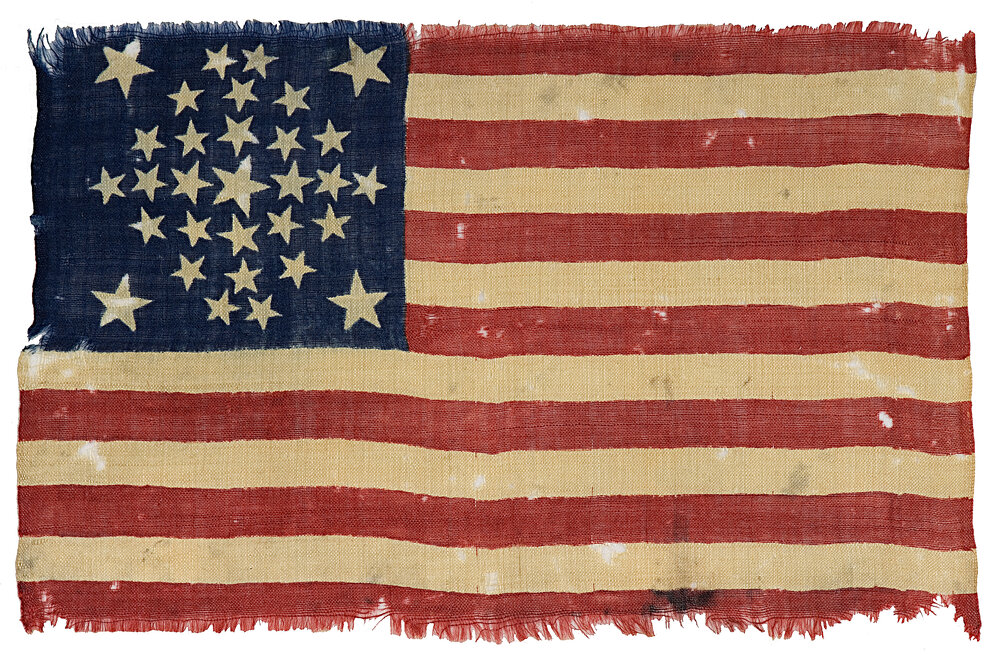
c. 1858-59
Printed on wool.
Modified diamond pattern with central star, flanked by star in each corner.
The Treaty of Guadalupe Hidalgo, ending the two-year Mexican-American War, was signed on February 2, 1848, and under its terms, Mexico ceded California and several southwestern territories to the United States. In the ensuing period, Congress failed to organize a legal form of government for California because it was deadlocked over the issue of slavery in newly-acquired territories.
In September 1849, Californians acted on their own and at a convention held in Monterey adopted a state constitution, including a provision to prohibit slavery. The constitution was approved by popular vote in November and the following month the first legislature met to create an unofficial state government.
The Compromise of 1850, a series of bills introduced in the Senate by Henry Clay and supported by Stephen Douglas and Daniel Webster, was proposed to resolve the major slavery controversies arising from the Mexican-American War. Among its most important provisions, the legislation ensured that a balance between free states and slave states would be maintained, which paved the way for California to be admitted to the union on September 9, 1850, as a free state.
42-STAR 7th CAVALRY PARADE GUIDON
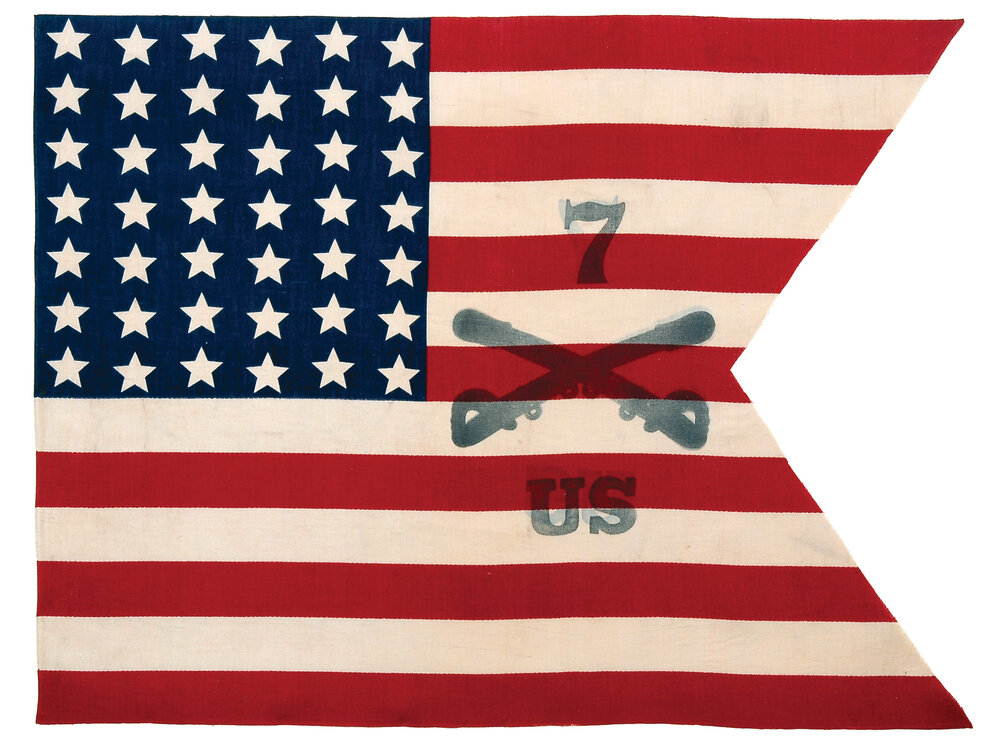
c. 1889
Parade guidon printed on cotton.
Stenciled overprint: 7 [crossed sabers] US
A guidon is a military flag or pennant carried by a cavalry company to identify its location on the battlefield and to signal troop movements. The size and shape of the usual regimental flag was not suitable for the mounted cavalry soldier so a swallowed tail design was adopted which enabled the colors to fly in the wind as the horseman galloped.
This guidon of the 7th Cavalry was used solely for ceremonies and parades at Fort Sheridan, Illinois.
COAST GUARD COMMISSIONING PENNANT

c. 1930–45
Cotton muslin; single brass grommet.
Thirteen blue stars in diminishing size on a white field; sixteen vertical stripes of equal width, alternate red and white, with a red swallow tail.
Inscription stamped in black ink at hoist end:
C.G. No. 7.
The Coast Guard was formed in 1915 under control of the Treasury Department, but design of its commissioning pennant dates to 1799 when it was specially created for the Revenue Cutter Service, alternately known as the Revenue Marine Service. The thirteen stars represent the original colonies and the sixteen stripes the number of states in the Union at the time the pennant was designed in 1799. Following the Civil War, the Revenue Service adopted the identical commissioning pennant as the Navy, thirteen white stars on a blue field and thirteen vertical red and white stripes. The old pennant was revived in 1938.
The hoisting of the commissioning pennant is a key moment in the commissioning of a new coast guard cutter. Once hoisted, it flies until the vessel is decommissioned.
34-STAR JOSEPH J. JANNEY FLAG
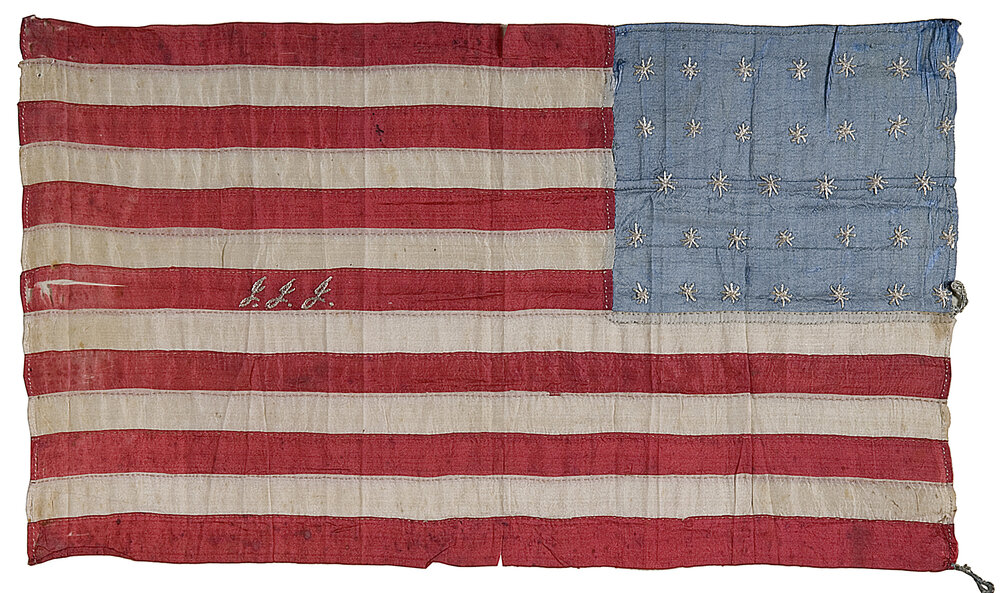
c. 1861-65
Hand-sewn silk stripes and embroidered eight-pointed stars. Initials “JJJ” embroidered in gold on fourth red stripe.
This flag was carried during the Civil War by Joseph J. Janney, a member of Company C, Purnell Legion Cavalry, organized in Baltimore and initially stationed at Camp Bradford. After being assigned to Harper’s Ferry and later Wilmington, Delaware, the company transferred to the Purnell Infantry and saw extensive action in several battles as part of the Army of the Potomac. Janney mustered in as a private in September 1862 and was discharged with the rank of sergeant in December 1864.
46-STAR GREAT WHITE FLEET FLAG
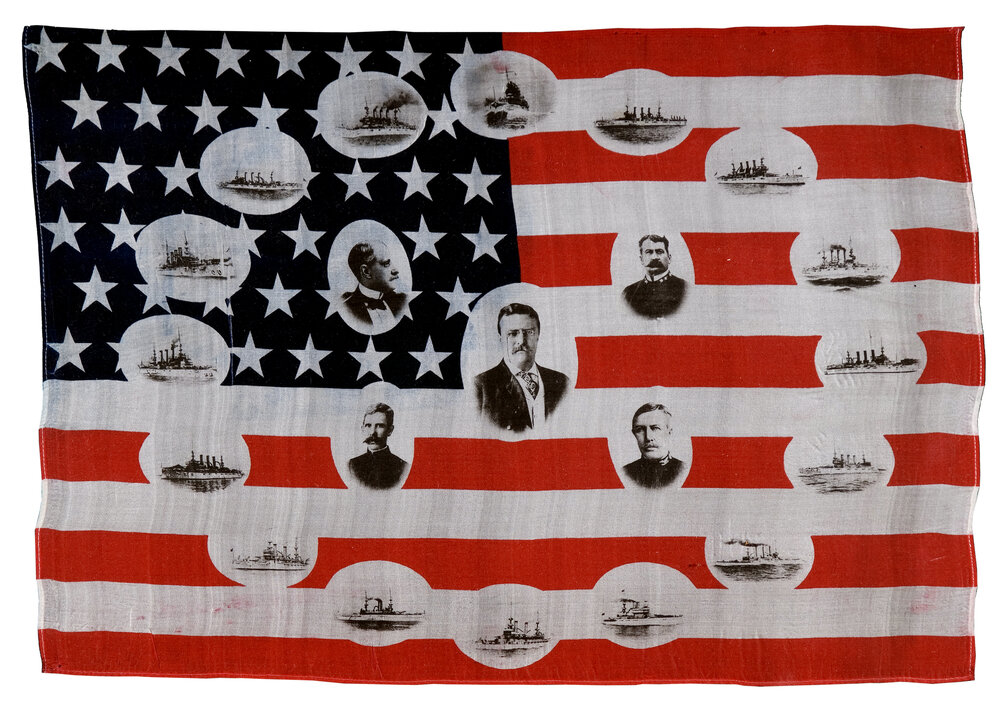
c. 1907-09
Printed on silk.
Oval images of sixteen American battleships encircling the portraits of President Theodore Roosevelt, Rear Admirals Charles Sperry, William Emory, Charles Thomas and Robley Evans superimposed on stripes.
The Great White Fleet, a United States naval force consisting of sixteen battleships painted white with gilded scrollwork and red, white and blue banner on their bows, was sent around the world by President Theodore Roosevelt from December 1907 to February 1909 to showcase American military strength and sea power. The fleet consisted of four squadrons, each with four battleships and escorts, and 14,000 sailors. The fourteen-month, worldwide voyage covered 43,000 miles and made twenty port calls on six continents. In every port, thousands turned out to greet the Americans and to get a glimpse of the ships.
The fleet sailed from Hampton Roads, Virginia under the command of Rear Admiral Robley D. Evans aboard the USS Connecticut as flagship. Due to poor health, Evans was later replaced by Rear Admiral Charles S. Sperry. The historic cruise provided the officers and sailors with a revitalized sense of pride in their service to our country and a unique opportunity to serve as ambassadors of good will for America and the United States Navy.
26-STAR FLAG
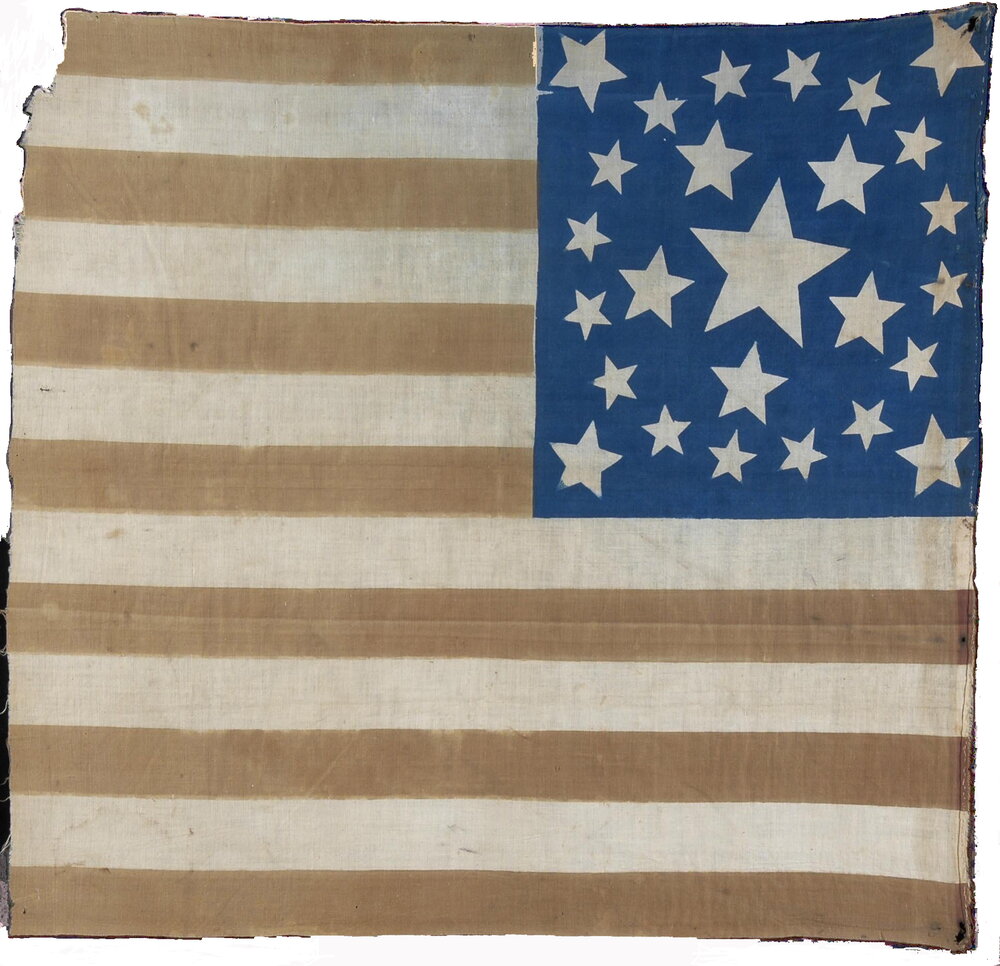
c. 1837-45
Printed on cotton.
Double medallion pattern with central star, flanked by star in each corner.
Parade flags made prior to the Civil War are extremely rare, and only a dozen or so twenty-six star flags are known to exist, most of which are Great Star patterns. This double medallion with various-sized stars is unique in its design and may be one of only a few surviving examples.
31-STAR BELL 1860 CAMPAIGN FLAG
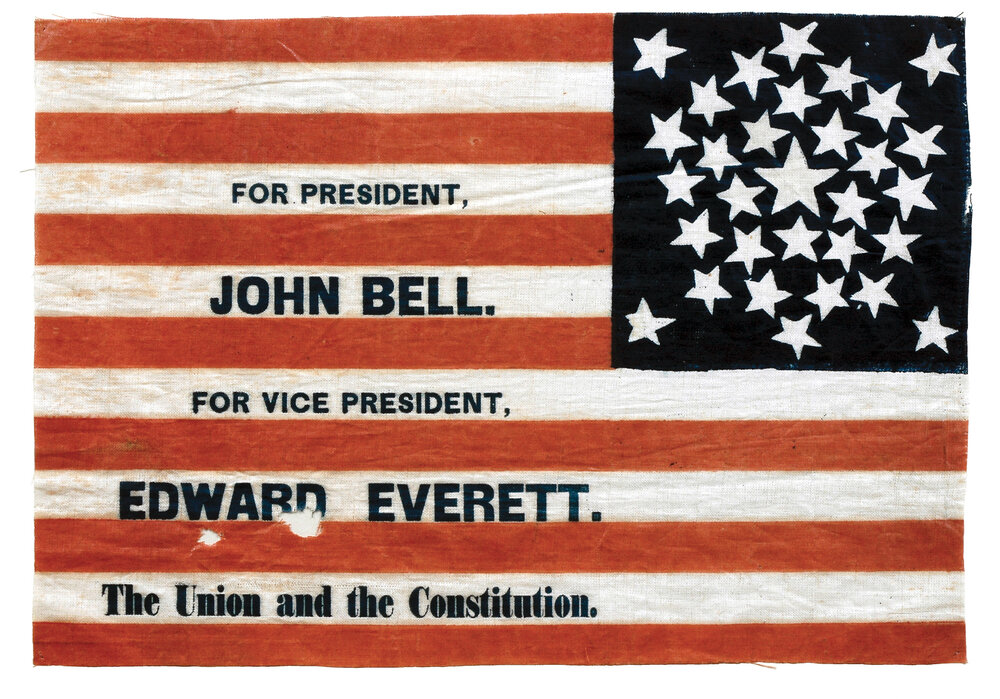
c. 1860
Printed on polished cotton.
Pentagon pattern with outlying star, flanked by star in each corner.
Overprint: For President, John Bell. For Vice President, Edward Everett./The Union And The Constitution.
The Constitutional Union Party was formed in 1860 at a time of growing conflict over the issue of slavery within the Republican and Democratic Parties. Comprised primarily of Whigs and Know-Nothings, the newly-formed third party presented a modest election platform of adherence to the Constitution, the Union and enforcement of laws.
John Bell was born in Nashville, served in the House and Senate, was Speaker of the House and for a short time Secretary of War under President William Harrison. His vice-presidential running mate, Edward Everett, was a Harvard professor, served in Congress and was elected Governor of Massachusetts.
In the election of 1860, Bell carried the states of Virginia, Kentucky and Tennessee. He garnered more electoral college votes than Stephen Douglas, however both men lost by a wide margin to Abraham Lincoln.
44-STAR HENRY ALTHOFF ADVERTISING FLAG

c. 1896-1908
Printed on silk.
Overprint: Compliments of Henry Althoff “The Doctor” Sample, Meeting and Lunch Room, Cor. Livingston St., 251 Springfield Ave, Newark, N.J. Government Steam Launch, 42 ft. long, to Let for Pleasure and Fishing Parties.
The flag was often a popular medium to promote a variety of goods and services, including food items, tobacco, games, liquor products and other forms of commercial merchandise. All of this occurred much to the displeasure of veterans and patriotic organizations as well as legislative bodies, both at the federal and state level. Through the lobbying efforts of committees and veterans groups concerned with protecting the flag, by 1905, thirty-two states had enacted flag protection laws. Passage of a national law remained stymied in Congress until 1968.
48-STAR WOMEN’S RELIEF CORPS FLAG
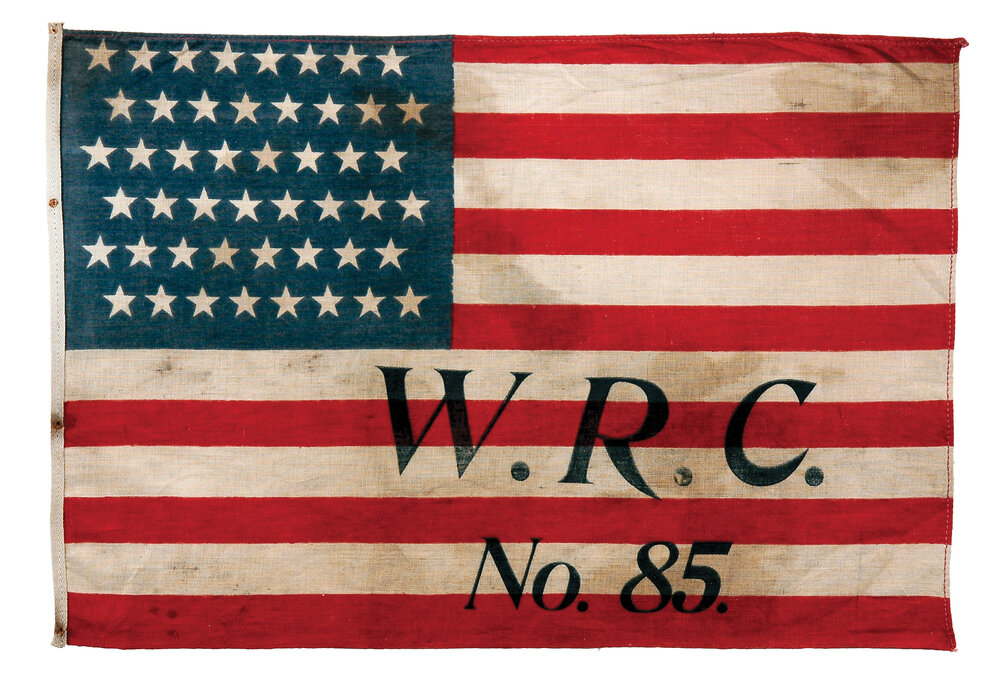
c. 1912-59
Printed on cotton.
Staggered pattern.
Stamped overprint: W.R.C. No. 85.
The Women’s Relief Corps was founded as an auxiliary of the Grand Army of the Republic in Denver in 1883 and incorporated by an act of Congress in September 1962. Organized into state and local chapters, initially membership was limited to relatives of Civil War veterans. The WRC was established to care for disabled veterans and to see to the needs of Civil War widows and orphans. Today its purpose is to honor those who have served our country in war and to promote patriotism by teaching the principles of citizenship.
The origins of this flag can be traced to Wiley Post No. 85, Bowling Green, Ohio, organized with forty-two charter members in June 1885 and ceased activity in 1974.
38-STAR FLAG

c. 1876
Printed on glazed cotton muslin.
Square surrounding wreath with large central star.
The thirty-eight-star flag representing Colorado statehood did not become official until July 4, 1877, however the star count was widely used on flags a year earlier during America’s centennial celebration.
13-STAR SALEM PARADE FLAG
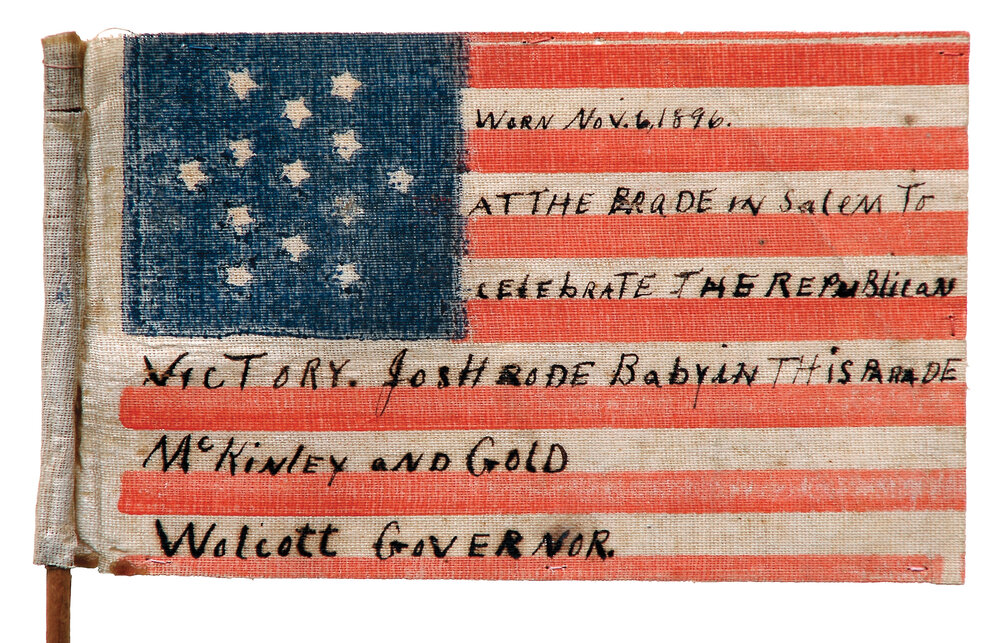
c. 1896
Printed on glazed cotton muslin.
Six-pointed Great Star pattern.
Handwritten inscription: Worn Nov. 6, 1896. At The Parade in Salem To Celebrate The Republican Victory. Josh Rode Baby in This Parade. McKinley and Gold Wolcott Governor
The election of 1896 was a contrast in styles between William McKinley with his “front porch” campaign and flamboyant orator William Jennings Bryan, who traveled across the country making speeches before large audiences. In the end, the voters chose Republican candidate McKinley, a strong supporter of the gold standard, by a convincing margin over Bryan, an advocate of the pro-silver movement.
Roger Wolcott was born in Boston in 1847, and after graduating from Harvard Law School, served as a member of the state legislature. He was elected lieutenant governor in 1892 and succeeded Governor Frederic Greenhalge who died in office. In 1896, Wolcott was elected governor of Massachusetts and served three terms.
48-STAR CRÈME SALON FLAG
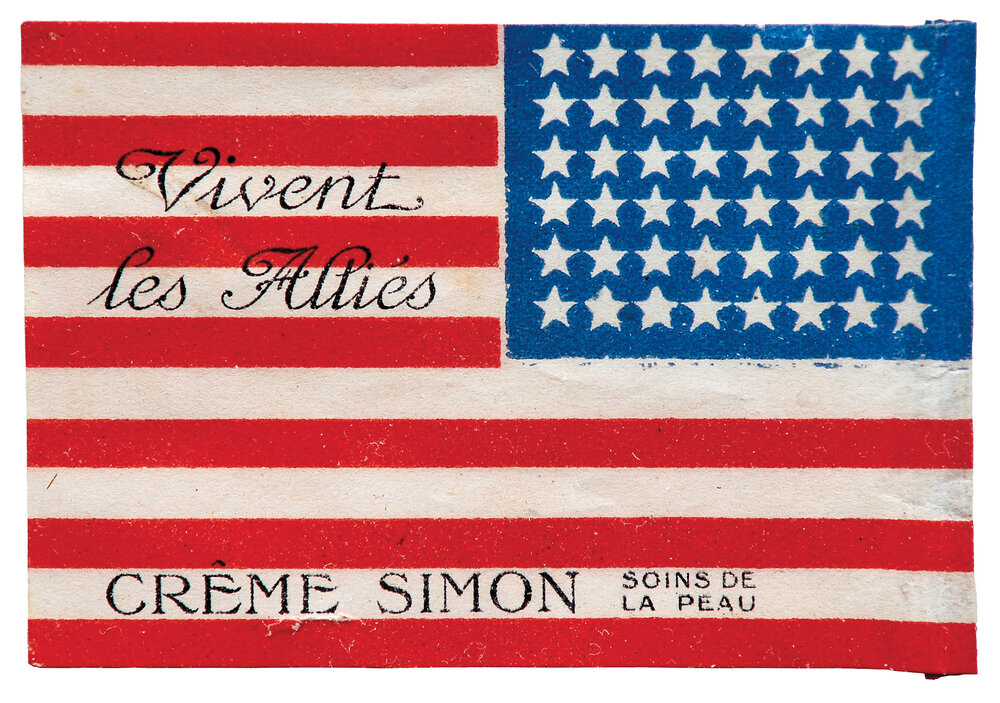
c. 1945
Printed on paper.
Overprint: Vivent Les Allies Crème Simon Soins De La Peau
A patriotic advertising flag distributed at the end of World War II by Simon Crème as a tribute to the American armed forces for their role in liberating France from occupation by the Germans. The flag with its slogan “Hooray for the Allies” was also used by the company to promote one of its woman’s skin care products.
48-STAR PEARL HARBOR FLAG

c. 1941-45
Printed on cotton.
Overprint: Remember Pearl Harbor Dec 7, 1941
Following the Japanese attack at Pearl Harbor, a resolute spirit of nationalism swept across America. United in spirit, millions of men and women joined the armed services and fought valiantly on battlefields throughout Europe and the Pacific. On the home front, Americans worked in factories and shipyards to build planes, tanks, ships and other weapons needed to successfully wage war against our enemies. It was the heroic deeds of these citizens that preserved our freedoms for future generations.
Patriotic items were produced with the motto “Remember Pearl Harbor” as a symbol of America’s resolve in the war effort.
13-STAR FLAG ON ENVELOPE
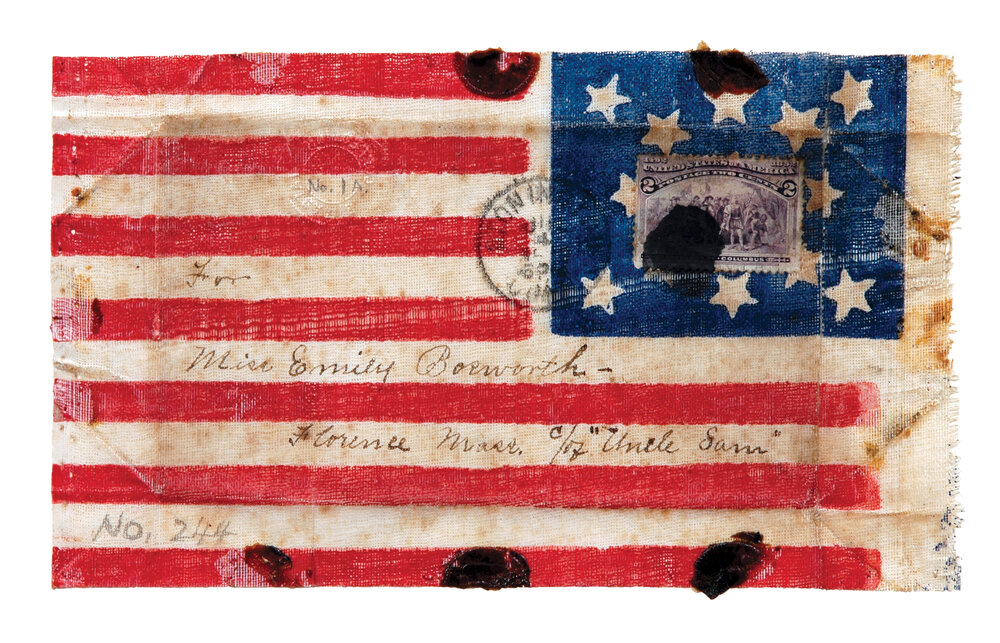
c. 1893
Printed on glazed cotton muslin.
Wreath pattern with central star, flanked by star in each corner. Affixed 2-cent 1893 Columbian Exposition stamp with post office cancellation.
Handwritten address: For Miss Emily Bosworth - Florence Mass C/of Uncle Sam
This flag was folded around a post card, sealed with red wax to form an envelope and mailed through the postal system. The cancellation is not completely legible but it appears to have been postmarked July 4, 1893 from Stonington, Connecticut. A two-cent Columbian Exposition stamp issued in January 1893 was used for postage.
44-STAR JOHN DREW FLAG
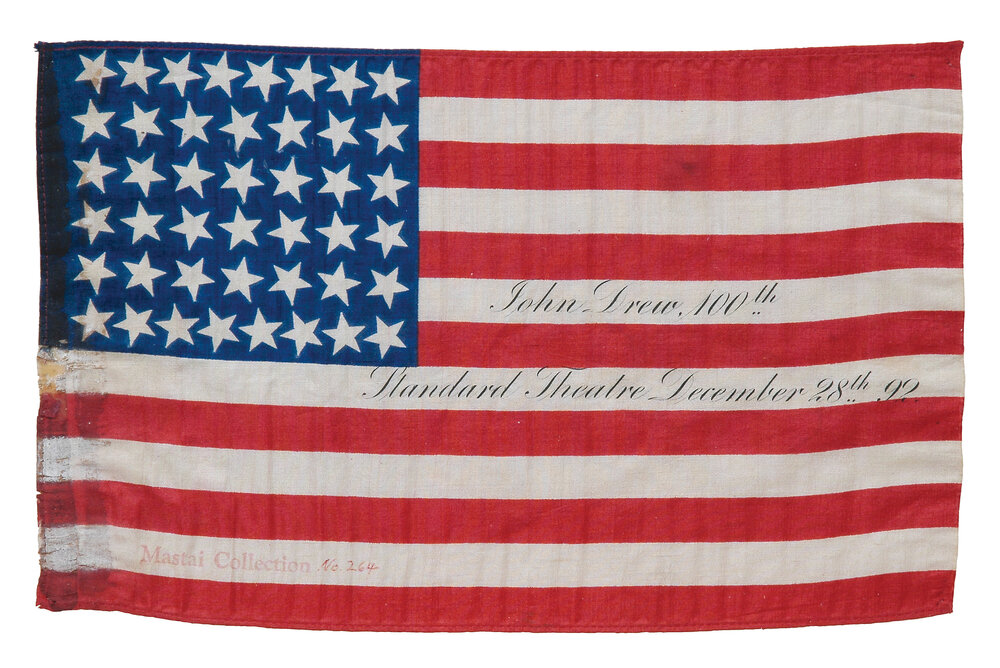
c. 1892
Printed on silk.
Overprint: John Drew 100th Standard Theater December 28th 92
John Drew, Jr. (1853-1927) was born in Philadelphia, the eldest child of parents who were stage performers and managed a theatre. As a young actor, Drew joined a Shakespeare company and for the next fifteen years performed in a number of plays. Later in his career he starred in modern comedies. His sister Georgiana married Maurice Barrymore, uniting two distinguished families of the stage. They had three children: Lionel, Ethel and John.
This flag celebrates the 100th performance of John Drew in “The Masked Ball” at the Standard Theatre (later named Manhattan Theatre) in New York City. The play also starred Maude Adams, another of America’s great stage actors.
13-STAR JULY 4th FLAG
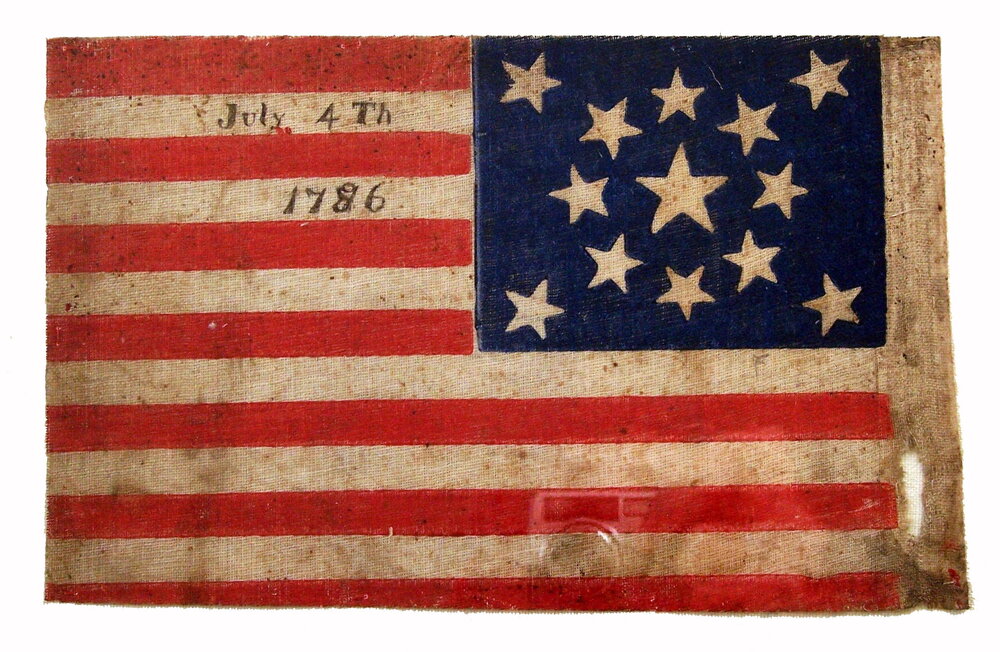
c. 1876
Printed on glazed cotton muslin.
Wreath pattern with central star, flanked by star in each corner.
Ink inscription: July 4th, 1786
The Civil War ended a decade earlier, and Americans were once again beginning to come together. The centennial provided the perfect opportunity to celebrate a century of progress and to look ahead to the future as one country, one people.
Most likely this flag dates to the centennial period. While it is not possible to determine for certain, the writer may have intended to inscribe July 4th 1876, honoring the one-hundredth birthday of America.
26-STAR GREAT STAR FLAG
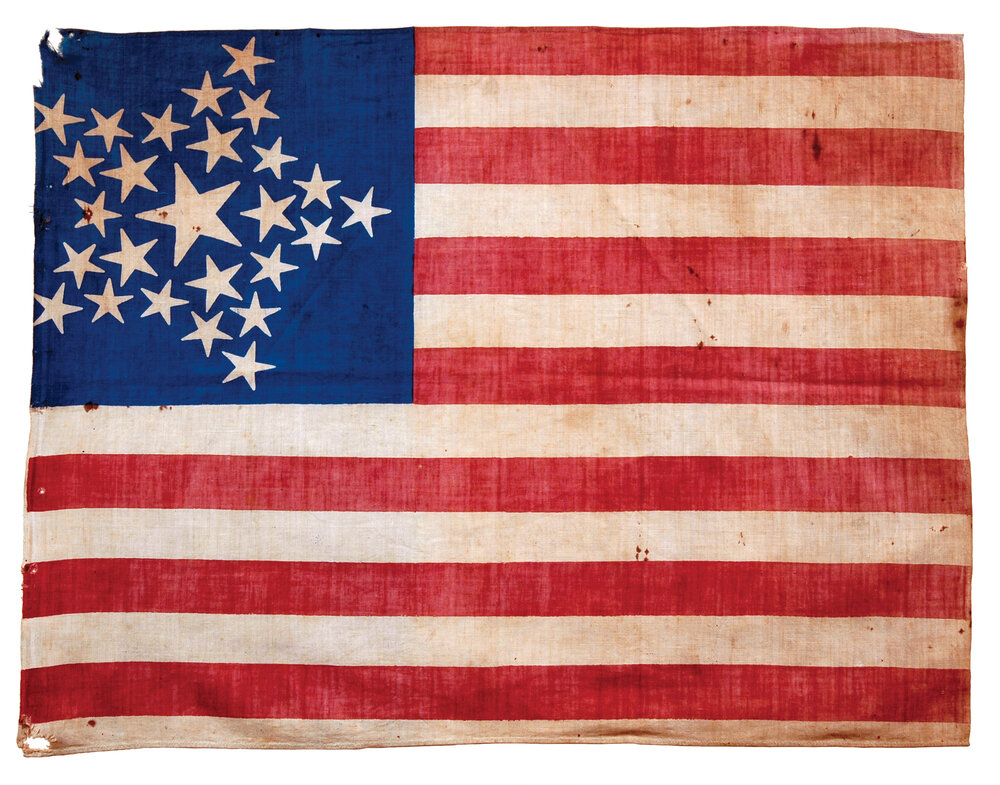
c. 1837-45
Printed on homespun cotton.
Great Star pattern.
At the request of a Congressional committee in 1818, naval hero Captain Samuel Reid recommended a new design to replace the existing flag of fifteen stars and fifteen stripes. Rather than adding an additional stripe and star for each new state, Reid suggested standardizing the use of thirteen stripes, representing the original colonies, and configuring the stars, one for each state, into a Great Star pattern, with stars for newly admitted states added on July 4 following the year of statehood.
The Third Flag Act signed by President James Monroe specified thirteen stripes and a star for each state, however the arrangement of the stars was not defined in the final legislation enacted by Congress. As a result, for nearly the next 100 years, the pattern of stars representing the states was left to the discretion of the flag maker.
Great Star patterns were commonly in use until the end of the nineteenth century.
45-STAR LOWELL SIGNATURES FLAG
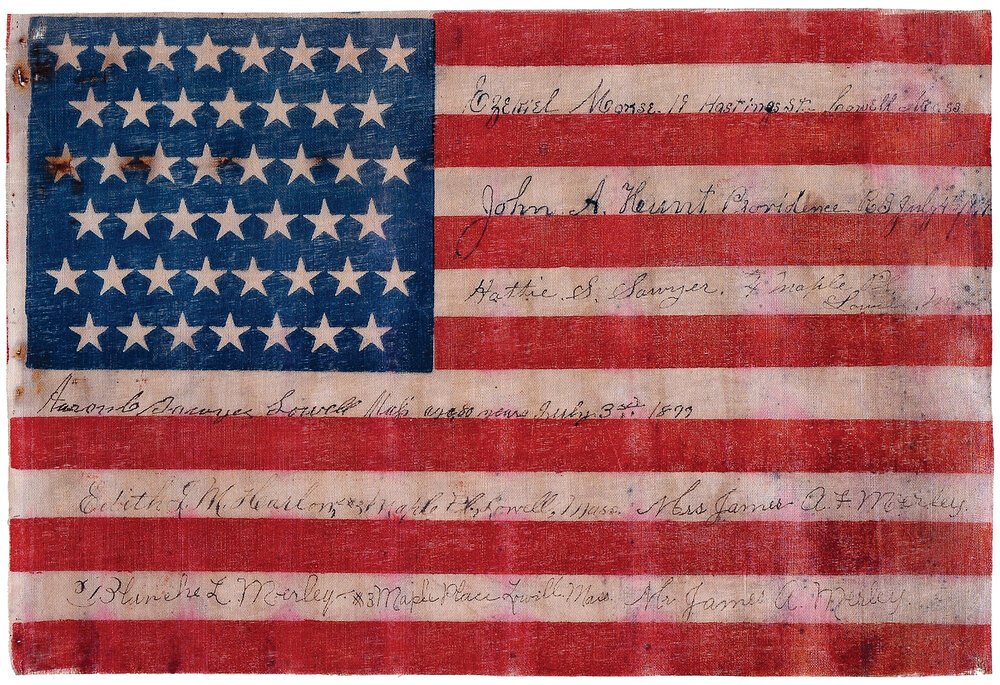
c. 1889
Printed on cotton.
Staggered pattern.
Handwritten notation: Ezekiel Morse 19 Hastings St. Lowell Mass. John A. Hunt Providence RI July 4th, 1899 Hattie S. Sawyer #4 Maple Pl. Lowell, Mass. Aaron C. Sawyer Lowell Mass. Age 80 Years July 3rd 1899 Edith L. M. Harlon #3 Maple Pl. Lowell, Mass. Mrs. James A.F. Merley Blanche L. Merley #3 Maple Place Lowell Mass. Mr. James A Merley
Possibly this flag was signed by family and friends to commemorate the 80th birthday of Aaron Sawyer during the July Fourth holiday in 1889.
38-STAR GREAT STAR FLAG
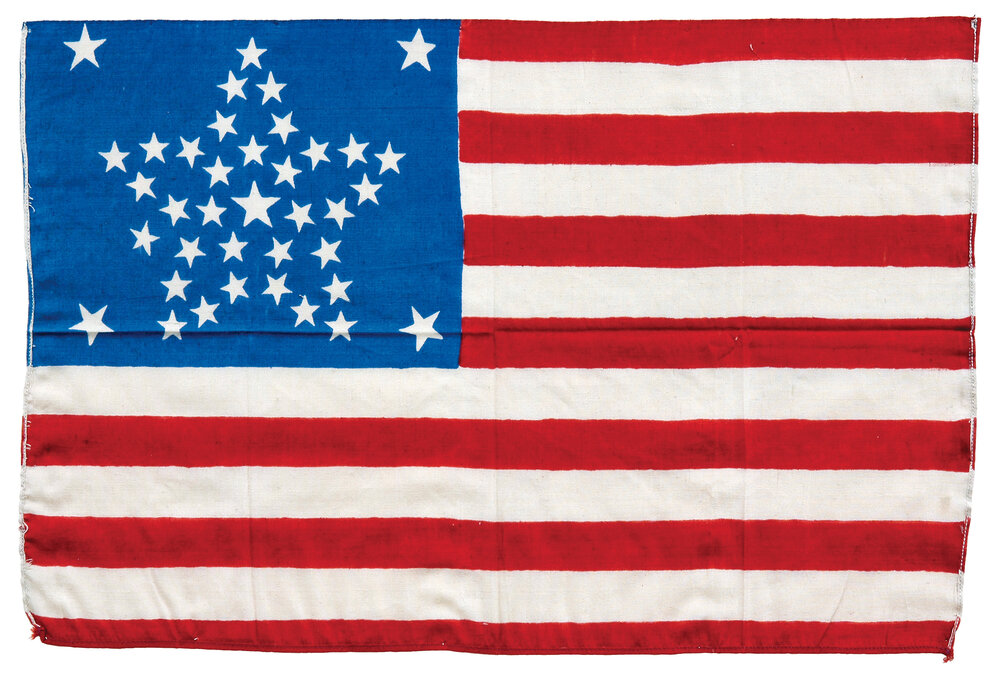
c. 1876-90
Printed on silk.
Great Star pattern, flanked by star in each corner with one outlying star.
A beautiful and delicate design more like a great flower than a Great Star. First appearing on flags in 1818, the great star pattern was in use for a longer period of time than any other form of the Stars and Stripes.
48-STAR COLEMAN FLAG

c. 1923
Printed on silk.
Inscription written on Wesley Coleman & Sons envelope: Flag placed on David Coleman’s casket by his comrades the Civil War veterans.
David O. Coleman, first child of Orrin and Susan Coleman, was born in Bradford County, Pennsylvania in November 1848. He died in April 1923 at the veteran’s home in Bath, NY and is buried in Floral City cemetery. David was married to Carrie Pipher (they divorced in 1884) and later Orpha Shores. He was a member of the local GAR Post and attended the 43rd New York State encampment held in Binghamton, June 15-17, 1909. His delegate badge from the reunion accompanied this flag.
David’s brother John Wesley moved to Binghamton, NY in 1883 and a few years later formed a contracting partnership under the firm name of Davis and Coleman. After devoting his time to government work during World War I, he organized J. Wesley Coleman and Sons, contractors and builders, which erected many business buildings and residences in Binghamton.
40-STAR PEABODY POST GAR FLAG
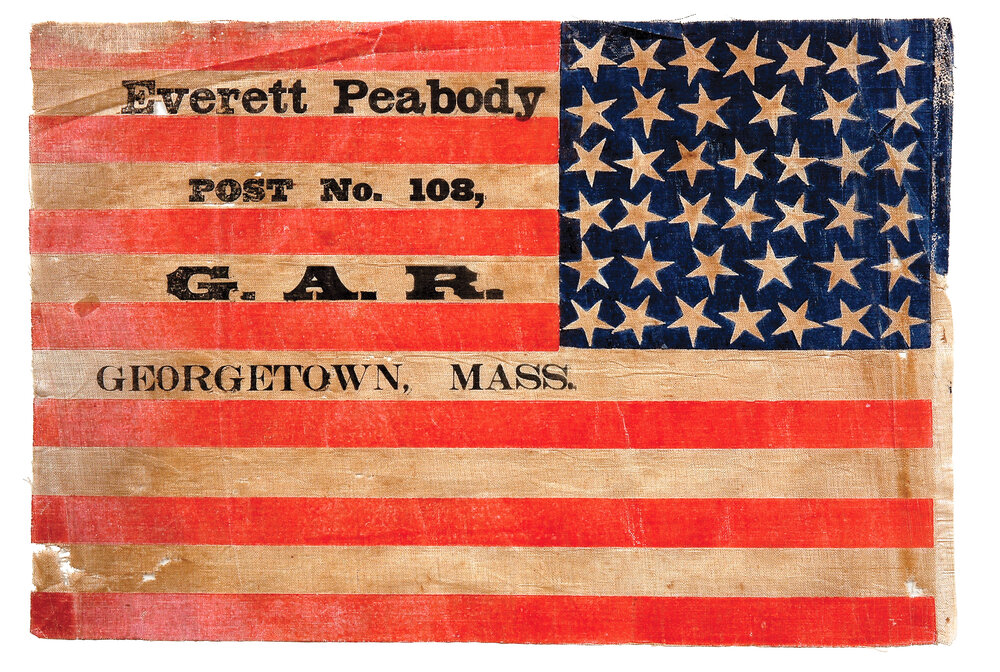
c. 1889
Printed on glazed cotton muslin.
Rare star count.
Overprint: Everett Peabody Post No. 108 G.A.R. Georgetown, Mass.
Colonel Everett Peabody commanded a brigade on the western flank of Grant’s Army at the Battle of Shiloh. Fearing a Confederate attack, Peabody became an unsung hero when he sent a reconnaissance force to strengthen the brigade’s position ordering his men to hold their ground if the enemy was encountered. Acting on his own, Peabody hoped to provide a warning to the Union Army in time to prepare for the coming onslaught. When the Confederates were engaged, Peabody and his men joined the battle. He was mortally wounded, but his action surprised the enemy and eventually led to their surrender.
A Harvard graduate, Everett Peabody is among one-hundred and thirty-six alumni who gave their lives on behalf of the Union cause and are so honored in Harvard’s Memorial Hall.
38-STAR CENTENNIAL FLAG
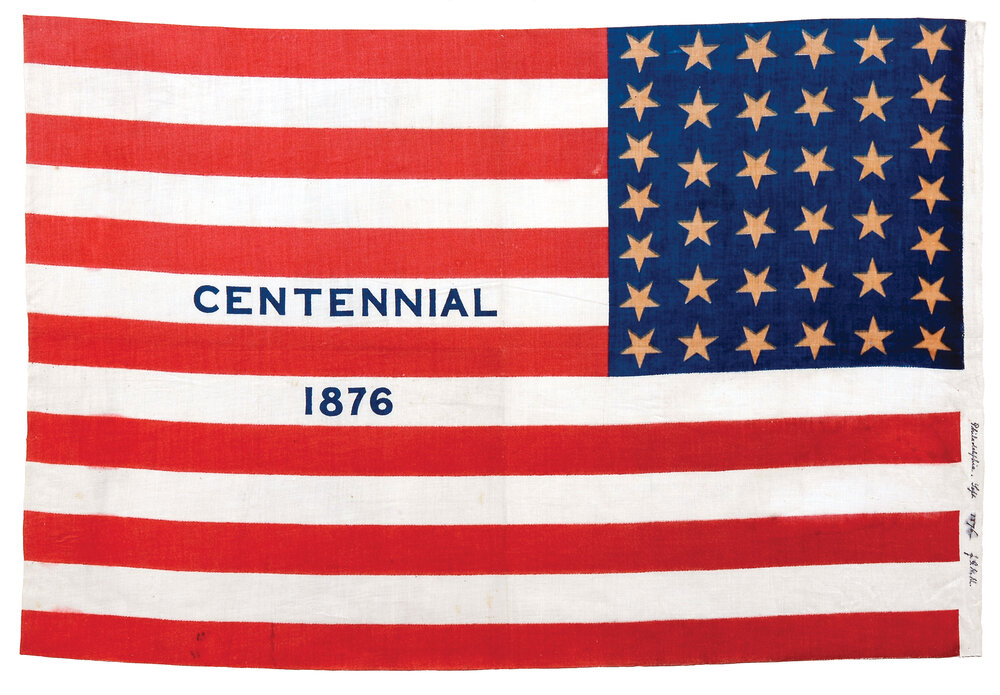
c. 1876
Printed on cotton.
Rare example of printed gold stars.
Inscription in selvage: Philadelphia, Sept 1876, G.N.M.
Overprint: Centennial 1876
This flag, specially designed for the nation’s centennial celebration that opened on May 10, 1876 in Philadelphia, is unique for several reasons. The printing on the stripes is not an overprint but rather was incorporated at the time the flag was manufactured, and the canton was printed intentionally in the upper right corner. Also, the use of gold stars on parade flags is virtually unknown.
37-STAR GRANT PARADE FLAG

c. 1880
Printed on silk.
Two handwritten notes accompany the flag, one reads:
In the fall of 1880, from the balcony of Roscoe Conklin’s house in the city of Utica (John Street), Gen. U.S. Grant received a grand torch-light procession of the Republicans- a procession in which the students of Colgate (then Madison) University marched. When Gen. Grant’s sharp eye caught sight of the large transparency that revealed the identity of our student company, his face was pleasantly lighted up, he uncovered his head, and graciously bowed, the boys enthusiastically rending the air with their college yell. I had this little flag with me in the procession. Many of the boys had brought them that day, and worn them as neckties. A man that fought so indomitably for the flag, ought to be saluted with it. So I saluted Grant with it. He has gone, but this flag is here.(signed) Thos. Broxholm.
Hiram Ulysses Grant was born in Point Pleasant, Ohio in 1822. A West Point graduate and outstanding military figure, he served from 1869-77 as the nation’s eighteenth president. Grant’s middle name was ‘Ulysses’ not Simpson as frequently reported, and he admitted that the ‘S’ in his name had no meaning.
38-STAR GAR BADGE FLAG
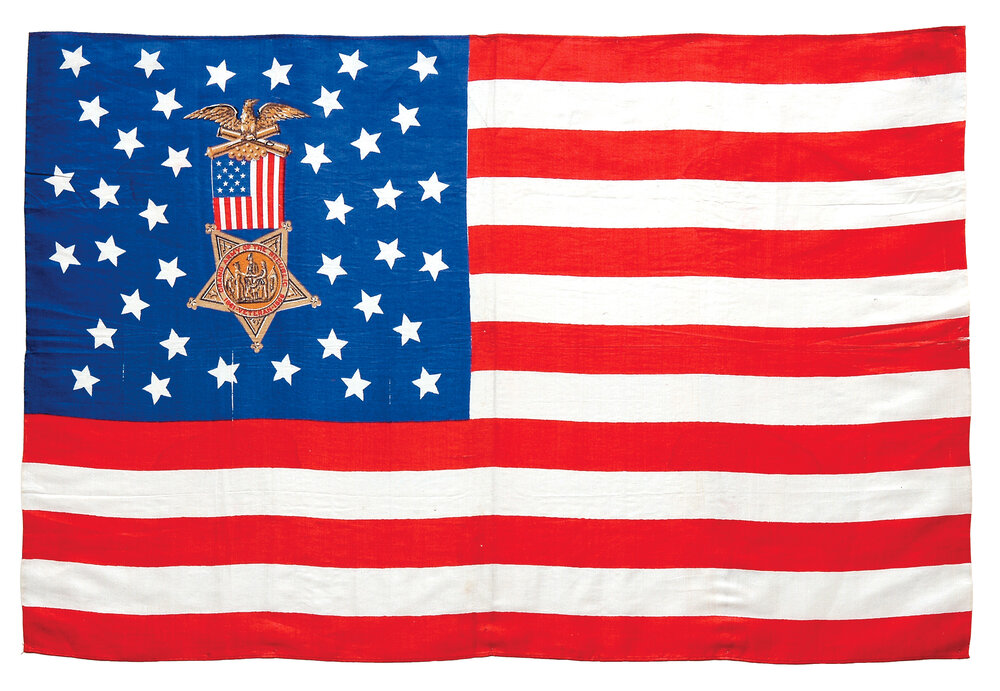
c. 1877-90
Printed on silk.
Modified triple medallion pattern surrounding image of the 1880 GAR membership badge.
The Grand Army of the Republic (GAR) was founded in 1866 by Dr. Benjamin F. Stephenson to provide fraternity among Union Army veterans who served in the Civil War and to actively support legislation advancing benefits to veterans and their families. The national organization reached a membership of nearly half a million in 1890 with posts in every state and overseas. The last member, Albert Woolsen, died in 1956 at the age of 109 years.
The original GAR membership badge was manufactured in the form of a shield but was redesigned in 1869 with a ribbon and badge resembling the Congressional Medal of Honor. Its similarity to the Medal of Honor caused a great deal of controversy, necessitating a new design in 1880. GAR badges were struck from captured Confederate cannon metal, with the last believed to have been produced around 1940.
41-STAR FLAG
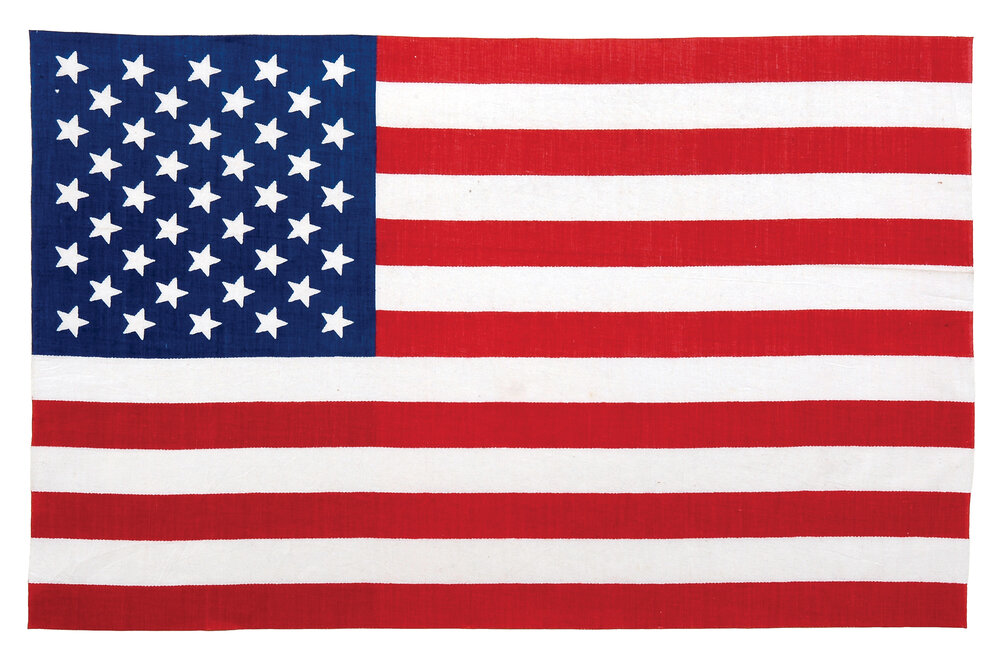
c. 1889
Printed on cotton.
Rare star count.
Staggered pattern.
On November 2, 1889, North Dakota and South Dakota were added as the thirty-ninth and fortieth states, the first and only time in history two states were admitted on the same day. Montana, the forty-first state, joined the Union on November 8, pre-dating Washington, the forty-second state, by three days. As a result of these rapid changes in the number of states, only a very small number of forty-one star flags was ever produced, thereby making them extremely rare.
36-STAR CENTENNIAL EXHIBITION FLAG
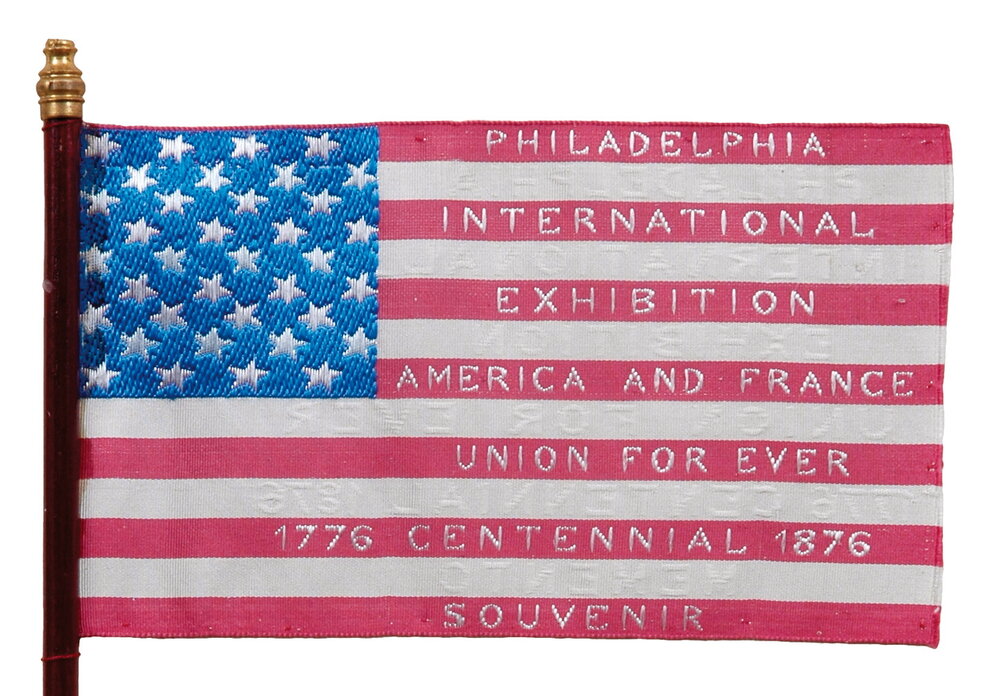
c. 1876
Woven silk.
Staggered pattern.
Inscriptions: [Obverse]: Philadelphia International Exhibition America and France Union Forever 1776 Centennial 1876 Souvenir./[Reverse]: Philadelphia International Exhibition Union For Ever 1776 Centennial 1876 Memento.
The Centennial Exhibition celebrating 100 years of American cultural and industrial progress took place at the Fairmount Park Fairgrounds in Philadelphia and marked the first time a major world’s fair was held in the United States. The event was immensely popular and introduced America as a new industrial world power.
Although there were thirty-seven states when the Centennial Exposition opened, this souvenir flag was produced with thirty-six stars, illustrating the liberty sometimes taken by flag makers to favor graphic design over historical accuracy.
48-STAR SERGEANT HARRY PAFF FLAG
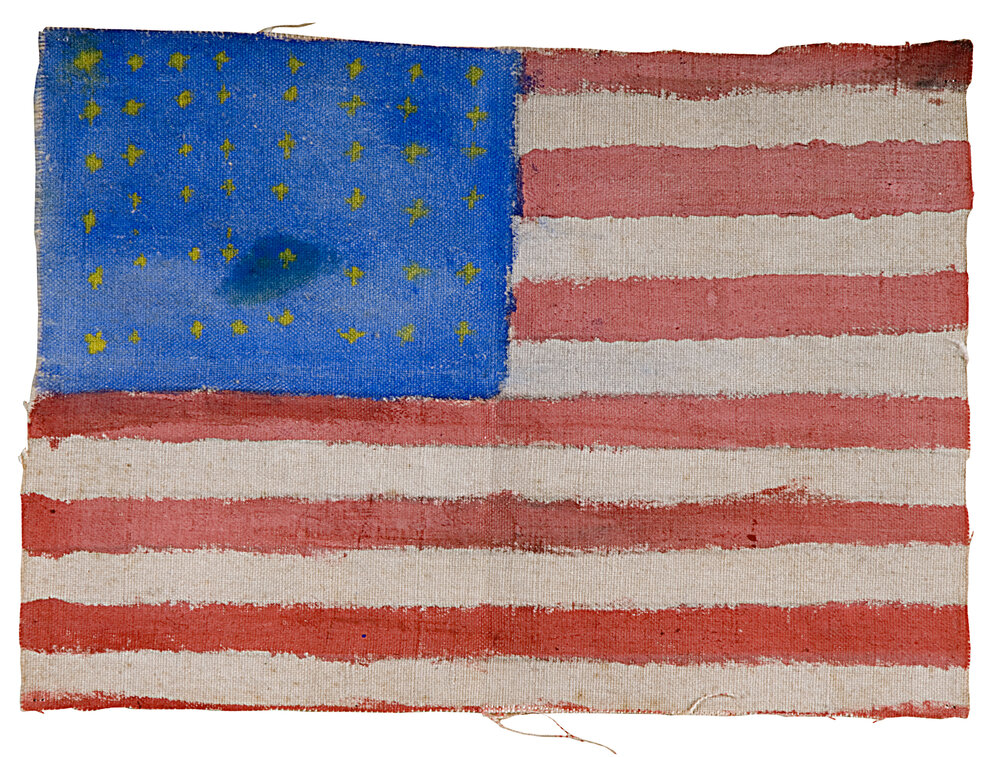
c. 1918
Hand painted on linen.
Ink inscription on reverse side of flag: Given to me by a little French boy at Hery, France Nov. 12, 1918. Made by him. Sargt. Harry Lat Paff Co. B 66 Regt. AM EF. France
The American Expeditionary Force, commanded by General John J. Pershing, fought alongside French and British units against the German army during World War I. The American soldiers, called “Doughboys” by the other allied troops, evolved into a modern, combat-tested army engaging in a number of major offensive operations during the closing months of the war.
When the armistice was declared on November 11, 1918, every town, every village in America and Europe celebrated the allied victory. Civilians gathered in the streets, singing and dancing, sharing their happiness and cheering the parading troops. Women and children pelted the soldiers with flowers, pressed flags in their hands and kissed them.
The story of this flag’s origin is a poignant reflection of the joy shared by the French people who were thankful to those who fought bravely to restore peace to their war-torn country.
44-STAR CLEVELAND PORTRAIT FLAG
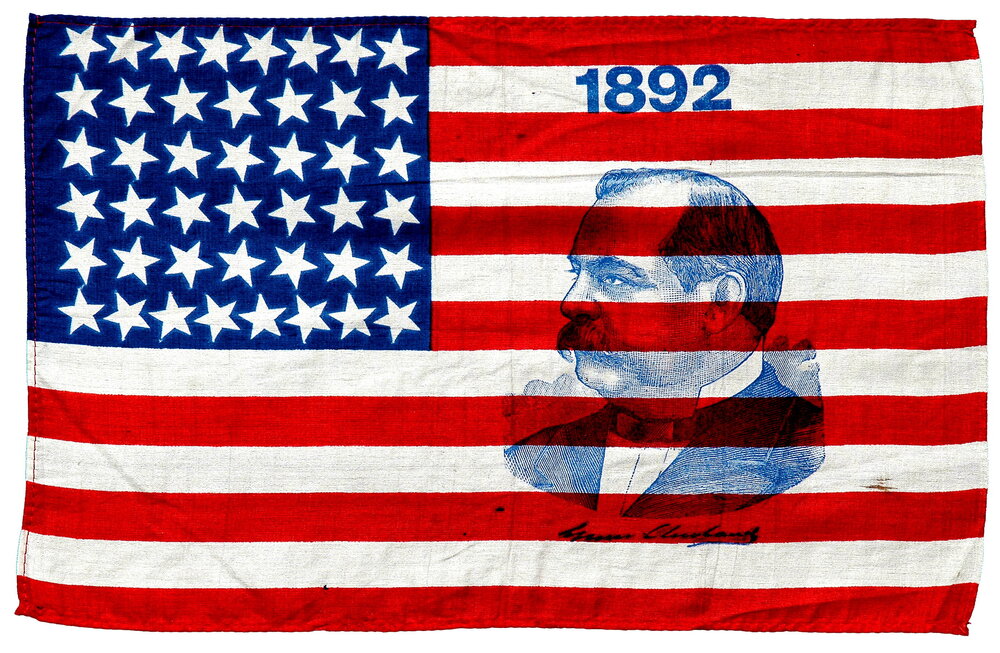
c. 1892
Printed on silk.
Image and facsimile signature of Grover Cleveland superimposed with stamped 1892 date.
Grover Cleveland was elected President in 1884 but lost his bid for re-election four years later to Benjamin Harrison, even though Cleveland won a larger popular vote.
They faced each other again in the election of 1892, a contest dominated by the issue of tariff policies and one in which neither candidate led a unified party. Cleveland won handily, outpolling both Harrison and third party candidate James Weaver. In doing so Cleveland became the first, and only president to date, to serve two non-consecutive terms.
44-STAR HARRISON PORTRAIT FLAG
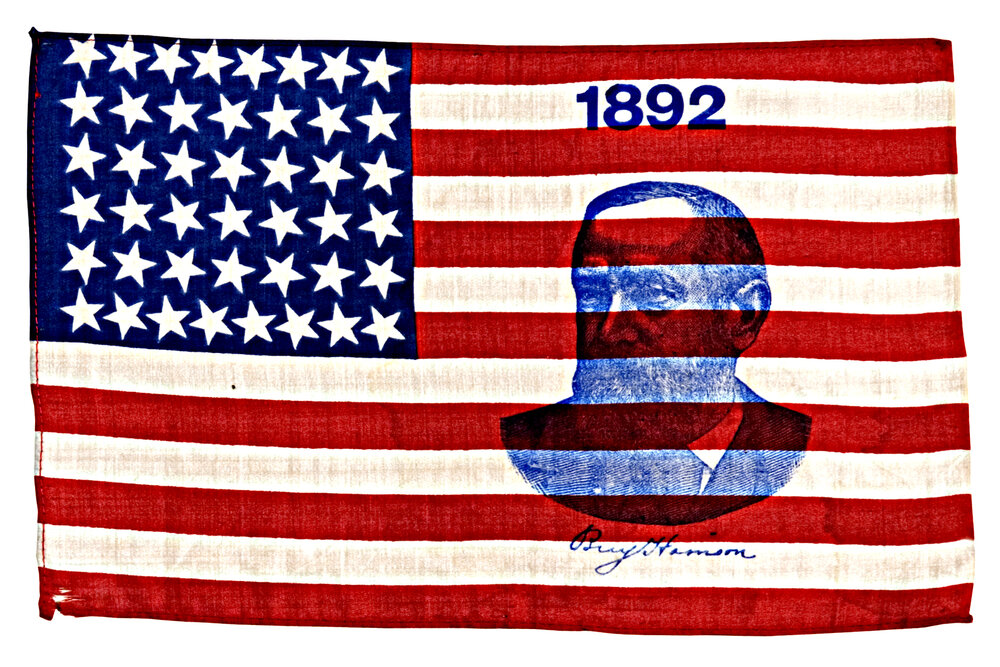
c. 1892
Printed on silk.
Image and facsimile signature of Benjamin Harrison superimposed with stamped 1892 date.
Benjamin Harrison, grandson of President William Henry Harrison, defeated Democrat incumbent Grover Cleveland in 1888 to gain the presidency even though Cleveland won the larger popular vote. Harrison received 90,000 fewer popular votes but carried the Electoral College 233 to 168. Four years later in the election of 1892, Cleveland handily defeated Harrison to regain the White House.
Following the Civil War, Harrison remained active in the Grand Army of the Republic (GAR) and was a strong proponent of veterans affairs. He served in the United States Senate from 1881-1887.
45-STAR MEMORIAL DAY FLAG
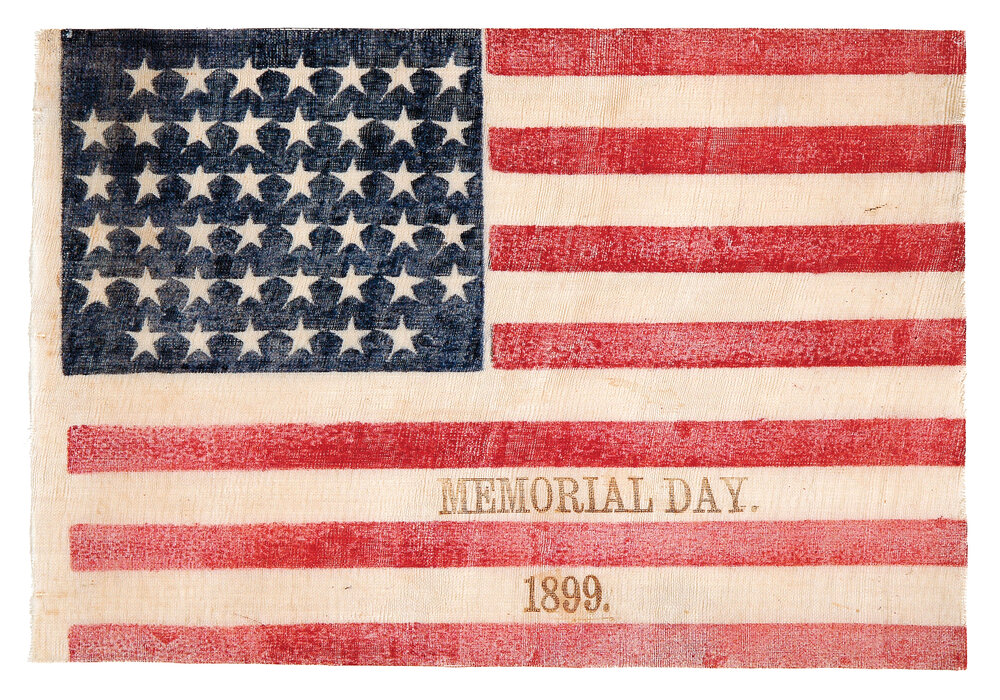
c. 1899
Printed on glazed cotton muslin.
Overprint: Memorial Day. 1899.
In 1865, Henry Welles, a druggist in Waterloo, New York, came up with an idea to designate a special day for townspeople to place wreaths and flowers on graves of Civil War soldiers in the town cemetery. Coincidentally, similar ceremonies honoring those who died in the Civil War were being held in other regions of the country.
Originally established as Decoration Day, in 1868 General John Logan, commander of the Grand Army of the Republic, proclaimed May 30th as a day to honor Civil War dead by placing flowers and wreaths on their graves in Arlington National Cemetery. After World War I, the annual ceremony was expanded to honor all armed forces personnel who died in America’s wars. Congress declared Memorial Day a national holiday in 1971 and changed the day of observance to the last Monday in May.
13-STAR ETTIE DUNN FLAG
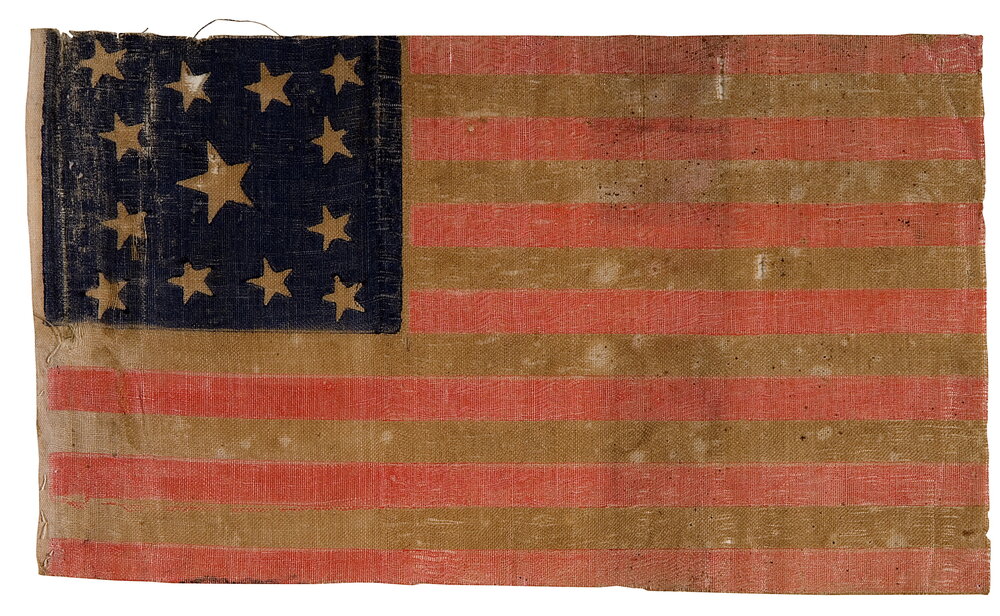
c. 1861-65
Printed on glazed cotton muslin.
Wreath pattern with central star, flanked by star in each corner.
Handwritten note: This flag was used by Miss Ettie Dunn during a Civil War troop rally in Erie PA for President Lincoln’s call for volunteers.
Within days after the Confederates fired on Fort Sumter, President Lincoln issued a proclamation ordering governors to detach a specified quota of men, aged 18-45, from their state militia to serve in the infantry for a period of three months. In Pennsylvania, Lincoln’s call for 75,000 volunteers attracted thousands more than could be accepted.
In the city of Erie, four days after the recruitment call, twelve hundred men from Erie, Crawford and Warren counties assembled to volunteer their service. The Erie Regiment was permitted to take only ten companies of seventy-five men each, so hundreds were turned away. The regiment’s tour of duty ended without seeing action. A few months later, there was another call to arms, and again more than one thousand men from these counties volunteered for service, this time for three years. These volunteers honorably served in the 83rd, 111th and 145th Pennsylvania regiments.
46-STAR RELIEF CORPS FUNERAL FLAG

c. 1980-12
Printed on silk.
Inscription on accompanying envelope and note card: This contains a little flag put away by mother. This flag was on the flowers sent by Relief Corps for my boy’s funeral and laid beside his dear still face till the coffin hid it from my eyes- Mother. May I see him in glory.
View envelope here & note here
The Women’s Relief Corps (WRC) is a patriotic organization with origins dating to 1869 in Portland, Maine. Within the ensuing decade, women in other states formed similar local aid societies, and in 1879 representatives from several of these groups met in Fitchburg, Massachusetts and founded the Women’s Relief Corps. In 1883 it was reorganized as an auxiliary branch of the Grand Army of the Republic.
Among its primary responsibilities, the WRC provides aid and comfort to all veterans and their dependents, extends needed assistance to their widows and orphans and assures them of sympathy and friends.
The sadness of a grieving mother is so fittingly captured on the note she wrote about her loss and her sentiment for the flag that was placed beside her son in honor of his military service to our country.
48-STAR AETNA HONOR ROLL FLAG
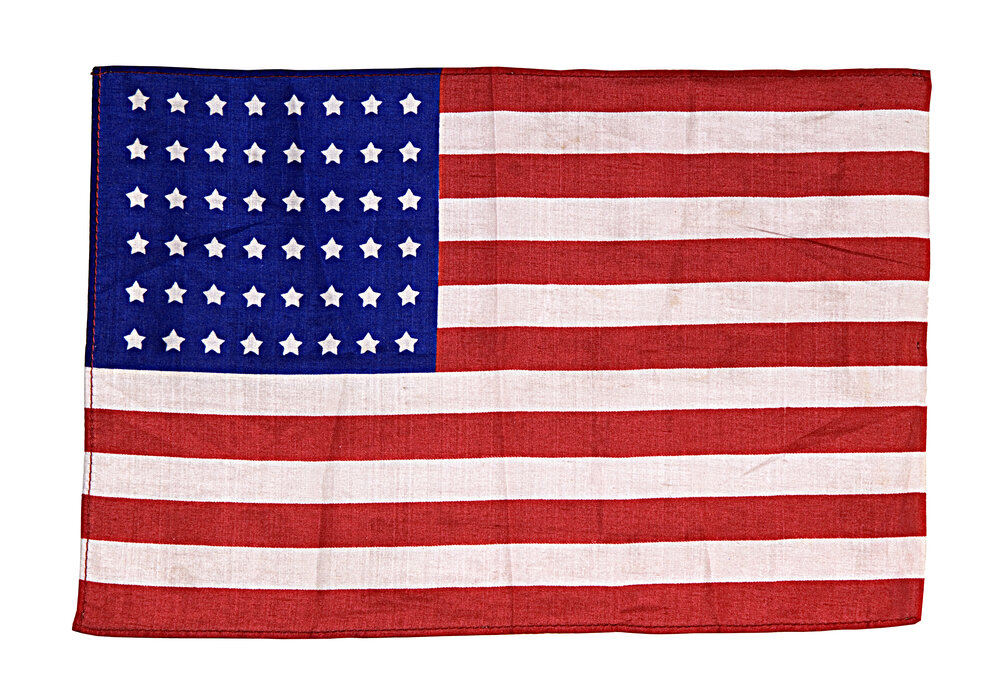
c. 1917
Printed on silk.
Patterned after the small flags that were proudly displayed in the windows of families with sons or daughters in the armed forces, “in service flags” were used by organizations and businesses to honor members who answered their nation’s call to duty during the First World War. These flags were large in size and sometimes flown on a pole or hung from the ceiling of a factory, office or meeting hall. A blue star for each person on active service was placed in the center of the red-bordered white rectangular flag, and by tradition, was replaced or covered with a gold star if a member died in action.
The service flag was originally designed by Army Captain Robert Queissner of the 5th Ohio Infantry who had two sons serving on the front line, and it quickly became the symbol of a family member in service.
This flag and brochure were distributed by the Aetna Insurance Company in appreciation for the sacrifices their employees were making as members of the military serving on active duty. The envelope in which the flag and pamphlet were enclosed is inscribed “Florence H. Grimshaw 1917.”
48-STAR PROBST PARADE FLAG
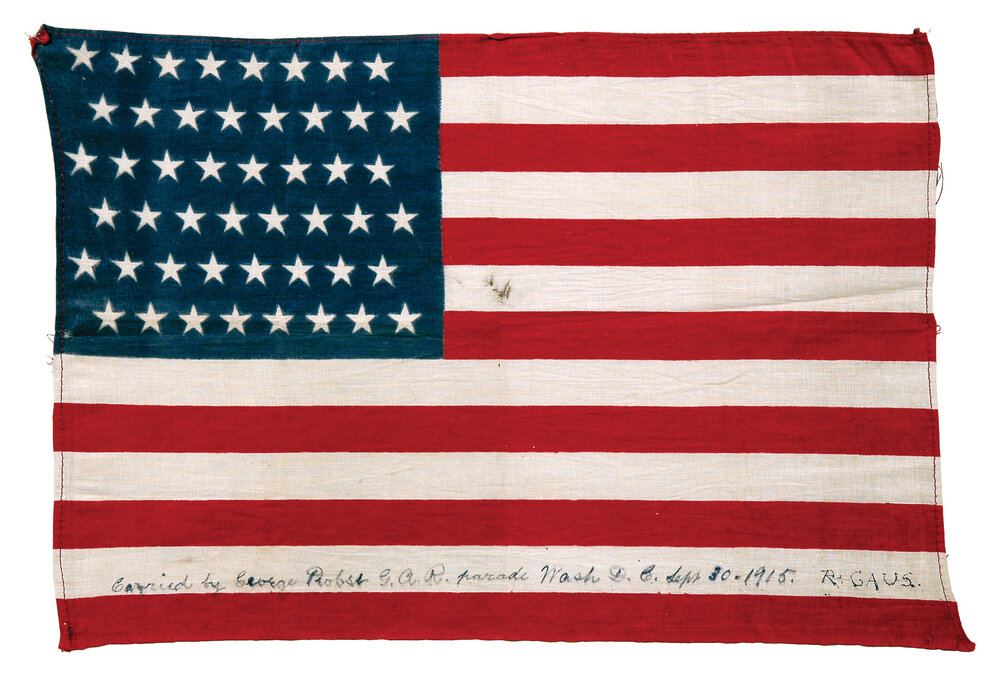
c. 1915
Printed on cotton.
Staggered pattern.
Inscription written on lower white stripe: Carried By George Probst G.A.R. Parade Wash D.C./Sept. 30, 1915 R. Gaus
Celebrating the 50th anniversary of the end of the Civil War, the Grand Army of the Republic marched from the Capitol to the White House passing in review before President Woodrow Wilson and receiving the plaudits of a quarter of a million people who lined Pennsylvania Avenue. There were 20,000 veterans in the long blue line, a small remnant compared to the number who marched before President Andrew Johnson a half century earlier.
America’s highest-ranking government and military officials as well as many diplomats and ambassadors from other nations were present to pay tribute to the “boys in blue.” In accordance with tradition, the procession was led by Illinois followed by the veterans of Pennsylvania, New York and other departments in regular order.
48-STAR PERSHING PARADE FLAG
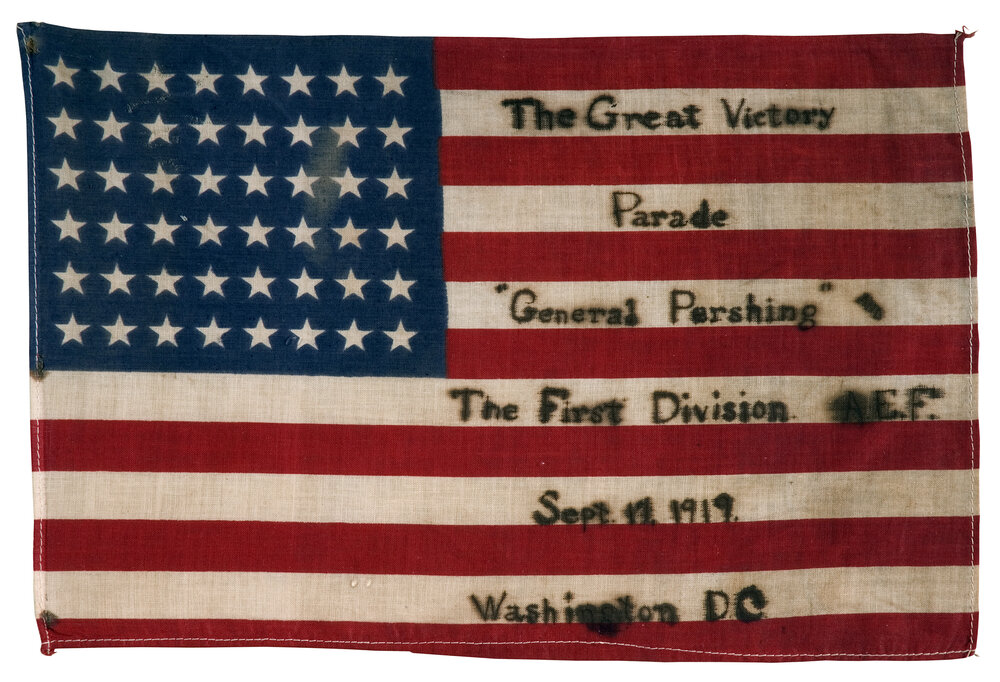
c. 1919
Printed on cotton.
Ink inscription: The Great Victory Parade “General Pershing” The First Division AEF Sept. 17, 1919 Washington DC
Born in Missouri in 1860, John J. Pershing graduated from West Point where he was commended for his high leadership skills and superb ability. Nicknamed “Black Jack,” he commanded the American Expeditionary Force during World War I and rose to the highest rank ever held in the United States Army- General of the Armies- equivalent only to the posthumous rank given to George Washington. In 1921, Pershing became U.S. Army Chief of Staff and served for three years in that position before retiring from active duty. He died in Washington in July 1948 and is buried in Arlington National Cemetery. Pershing was regarded as a mentor to a generation of Army generals who led U.S. forces in Europe during the Second World War, including George Marshall, Dwight Eisenhower, Omar Bradley and George Patton.
In the months following the end of World War I, parades were held in every city throughout America to honor our servicemen returning from Europe. On September 17, 1919, a National Victory Day Parade was held in Washington, D.C. with General Pershing riding on horseback leading the First Division down Pennsylvania Avenue. No official victory parade was held again in the nation’s capital until the end of Desert Storm in 1991.
45-STAR HOWELL POST GAR FLAG
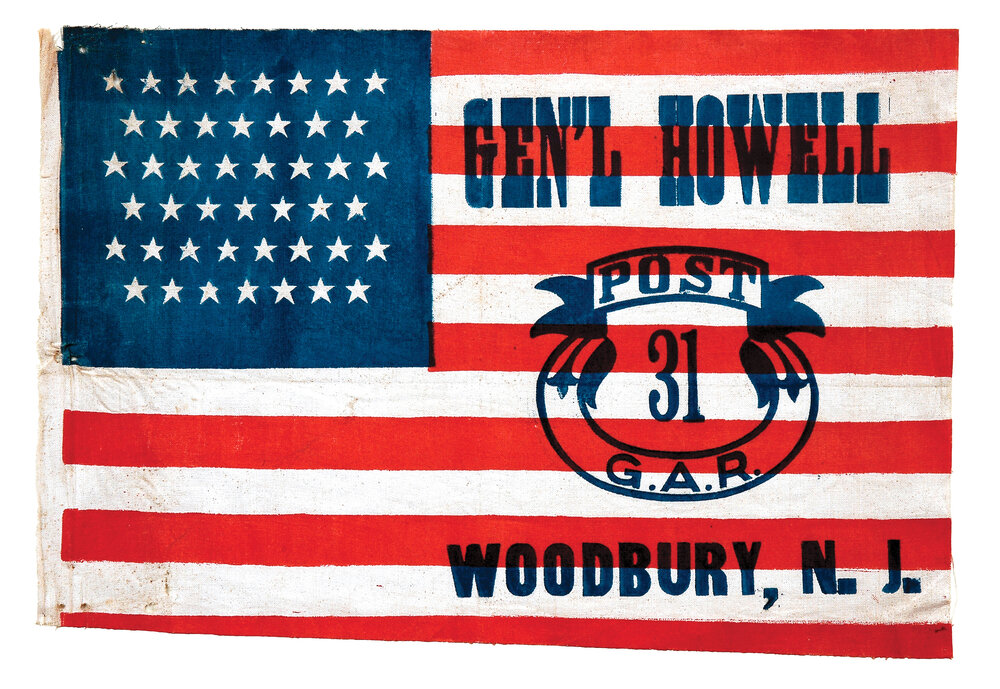
c. 1896-1908
Paint-printed on cotton.
Staggered pattern.
Printed inscription: Gen’l Howell Post 31 G.A.R. Woodbury, N.J.
Joshua Blackwood Howell was born near Woodbury, New Jersey on September 11, 1806. Educated at the University of Pennsylvania, he was a lawyer and served in the state militia prior to the Civil War. During the war, Howell served with the 85th Pennsylvania Regiment in the defense of Washington and later commanded the 1st Brigade, Army of the Potomac, at Charleston. He died September 12, 1864 from injuries resulting from a fall from his horse. His death occurred two days before the orders arrived promoting him to Brigadier General.
Howell’s great grandfather, John Ladd, was hired by William Penn in the late 1600’s to survey and assist in laying out the city of Philadelphia.
13-STAR THIRD MARYLAND FLAG
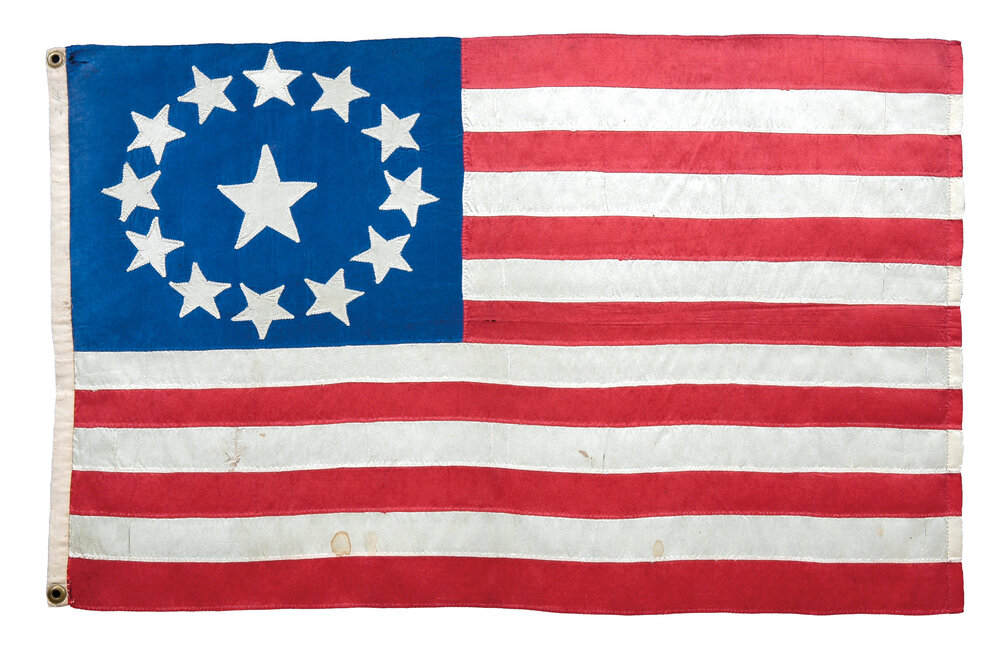
c. 1848-65
Hand-sewn silk with linen sleeve and appliquéd stars.
Wreath pattern with central star.
This design is often referred to as the Third Maryland pattern because it is believed to have been originally adopted by a regiment of Maryland soldiers at the Battle of Cowpens during the Revolutionary War.
42-STAR 7th ILLINOIS REUNION GUIDON
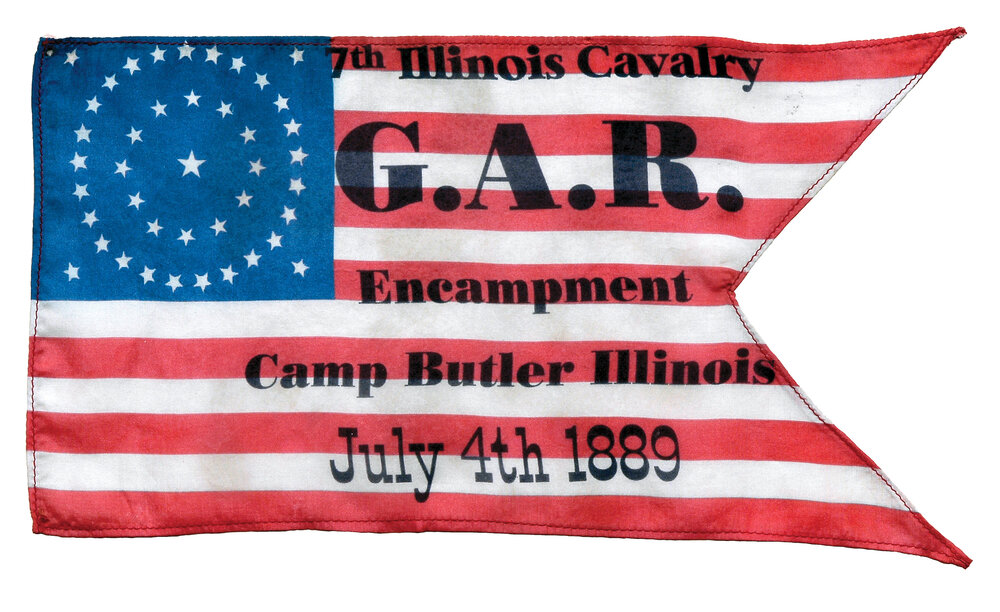
c. 1889
Reunion guidon printed on cotton.
Double medallion pattern with central star, flanked by star in each corner.
Stamped inscription: 7th Illinois Cavalry G.A.R. Encampment Camp Butler Illinois July 4th 1889
The 7th Illinois Cavalry organized at Camp Butler in October 1861 and mustered out in November 1865. During its three years of service, the regiment engaged in battles at Corinth, Franklin, Nashville and Vicksburg as part of the famous Grierson Raid, a decisive victory that helped General Grant secure the last Confederate stronghold on the Mississippi River.
This souvenir guidon commemorates the regiment’s twenty-fifth reunion encampment held at Fort Butler.
48-STAR BERLIN CONVOY FLAG
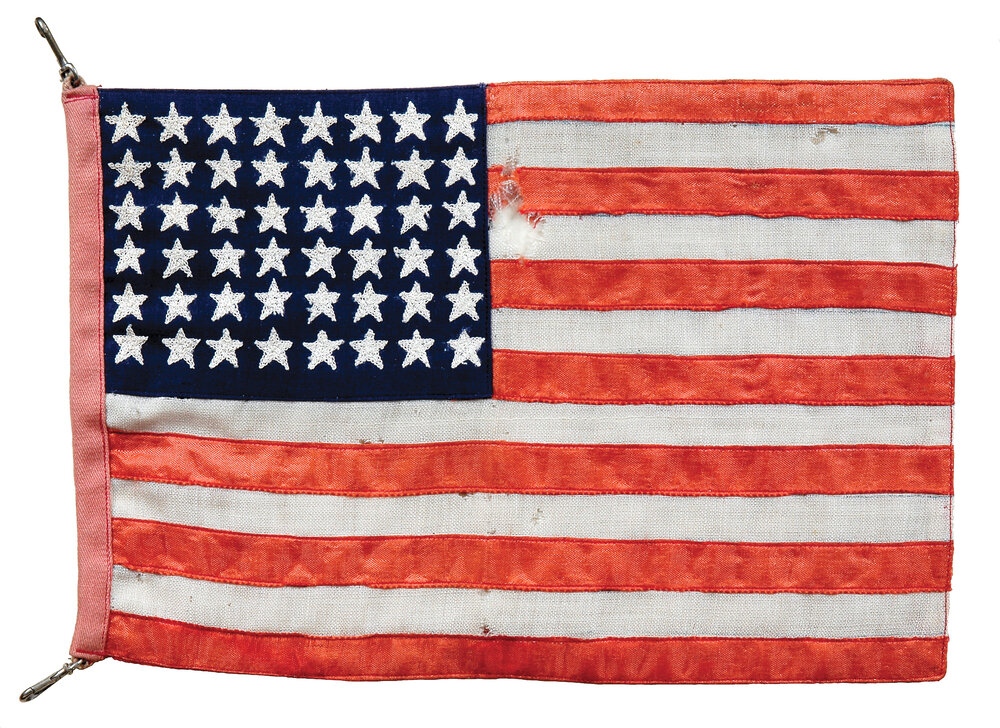
c. 1945
Machine sewn cotton and satin stripes with machine embroidered stars.
On June 23, 1945 a U.S. military convoy entered Berlin to take control of the American sector of the city. In honor of the occasion, flags hand made in the nearby town of Halle were specially ordered for convoy vehicles. Colonel John J. McGinnis, a field officer with the Army’s military government operations, saved one of the flags as a souvenir of the historic event. He later bequeathed his flag to the National Museum of American History where it became part of the Smithsonian Institution exhibit July 1942: United We Stand, The Flag In World War II.
This is another of the original flags that was among the first to enter Berlin following the end of the Second World War.
48-STAR VICTORY PARADE FLAG
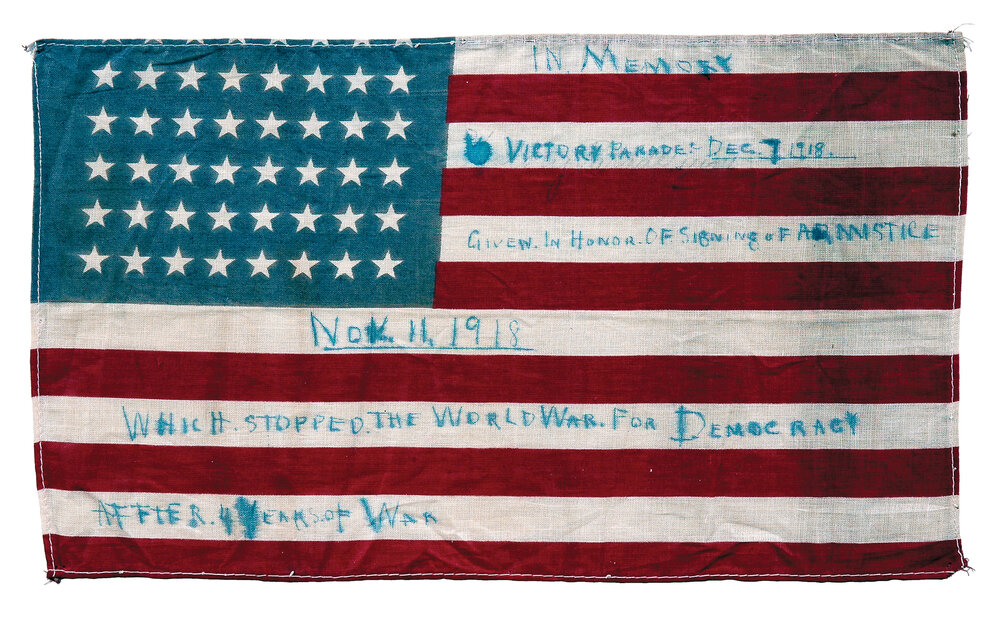
c. 1918
Printed on cotton.
Top red stripe removed.
Ink inscription: In Memory Victory Parade Dec. 7 1918 Given In Honor of Signing of Armistice Nov. 11, 1918 Which Stopped The World War For Democracy After 4 Years Of War.
The fighting in World War I ended on November 11, 1918, and in the months thereafter as our soldiers returned from Europe, parades were held in every city throughout America to honor their victory and to celebrate world peace. Large gatherings were highlighted by marching bands, the singing of patriotic songs and tributes to the soldiers, sailors and war workers for their efforts in winning the war and restoring democracy abroad.
48-STAR FOUR BROTHERS POST GAR FLAG
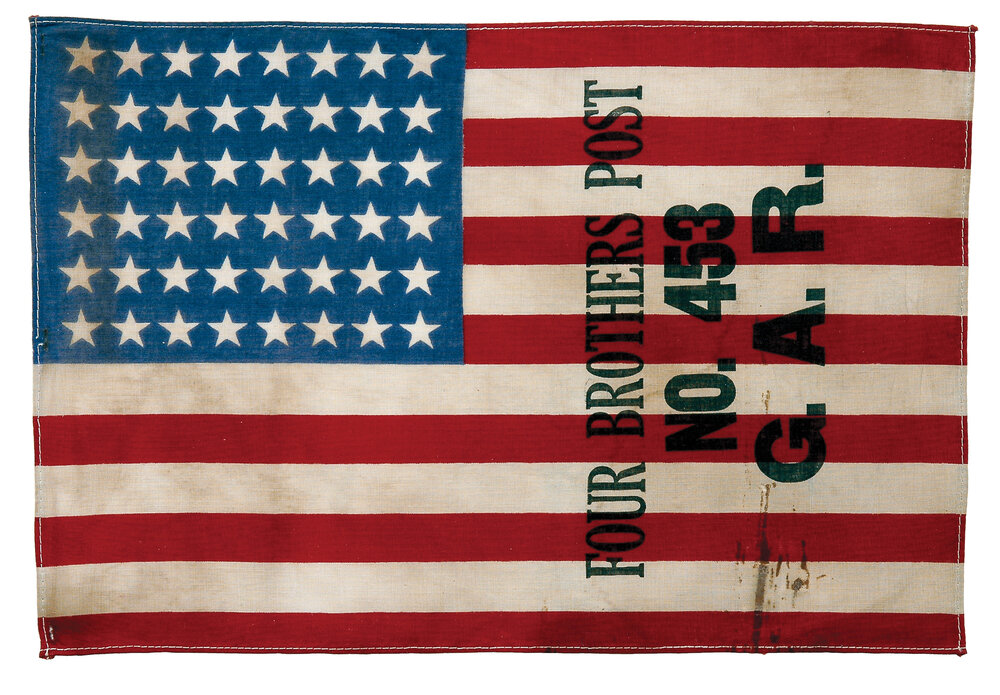
c. 1912-59
Printed on cotton.
Vertical stamped overprint: Four Brothers Post No. 453 G.A.R.
Four Brothers GAR Post 453, named in honor of the four Lyons brothers who served in the Civil War, was organized in Montrose, Pennsylvania on September 4, 1884.
Born to Nathan and Elizabeth Lyons, three of the brothers, Benjamin, Luke and Clark died during the war. The surviving brother, Captain Jerome Lyons, was discharged in October 1864 after three years of active duty service for wounds received in battle; he died three years later.
Jerome led the movement and was the architect who designed the Civil War Soldiers’ Monument erected on the green in Montrose in 1876. Monument Square, which lies between the courthouse and the County Historical Society, has four stone tablets on each side of the monument, each identifying a township in Susquehanna county with the names of the men who served in the Civil War.
33-STAR DECORATION DAY FLAG
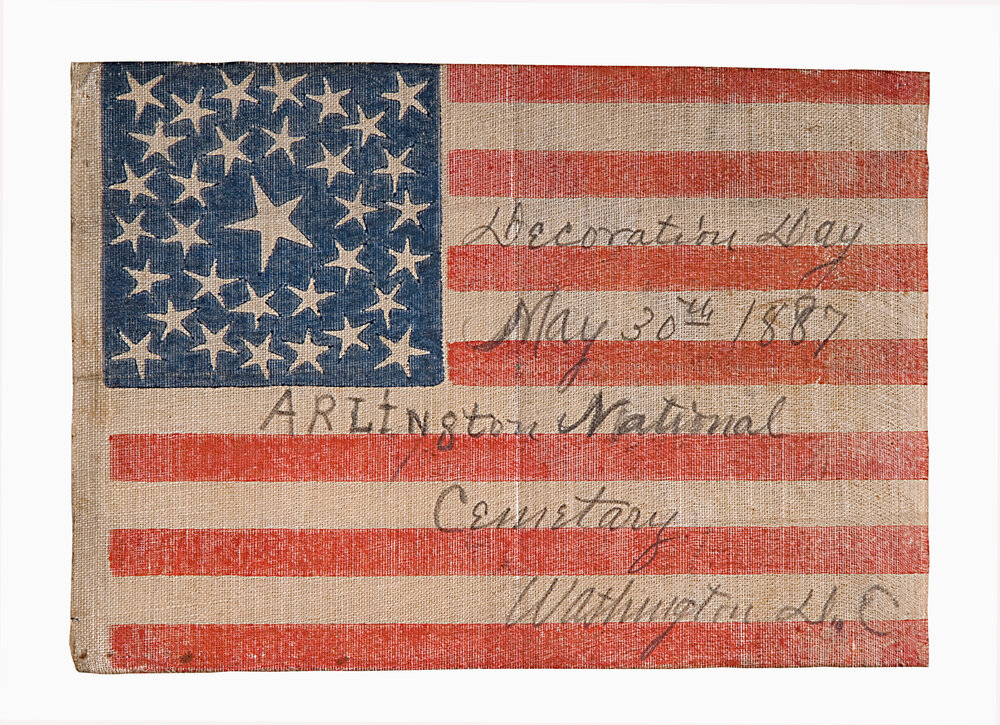
c. 1887
Printed on glazed cotton.
Double medallion pattern with central star, flanked by star in each corner.
Handwritten inscriptions: [Obverse] Decoration Day May 30, 1887/Arlington National Cemetary (sic) Washington, D.C./[Reverse] Arlington Heights Gen. R.E. Lee Old./May 30/87
The first national celebration of Decoration Day for the purpose of decorating the graves of comrades who died in the Civil War took place on May 30, 1868 at Arlington National Cemetery. This patriotic gesture honoring those who had fallen in battle helped reunite the country after a long and bitter war. In 1882, the Grand Army of the Republic (GAR) renamed this solemn holiday Memorial Day to recognize soldiers who fought in all American wars, and in 1971 federal law changed the observance to the last Monday in May.
Arlington National Cemetery is the most sacred place of burial for veterans of every war and conflict in American history. Since 1864, more than two hundred thousand burials have taken place in the more than six hundred acres devoted to America’s honored dead. Each year on Memorial Day, a wreath is placed at the Tomb of the Unknowns, and each grave is decorated with a small American flag.
34-STAR UNION SOLDIER BIBLE FLAG
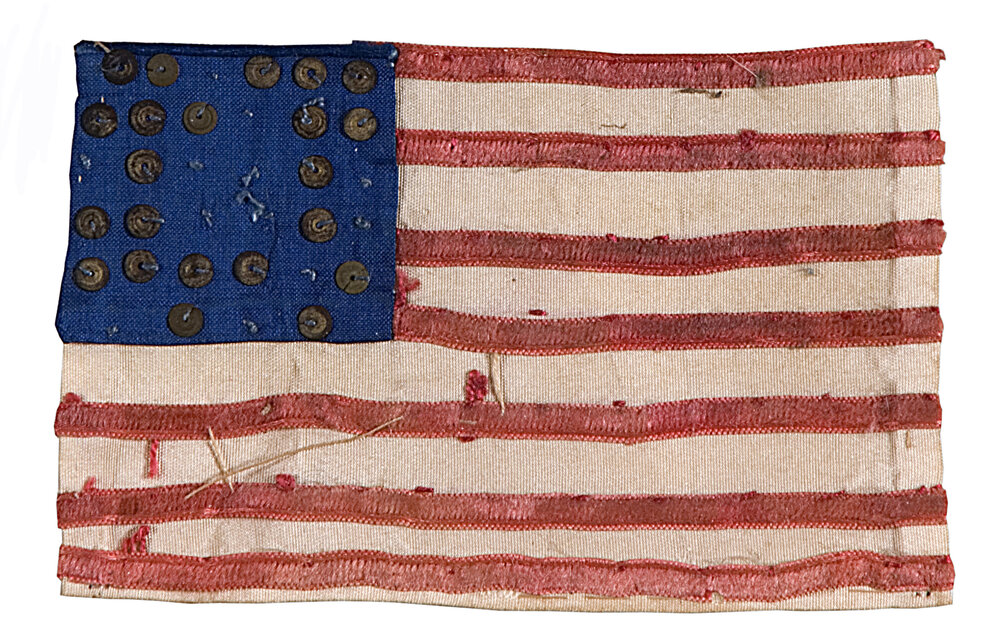
c. 1861-65
Hand-sewn silk ribbon stripes with sequin stars; red, white and blue silk page markers.
Often when a soldier left home to fight in the Civil War, a family member would sew a small flag which was given to him to use as a bookmark in the Bible he carried.
48-STAR 13th NEW YORK REUNION FLAG
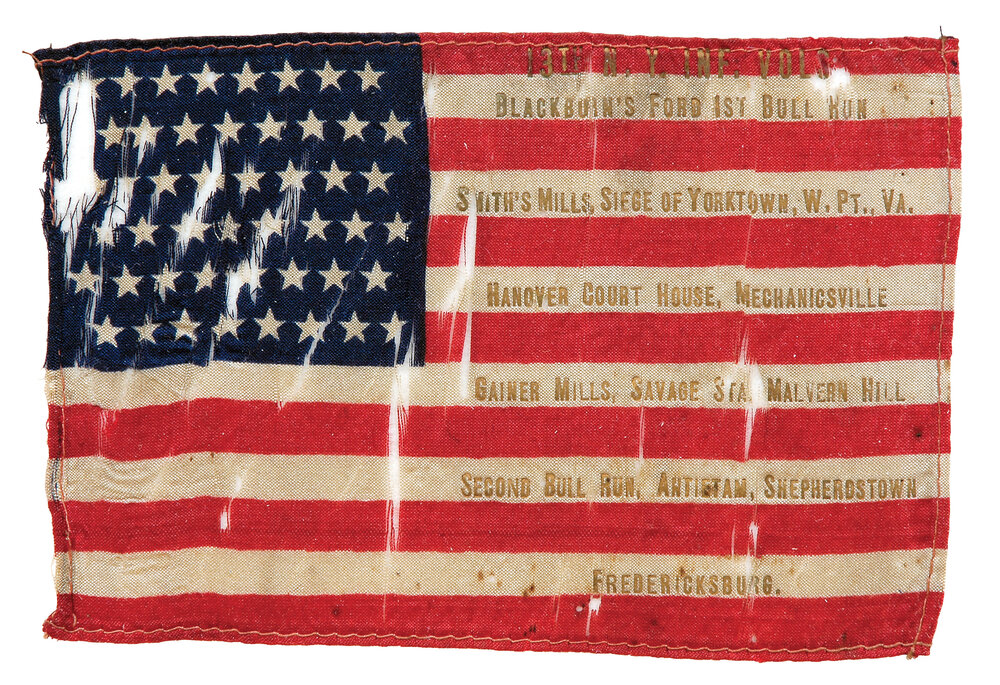
c. 1901-12
Printed on silk.
Staggered pattern.
Overprint stamped in gold: 13th N.Y. Inf. Vols. Blackburn’s Ford, 1st Bull Run Smith’s Mills Siege of Yorktown, W. Pt., Va. Hanover Court House, Mechanicsville Gaines Mills Savage Sta. Malvern Hill Second Bull Run, Antietam, Shepherdstown Fredericksburg
The 13th Infantry Volunteers, the “Rochester Regiment”, was organized at Elmira, New York under the command of Colonel Isaac Quinby in May 1861, and initially attached to Sherman’s Brigade and later to Porter’s Division, Army of the Potomac. The Regiment saw significant action as evidenced by the battle honors printed on the stripes of this reunion flag, date unknown. The unit suffered 450 casualties during its two years of active duty service before mustering out in May 1863.
45-STAR EDEN PARK FLAG
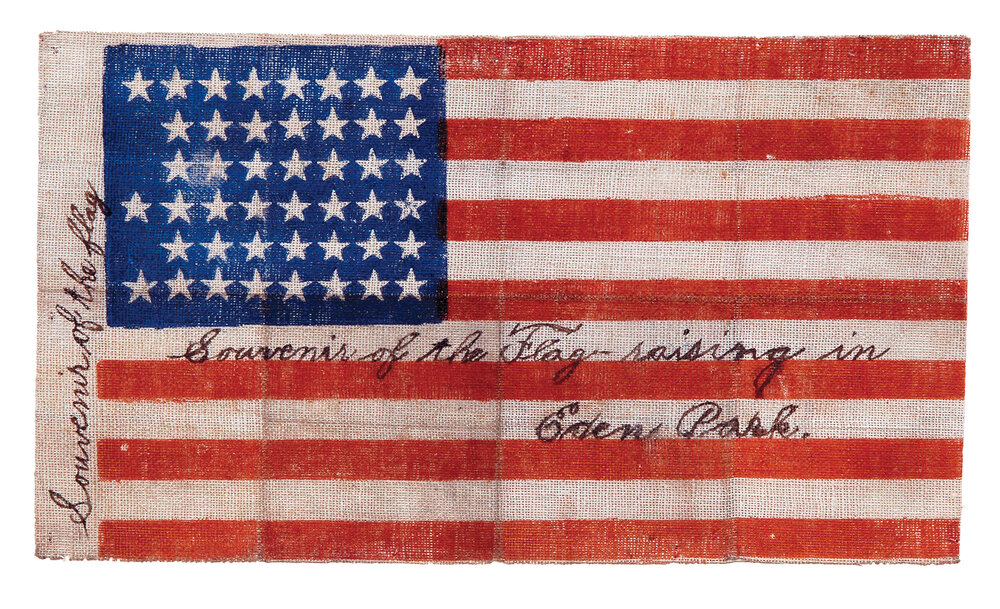
c. 1896-1908
Printed on glazed cotton muslin.
Notched pattern.
Handwritten inscriptions: Souvenir of the flag-raising in Eden Park (selvage): Souvenir of the flag
Eden Park was created in 1859 as part of Cincinnati’s municipal park system, and today it is the largest and most popular recreational facility, combining culture, city history and beautiful architecture. Named after the Garden of Eden, the park is home to the Cincinnati Art Museum, Playhouse in the Park and Krohn Conservatory.
Five memorial tree plantings are located throughout the park: the Presidential grove containing a tree planted for each U.S. President; heroes grove in memory of the 1776 patriots; a second heroes grove honoring Cincinnati men and women who lost their lives in World War I; pioneers grove with trees planted by the forestry service in honor of Cincinnati’s pioneers; and authors grove in memory of authors and statesmen. The water tower and Melan Arch Bridge, both completed in 1894, are two of the many architectural landmarks.
48-STAR BASEBALL GAME FLAG
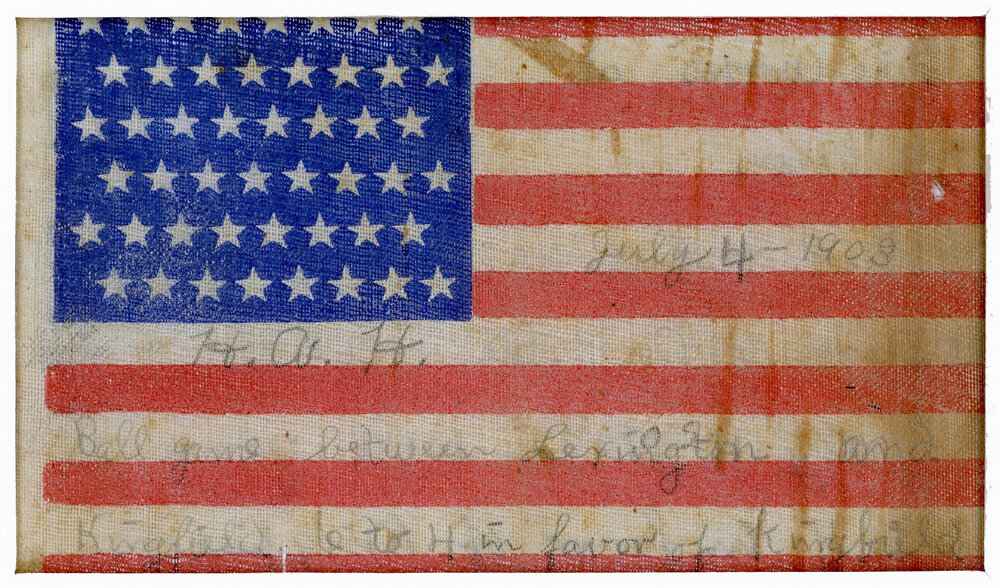
c. 1903
Printed on glazed cotton.
Staggered pattern.
Hand-written inscriptions on both sides of flag: [Obverse]: Fireworks at Harlows G.B.S. & S.A.W. H.A.H.& A.B.W. Went July 4, 1903. Ball game 6 to 4 in favor of Kingfield./[Reverse] July 4, 1903. H.A.H. Ball game between Lexington & Kingfield 6 to 4 in favor of Kingfield.
Since the earliest days of the republic, Americans have observed the anniversary of our nation’s independence as a major holiday and an important time for celebration. Many of today’s Fourth of July traditions- fireworks, parades and games- have their roots in local customs dating back to the post Revolutionary War period.
The written notations on this flag recount the July 4 fireworks celebration and baseball game most likely played between the neighboring towns of Kingfield and Lexington, Maine at the Harlow family farm in 1903.
13-STAR CENTENNIAL FLAG

c. 1876
Nine hand-sewn satin ribbon stripes with multi-pointed embroidered stars in scatter pattern.
The popularity of the flag greatly increased during the nation’s centennial celebration in 1876. A variety of original, handmade examples like this one were created in tribute to the Stars and Stripes and to the spirit and birth of America one-hundred years earlier.
